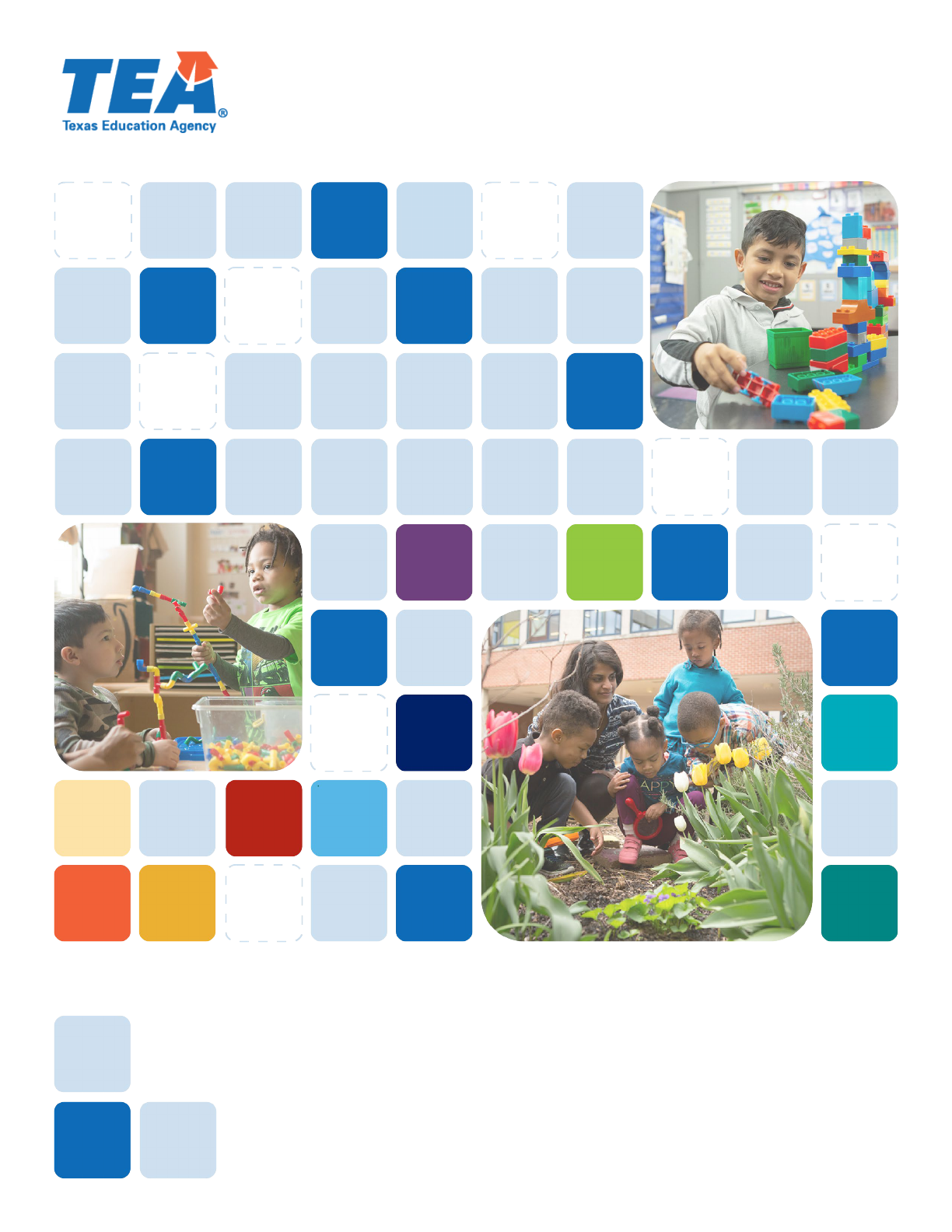
2022 Texas Prekindergarten Guidelines
2022 Texas Prekindergarten Guidelines
PK3 and PK4 Comprehensive Guide

2
Table of Contents
2
Table of Contents
Introduction
i. Guiding Principles | 3
ii.
Inclusive Practices | 4
iii
. Organization of the Prekindergarten Guidelines | 6
Domains and Skills
I. Socia
l and Emotional Development | 9
II. Emergent Literacy: Language and Communication | 19
III. Emergent Literacy: Reading | 28
IV. Emergent Literacy: Writing | 42
V. Mathematics | 48
VI. Science | 59
VII. Social Studies | 65
VIII. Fine Arts | 71
IX. Physical Development | 75
X. Technology | 79
App
endix | 82
Phonological Awareness Development Timeline
Writing Development

Introduction
3 3
Introduction
The Texas Prekindergarten Guidelines have been developed to provide guidance for planning quality
learning experiences for all children three to five years of age. They are based on current knowledge of
theory and scientific research about how children develop and learn. The guidelines reflect the growing
consensus among early childhood professional organizations that a greater emphasis should be placed
on young children’s conceptual learning, acquisition of basic skills, and participation in meaningful,
relationship-based learning experiences.
The Tex
as Prekindergarten Guidelines include multiple domains of learning, each with a broad range of
skill development. The intent of this document is to help prekindergarten programs identify the
essential foundational learning skills that will help children from all backgrounds, experiences, and levels
of development to be successful.
The Texas Prekindergarten Guidelines were designed to help educators identify the types of knowledge
and skills that are typical of prekindergarten aged children. It is important to note that there is
considerable variability in development among children that is influenced by their individual and unique
experiences. Responsive to this variability, the Texas Prekindergarten Guidelines are not intended as a
rationale to either accelerate or postpone instruction; instead, they define the outcomes as to which
children are able to reach or move towards. In addition, they are intended to help educators better
understand how they can provide effective instructional practices and learning experiences that support
these important early learning outcomes. The Texas Prekindergarten Guidelines also directly align with
the Texas Essential Knowledge and Skills (TEKS), to ensure that all children in Texas receive equitable
learning experiences and are ready for kindergarten.
The Texas P
rekindergarten Guidelines are intended for use by all those who support young children’s
learning including school districts, Head Start programs, childcare programs, and, most importantly,
children’s families. They are designed as a resource to help educators and administrators make informed
decisions that pertain to curriculum and instruction. Aligning intentional instructional practices and
opportunities for play, exploration, discovery, and problem-solving with the learning outcomes
described in the Texas Prekindergarten Guidelines will promote successful learning for all children.
Guiding Principles
The Guiding Principles that align to the purpose of the Texas Prekindergarten Guidelines include the
following:
1. Each child is unique and can succeed at their optimal level with appropriate support. Children
can be successful learners and achieve the outcomes outlined in these guidelines.
2. Children are capable and competent, regardless of their levels of development. Teaching should
be responsive to the individualized needs of each child.
3. All young children learn and thrive in the context of secure, caring, responsive, and stimulating
relationships as they explore the world around them.

Introduction
4 4
4. Children learn best when their social, emotional, physical, and cognitive needs are met and
nourished within their environment.
5. Families are children's primary caregivers, teachers, and advocates. All families must be
respected and encouraged in their efforts to support their child's learning.
6. Young children flourish when their experiences integrate multiple areas of development and are
built on prior knowledge.
7. Effective teaching practices are intentional and build on children’s intrinsic strengths and
interests by providing developmentally appropriate instruction that incorporates many
opportunities for interactive experiences, exploration, meaningful play, and problem-solving.
8. Every child has diverse strengths rooted in their family's culture, background, language,
traditions, and beliefs. Responsive and respectful learning environments welcome children from
all cultural and linguistic backgrounds. Effective teaching practices include learning
opportunities that build on the unique experiential backgrounds and prior knowledge of each
child.
9. Children demonstrate growth in many ways. The systematic monitoring of children’s progress
plays a vital role in revealing a child’s prior knowledge, concept development, and
understanding of the world around them.
10. Teaching and learning are dynamic, integrated, and include reciprocal processes. Children build
awareness and knowledge through play, exploration, inquiry, and application. Skill development
occurs when children are provided with multiple opportunities for practice, reflection, and
intentional feedback
.
Inclusive Practices
Multilingual Learners
The Texas Prekindergarten Guidelines employ the term multilingual learner to capture the spectrum of
language learners in Texas schools. This term is inclusive of students from two or more language
backgrounds as well as native English speakers participating in a two-way dual language immersion
program. Whether students qualify as English learners or not, the multilingual aspect of their
background includes culture and traditions that may be different than that of school culture in the
United States. The uniqueness of these students should be leveraged as an asset to the culture of the
classroom.
The T
exas Administrative Code §89.1210 describes the program content and design of English as a
Second Language (ESL) and bilingual programs. English learners may be enrolled in an ESL program, a
transitional bilingual education program, or a dual language immersion program model.
In ESL programs, English learners receive linguistically and culturally responsive teaching from an ESL
certified teacher to attain full proficiency in English and to participate equitably in school.
In Tr
ansitional Bilingual Education programs (TBE), English learners receive instruction in literacy and
academic content in their primary language as well as English from teachers certified in bilingual

Introduction
5 5
education. As each child acquires English, the amount of instruction provided in the primary language
decreases until full proficiency in English is attained. Early Exit and Late Exit models are both provided
throughout the duration of elementary grades with differences in the rate of transition to English
proficiency.
In dual language immersion programs (DLI), participants receive instruction in literacy and academic
content in the program’s partner language (i.e., Spanish, Vietnamese) as well as English from
appropriately certified teachers. At least half of the instruction is delivered in the partner language for
the duration of the program. One-way models serve English learners only but include participation of
former English learners who are continuing after reclassification. Two-way models include English
learners as well as participation of English proficient students learning the partner language.
Regardless of program participation, children's current strengths, skills and experiences are assets that
serve as the foundation upon which new knowledge is built. During the prekindergarten year(s),
multilingual learners can receive the message that they are valuable just as they are, full of ideas,
preferences, and potential. The prekindergarten classroom is where this seed will be planted as teachers
address the unique strengths of both linguistic and cognitive needs of these children.
Children with Disabilities
Under the Individuals with Disabilities Education Act (IDEA), children with disabilities are entitled to a
free appropriate public education (FAPE) in the least restrictive environment (LRE). Children with
disabilities who receive special education services must be provided with opportunities to learn and
make progress in the general education curriculum available to all children, and to the greatest extent
possible, alongside their non-disabled peers to allow all children to reach their full potential. The
Admission, Review, and Dismissal (ARD) committee determines the LRE for children who receive special
education and related services. The LRE is based on the child’s individualized education program (IEP).
Once the ARD committee has identified the child’s strengths and needs, they consider a continuum of
services and supports to ensure the child with a disability has equal access to meaningful participation in
the general education curriculum through the development of the IEP.
Three a
reas have been identified as critical for ensuring a child can meaningfully participate in school
and society. For children with disabilities to be fully included in school and to ultimately achieve a high-
quality of life, they need opportunities to:
• Develop positive social-emotional skills, including enjoying successful social relationships with
peers and adults, expressing emotions, managing self-concepts and self-control, learning about
empathy and the perspective of others, and following rules and expectations.
• Acquire and use knowledge and skills, including early language and communication, thinking and
problem-solving, imitation, use of symbols, and early literacy.
• Use appropriate behaviors to meet their own needs, including adaptive or self-help skills such as
toileting, feeding oneself, and practicing safety.
(Early Childhood Technical Assistance Center (ECTA)
For
children with special needs, expectations for meeting the Texas Prekindergarten Guidelines student
outcomes requires thoughtful consideration by a team, which includes the child’s family and other

Introduction
6 6
identified professionals. For instance, some children can be expected to work toward the same level
outcomes as their typically developing peers. Other children may be able to meet these outcomes with
adaptations in materials or instructional strategies. Some children may require modified goals.
Regardless, it is important not to make assumptions about a child’s ability to meet the outcomes in each
domain without conducting a careful appraisal of the individual child's capabilities and needs. If the child
has an existing IEP, it should be carefully reviewed to determine which student outcomes from the Texas
Prekindergarten Guidelines are possible for the child to work toward without modifications or
accommodations and which are attainable with some accommodations, and/or modifications. Decisions
resulting from this process should be documented in writing per the IEP, so that all members of the ARD
team are clear about how the child’s needs will be met, what types of accommodations and
modifications will be made in different domains, and how the child’s educational goals will align with the
student outcomes described in Texas Prekindergarten Guidelines.
Note:
Removal from the general education classroom should occur only if the use of supplementary aids
and services do not permit the child to achieve success. Research indicates that early childhood inclusion
is beneficial to children with and without disabilities in reaching their full potential and result in broad
societal benefits, including higher productivity in adulthood and fewer resources spent on interventions
and public assistance later in life (Policy Statement on Inclusion of Children with Disabilities in Early
Childhood Programs, U.S Department of Health and Human Services, U.S. Department of Education,
September 14, 2015).
Organization of the Prekindergarten Guidelines
The Texas Prekindergarten Guidelines are organized into the following categories: Domains, Skills,
Outcomes and Child Behaviors.
Domains: The d
omains are broad areas of early learning and development from birth to 5 years that are
essential for school and long-term success. The Texas Prekindergarten Guidelines are organized into ten
domains:
I. Social and Emotional Development
II. Emergent Literacy: Language and Communication
III. Emergent Literacy: Reading
IV. Emergent Literacy: Writing
V. Mathematics
VI. Science
VII. Social Studies
VIII. Fine Arts
IX. Physical Development
X. Technology
Skills: The skills are specific components of development within the domain. Although the Texas
Prekindergarten Guidelines are organized into specific domains of learning, and each domain is
comprised of skills, the intent is not to suggest that children’s skills develop separately or apart from
each other. Nor is it the intent that isolated skill instruction be used as an appropriate way to support
learning during the prekindergarten years. The Texas Prekindergarten Guidelines are based on the
premise that learning occurs on a continuum and that developmental domains are highly interrelated.
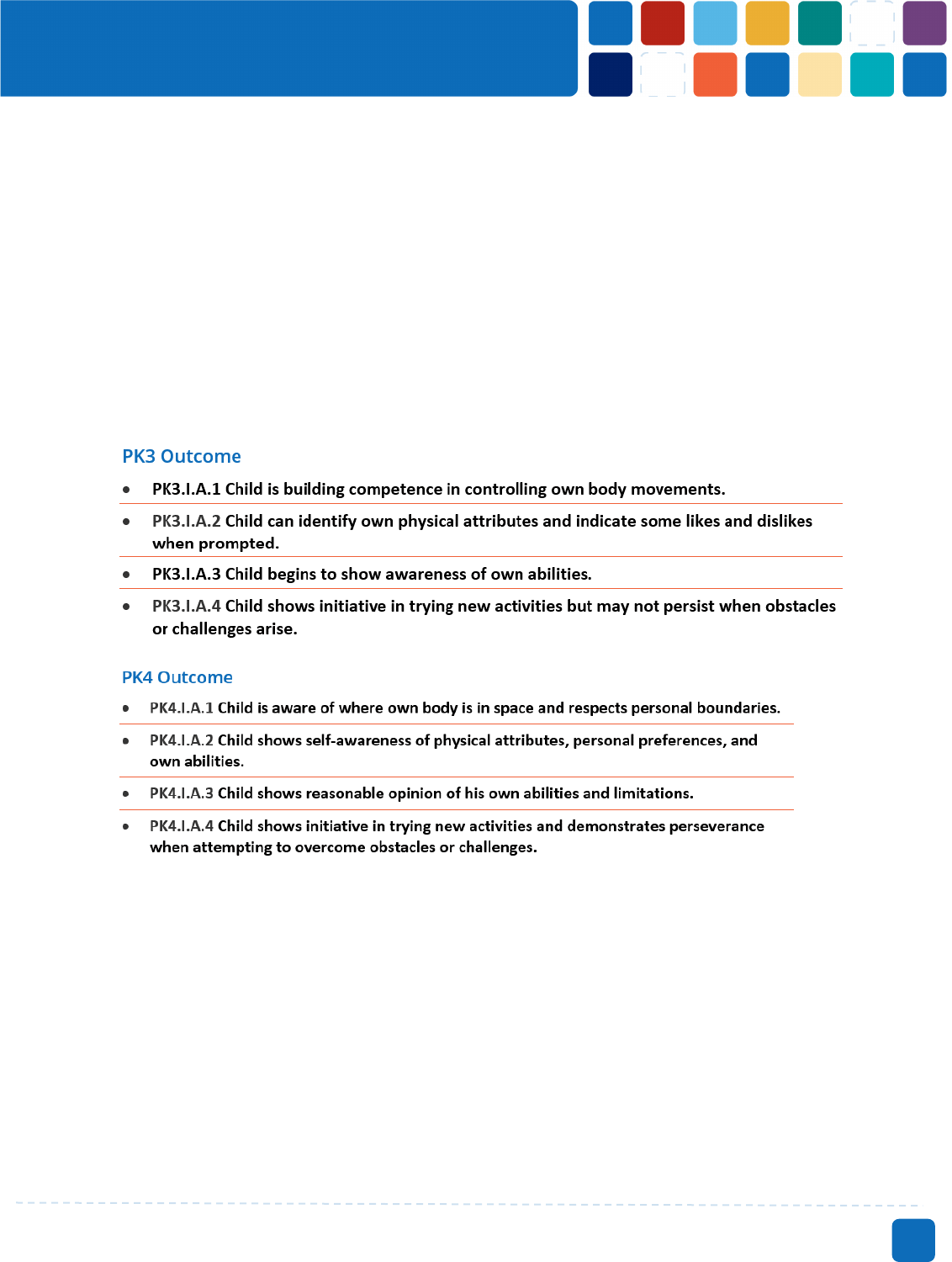
Introduction
7 7
Children succeed to their highest potential in nurturing environments that support their learning across
all domains.
Outcomes: The outcomes are statements of end-of-year expectations of learning and development for
children 48 months (PK3) and 60 months (PK4) of age. They describe specific, observable skills,
behaviors, and concepts that children should know and be able to do at the end of prekindergarten.
Given children’s individual differences, some children may demonstrate these indicators sooner, and
some may demonstrate them later. The indicators listed for each age are not exhaustive.
Outcomes are numbered in the following manner:
• Student a
ge is identified by “PK3” (up to 48 months) or “PK4” (up to 60 months).
• Learning domains are indicated with Roman numerals.
• Within each domain, separate skills are listed with an alphabetic indicator.
• Under each skill, the outcomes are then numbered sequentially.
The child outcomes are:
• COMPREHENSIVE–Cover the central domains of early learning and skills children need to succeed in
school and provide sufficient scope and depth in each area.
• INCLUSIVE–Relevant for children with varying ability levels and diverse linguistic, economic, and
cultural backgrounds.
Six domains (Social and Emotional Development, Emergent Literacy: Language and Communication,
Emergent Literacy: Reading, Emergent Literacy: Writing, Mathematics, and Physical Development)
include outcomes for both PK3 and PK4. Four domains (Science, Social Studies, Fine Arts, and
Technology) do not include PK3 student outcomes as there is not sufficient research to clearly define
typical behaviors of three-year-old children related to these skills. This does not mean that children of
this age group should

Introduction
8 8
not participate in the experiences related to the learning outcomes, but rather, the focus should be on
engaging three-year-old's in the beginning stages of exploration of these concepts. This exposure will
support children to develop a solid foundation of understanding, which will allow them to build and
deepen their knowledge as they continue to learn and grow.
Child Behaviors: The child behaviors are examples that explain the competency of the outcome. The
behaviors are not exhaustive of what a child may be able to demonstrate, rather they are behaviors that
a child may demonstrate towards competency of the outcome.
Ultimately, the Texas Prekindergarten Guidelines are not intended to be used as a curriculum,
assessment tool or checklist. They are not meant to be used in isolation, or to stifle the creativity of
caregivers and educators. Rather, they are meant to serve as a resource for families, educators, and
administrators to provide developmentally appropriate guidance and practices around young children’s
development and learning in the prekindergarten environment.

Social and Emotional Development
9
I. Social and Emotional Development Domain
I. Social and Emotional Development Domain
While a prekindergarten education should include activities that strengthen cognitive skills, it must also
provide for the development of the social and emotional competencies required for school readiness
and success in life. The development of these personal and social skills enables children to build a sense
of who they are and what they can do. Supportive, positive relationships between teachers and children
are essential to implementing effective practices that support a child’s social and emotional
development. Children must establish positive relationships with adults and peers to participate
effectively in the classroom community, assert independence in appropriate ways, and accomplish tasks
that are meaningful to them without infringing on the rights of others. Children who can follow
directions, communicate their wants, and needs effectively, and get along with other children are better
prepared for kindergarten and beyond.
Early experiences influence brain development by establishing the neural connections that provide the
foundation for language, reasoning, problem solving, social skills, behavior, and emotional health. Daily
experiences such as transitioning from home to school, sharing a space or materials, resolving conflicts,
and demonstrating empathy contribute to a child’s social and emotional development. However,
children benefit from direct instruction and repeated opportunities to practice these skills.
The Social and Emotional Development Domain of the Texas Prekindergarten Guidelines is divided into
the following skills: self-concept, self-regulation, relationships with others, and social awareness.
A. Self-Concept
Central to understanding emotional development is the idea of self-concept: an ever-increasing level of
conscious awareness of one’s feelings, thoughts, abilities, likes, and dislikes, as well as awareness of
one’s body in space. Prekindergarten children’s emerging ability to perceive these aspects of themselves
at a conscious level distinguishes them from toddlers, who lack such awareness. Children begin to
generate multiple answers to the question “Who am I?” which is an essential aspect of becoming
competent in related areas, such as self-control and social/friendship skills. A child’s identity includes
cultural and linguistic factors, and the prekindergarten environment is one of the first public
opportunities for children to recognize the uniqueness of their own home culture and language as well
as accept and value cultures and languages different from their own. Early childhood educators must
model the mindset of diversity as an asset in the classroom, school, and community.
PK3 Outcome PK4 Outcome
PK3.I.A.1 Child is building competence in
controlling own body movements.
PK4.I.A.1 Child is aware of where own body is in
space and respects personal boundaries.
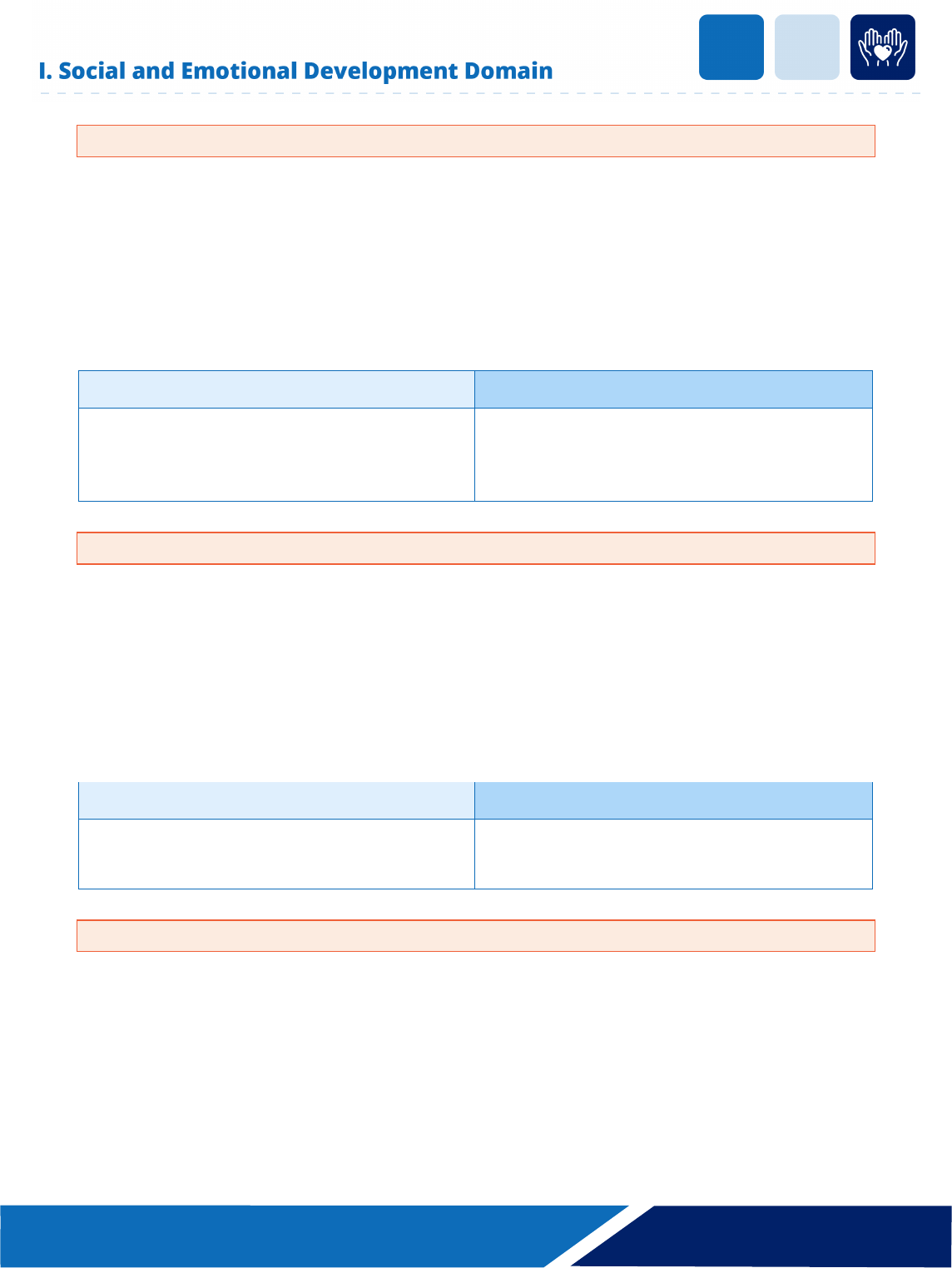
Social and Emotional Development
10
Child Behaviors
The child may:
• stay in designated personal spaces without intruding upon others (e.g., stays in own seat at
lunch table without kicking feet or leaning against neighboring children or stays seated on
assigned space during whole group instruction without distracting others)
• move around the classroom without stepping on materials or disrupting others’ activities
• maintain appropriate personal space when speaking with others
PK3 Outcome
PK4 Outcome
PK3.I.A.2 Child can identify own
physical attributes and indicate some likes and
dislikes when prompted.
PK4.I.A.2 Child shows self-awareness of physical
attributes, personal preferences, and own abilities.
Child Behaviors
The child may:
• use basic physical characteristics to describe self (e.g., hair color, eye color, or height)
• identify with a group or groups to which they belong (e.g., race/ethnicity, speaker of another
language, family member, classroom group)
• use personal inclinations to describe self (e.g., favorite color, food, or game)
• use specific competencies to describe self (e.g., “I can tie my shoes.” or “I am good at drawing.”)
PK3 Outcome PK4 Outcome
PK3.I.A.3 Child begins to show awareness of own
abilities.
PK4.I.A.3 Child shows reasonable opinion of his
own abilities and limitations.
Child Behaviors
The child may:
• choose to use the stairs instead of the climbing rope on the playground
• request help from adults when appropriate
• decline help politely when not needed (e.g., “No thanks, I can do it myself.”)
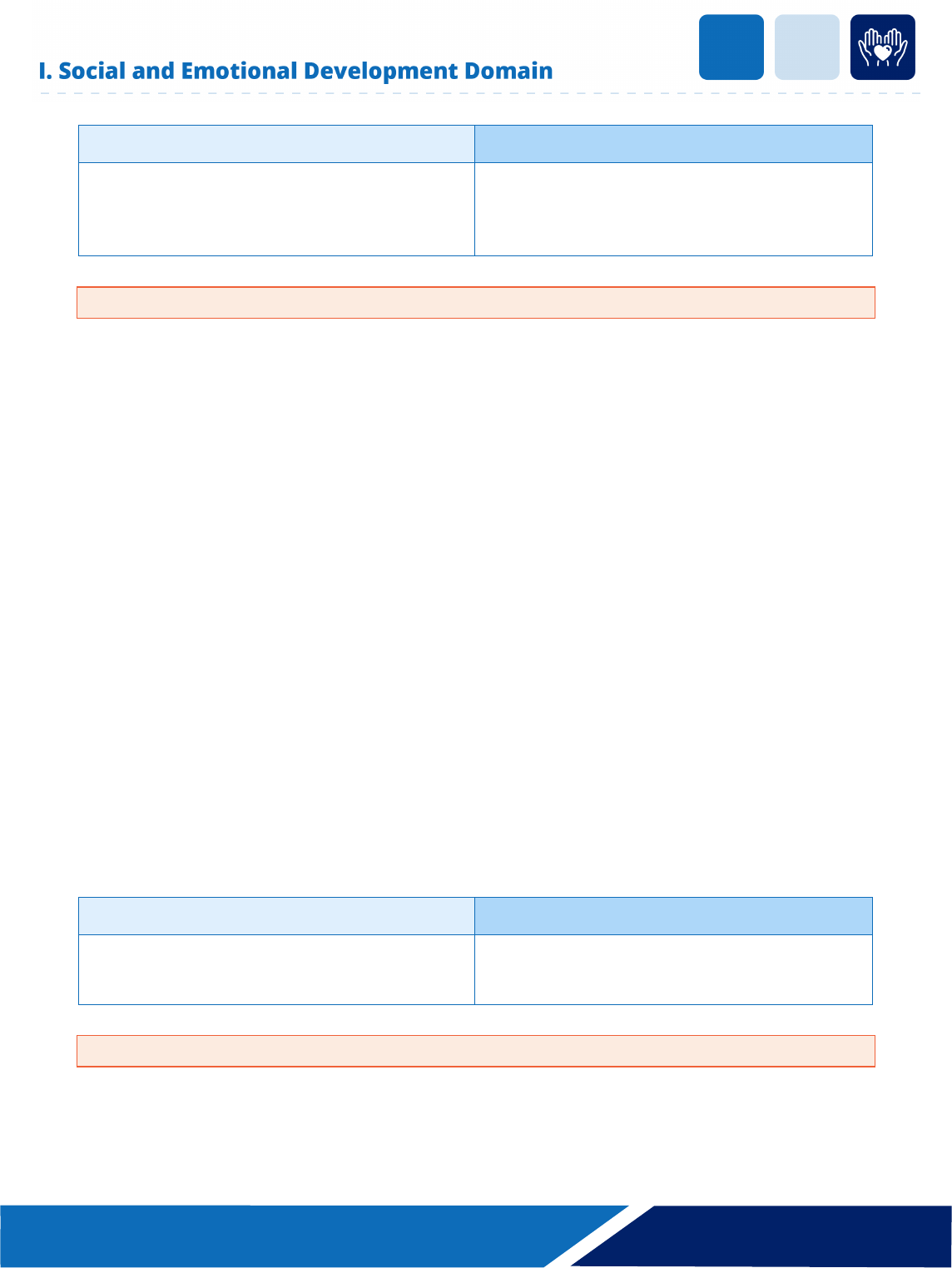
Social and Emotional Development
11
PK3 Outcome
PK4 Outcome
PK3.I.A.4 Child shows initiative in trying
new activities but may not persist when obstacles
or challenges arise.
PK4.I.A.4 Child shows initiative in trying new
activities and demonstrates perseverance when
attempting to overcome obstacles or challenges.
Child Behaviors
The child may:
• independently select a new book or game in a learning center
• work on a puzzle until it is complete
• try several strategies to solve a problem before seeking adult assistance (e.g., when a crayon
breaks, the child replaces the broken crayon with a new crayon instead of raising their hand to
tell the teacher)
B. Self-Regulation
Prekindergarten children feel safer and function more successfully in the classroom when rules and
routines are consistently implemented. A well-organized classroom with well-prepared activities helps
children expand their attention span and build self-control and personal responsibility. As they
encounter and overcome new and various social obstacles when interacting with peers, guidance from
teachers will enable them to learn acceptable ways of dealing with social and emotional stress and/or
excitement.
Self-regulation skills include three subskills: behavior control, emotional control, and control of
attention. Subskills only appear in this section of the Texas Prekindergarten Guidelines and are
represented by a lowercase letter at the end of the citation.
1. Behavior Control
PK3 Outcome
PK4 Outcome
PK3.I.B.1.a Child follows simple rules and routines
when assisted by adults.
PK4.I.B.1.a Child follows classroom rules and
routines with occasional reminders from adults.
Child Behaviors
The child may:
• demonstrate understanding of classroom rules
• respond appropriately to classroom behavior expectations
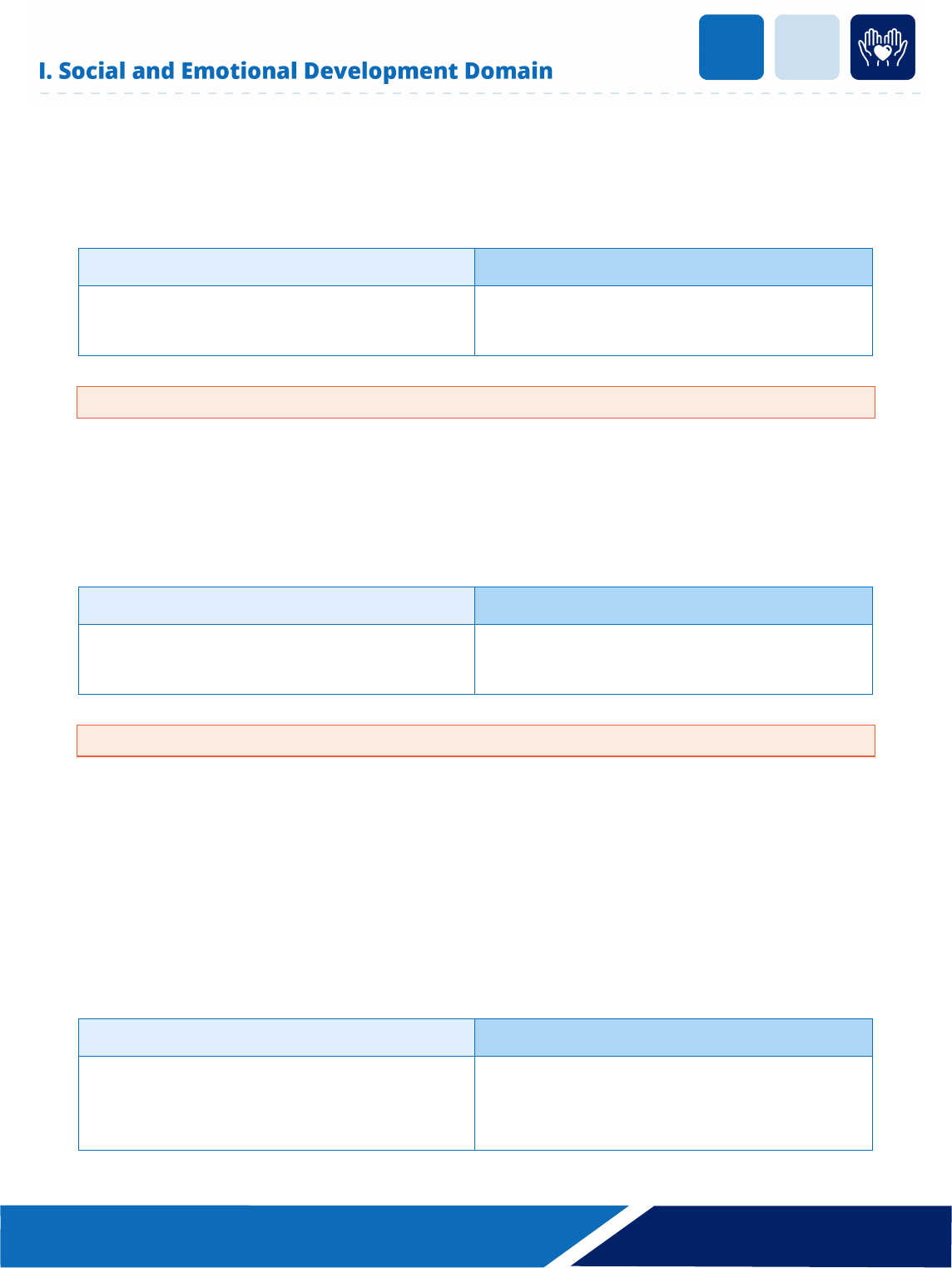
Social and Emotional Development
12
• identify and follow the sequence of the day’s events, (e.g., “After centers, it’s time to go
outside.”)
• participate in daily transitions when changing centers, moving from whole group to small group
instruction, getting in line, etc.
PK3 Outcome
PK4 Outcome
PK3.I.B.1.b Child takes care of and manages
classroom materials with adult assistance.
PK4.I.B.1.b Child takes care of and manages
classroom materials.
Child Behaviors
The child may:
• appropriately handle materials during activities
• clean up and place classroom materials in appropriately labeled spaces
• put away personal belongings in their designated space
PK3 Outcome PK4 Outcome
PK3.I.B.1.c Child manages own behavior with
adult guidance and assistance.
PK4.I.B.1.c Child regulates own behavior with
occasional reminders or assistance from adults.
Child Behaviors
The child may:
• communicate appropriately to make needs known
• wait for a turn (e.g., waits patiently at the water fountain for a classmate to finish drinking or
selects another learning center when the learning center of choice is full)
• refrain from impulsive responses (e.g., waits for turn to be called on during group discussion or
requests materials rather than grabbing them)
2. Emotional Control
PK3 Outcome
PK4 Outcome
PK3.I.B.2.a Child recognizes and expresses a range
of emotions.
PK4.I.B.2.a Child begins to
understand the connection between emotions and
behaviors.
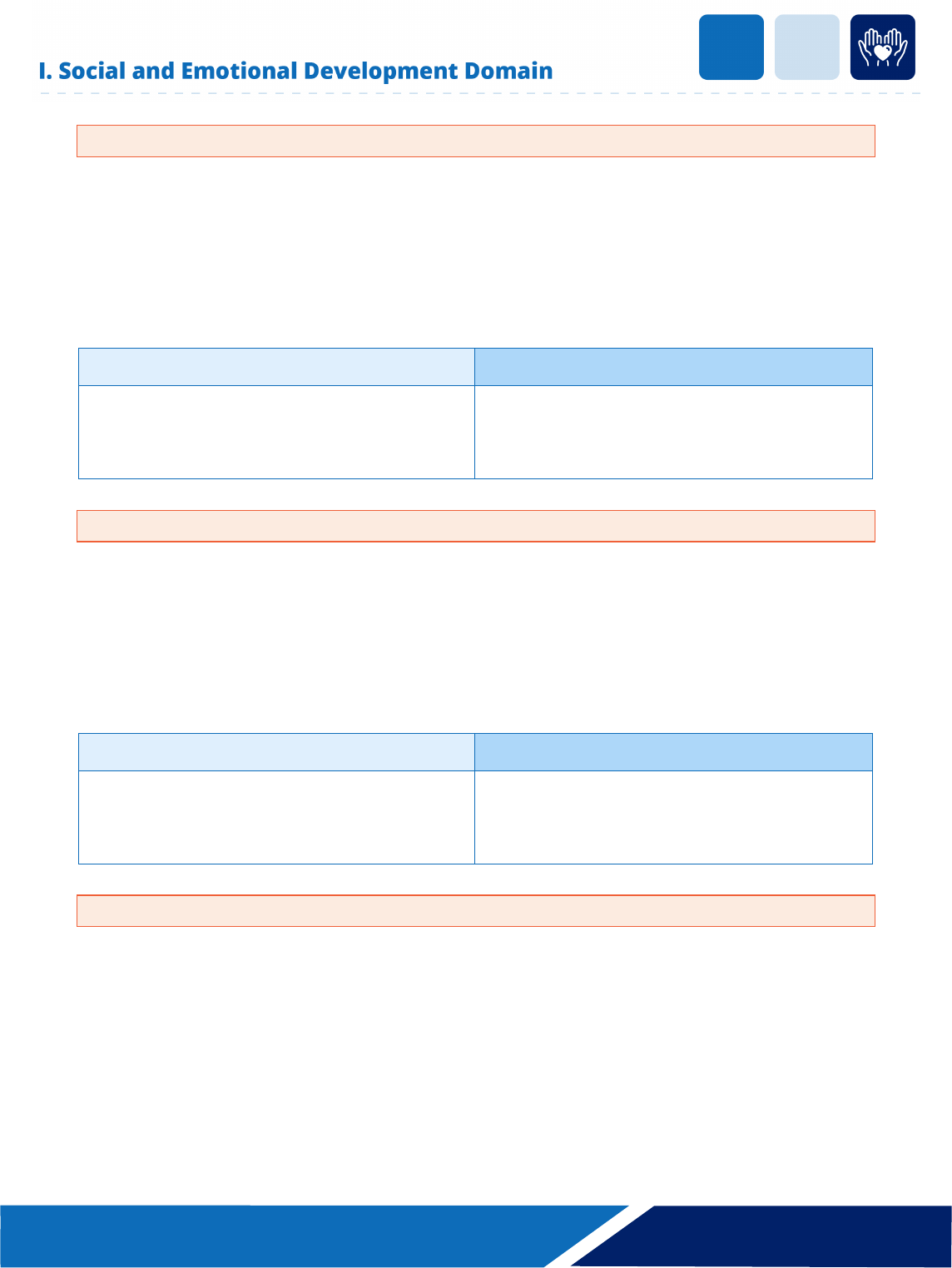
Social and Emotional Development
13
Child Behaviors
The child may:
• express feelings or respond with appropriate behavior (e.g., Child does not grab a toy back from
a friend, but rather says, “I feel sad when you take my toy!”)
• verbalize understanding that all feelings are okay even though some behaviors may not be okay
• identify appropriate and inappropriate behaviors to common feelings
PK3 Outcome
PK4 Outcome
PK3.I.B.2.b Child is familiar with basic feeling
words (e.g., happy, sad, mad, scared).
PK4.I.B.2.b Child uses verbal and nonverbal
communication to communicate basic
emotions and feelings.
Child Behaviors
The child may:
• demonstrate familiarity with a variety of feeling words (e.g., happy, sad, mad, scared, proud,
worried, excited)
• label own feelings when prompted
• identify feelings of characters in stories or movies
PK3 Outcome
PK4 Outcome
PK3.I.B.2.c Child manages intensity of emotions
with adult assistance.
PK4.I.B.2.c Child is able to manage intensity of
emotions more consistently, although adult
guidance is sometimes necessary.
Child Behaviors
The child may:
• use appropriate strategies to decrease level of distress (e.g., requests help when feeling
frustrated with a task or seeks comfort from teacher when feeling sad)
• respond positively to adult guidance in using calming strategies (e.g., suggestions to separate
self from frustrating situations or take a deep breath)
• show enjoyment while participating in activities that stimulate different types of emotions
(e.g., playground games or music activities that require alternation of loud/quiet, fast/slow)
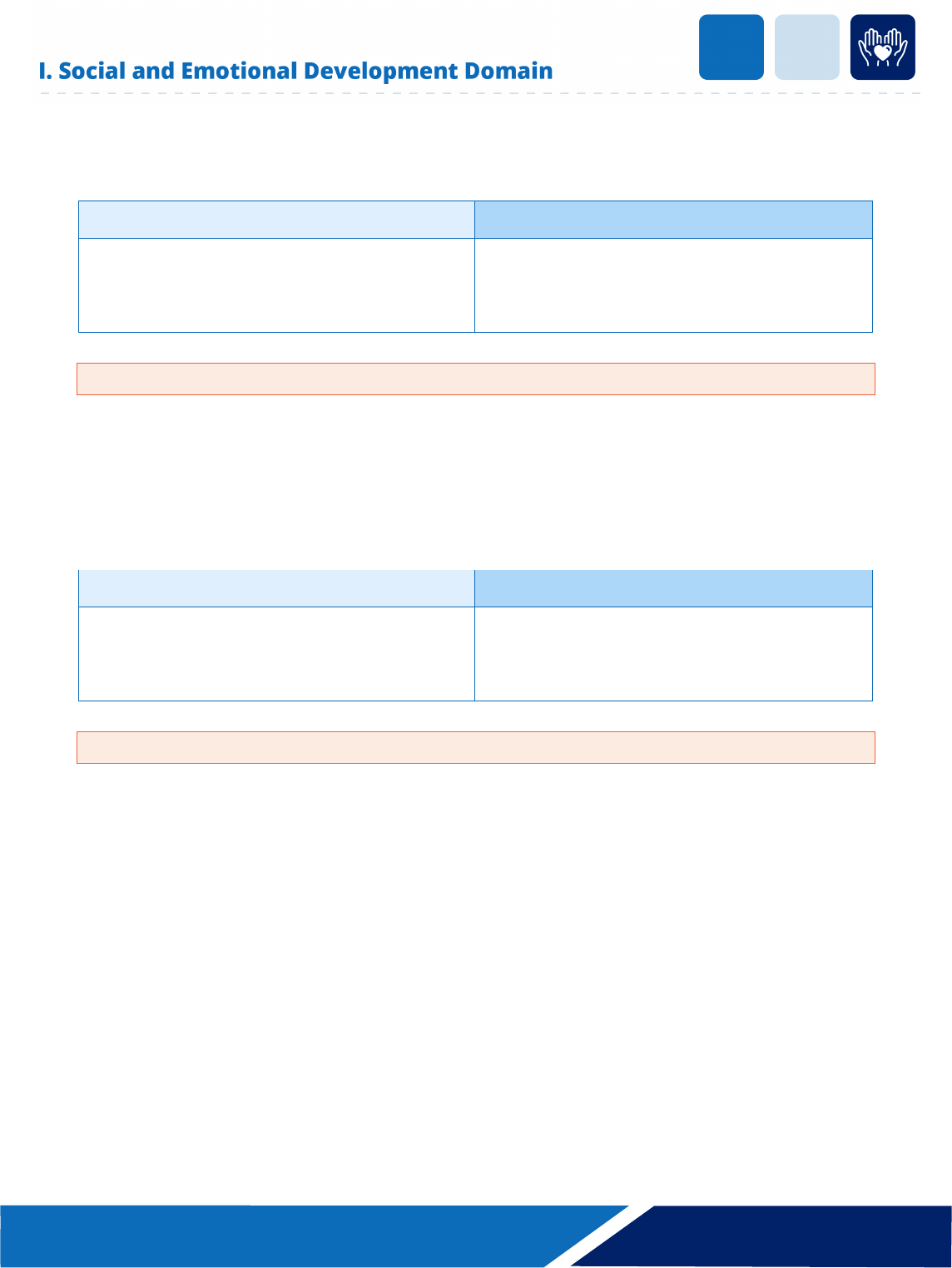
Social and Emotional Development
14
3. Control of Attention
PK3 Outcome PK4 Outcome
PK3.I.B.3.a Child focuses attention on one task at
a time but may not stay with it to completion.
PK4.I.B.3.a Child sustains attention to personally
chosen or routine (teacher-directed) tasks until
completed.
Child Behaviors
The child may:
• select and complete an activity before moving on to a new one
• create and carry out a sequence of dramatic play plans with a peer
• follow a familiar daily routine until the task is finished
PK3 Outcome
PK4 Outcome
PK3.I.B.3.b Child remains focused on engaging,
teacher-led group activities for up to 10–15
minutes at a time.
PK4.I.B.3.b Child remains focused on engaging,
teacher-led group activities for up to 20 minutes.
Child Behaviors
The child may:
• increase stamina on ability to pay attention during story time
• actively participate by sitting attentively (e.g., eye contact, raising hand, contributing to
discussion) during circle time
• en
gage in a teacher-led small group activity despite what may be occurring in other small groups
around her
C. Relationships with Others
As prekindergarten children enter school, they start forming relationships with the adults and other
children in their school environment. Effective teachers offer support and assist children as they develop
meaningful and rewarding relationships. During this developmental period, children often begin to
develop special friendships with peers that increase their feelings of comfort, joy, and confidence in
their social world. These experiences also help build a sense of empathy and caring for others.

Social and Emotional Development
15
PK3 Outcome
PK4 Outcome
PK3.I.C.1 Child forms positive relationships
with adults and peers.
PK4.I.C.1 Child uses effective verbal and nonverbal
communication skills to build relationships with
adults and peers.
Child Behaviors
The child may:
• greet teachers and/or peers in the morning and say goodbye when leaving
• demonstrate they are listening to adults and/or peers when communicating (e.g., looks at
speaker, responds to verbal or nonverbal exchanges)
• engage in conversations with adults and/or peers about what they are doing (e.g., shares stories
and experiences from outside of the school)
PK3 Outcome
PK4 Outcome
PK3.I.C.2 Child assumes roles and responsibilities
as part of the classroom community with adult
assistance.
PK4.I.C.2 Child assumes various roles and
responsibilities as part of the classroom
community.
Child Behaviors
The child may:
• readily accept and carry out “classroom helper” assignments with adult assistance
• remind his teacher that it is his turn to shut off the lights
• respect other’s workspace and time with shared materials
• take responsibility for cleaning up classroom materials after use (e.g.,” We need to put the cars
away, let’s get the box.”)
PK3 Outcome PK4 Outcome
PK3.I.C.3 Child shows interest in peer play but may
be less skilled in initiating and joining a group.
PK4.I.C.3 Child shows competence in initiating
social interactions.
Child Behaviors
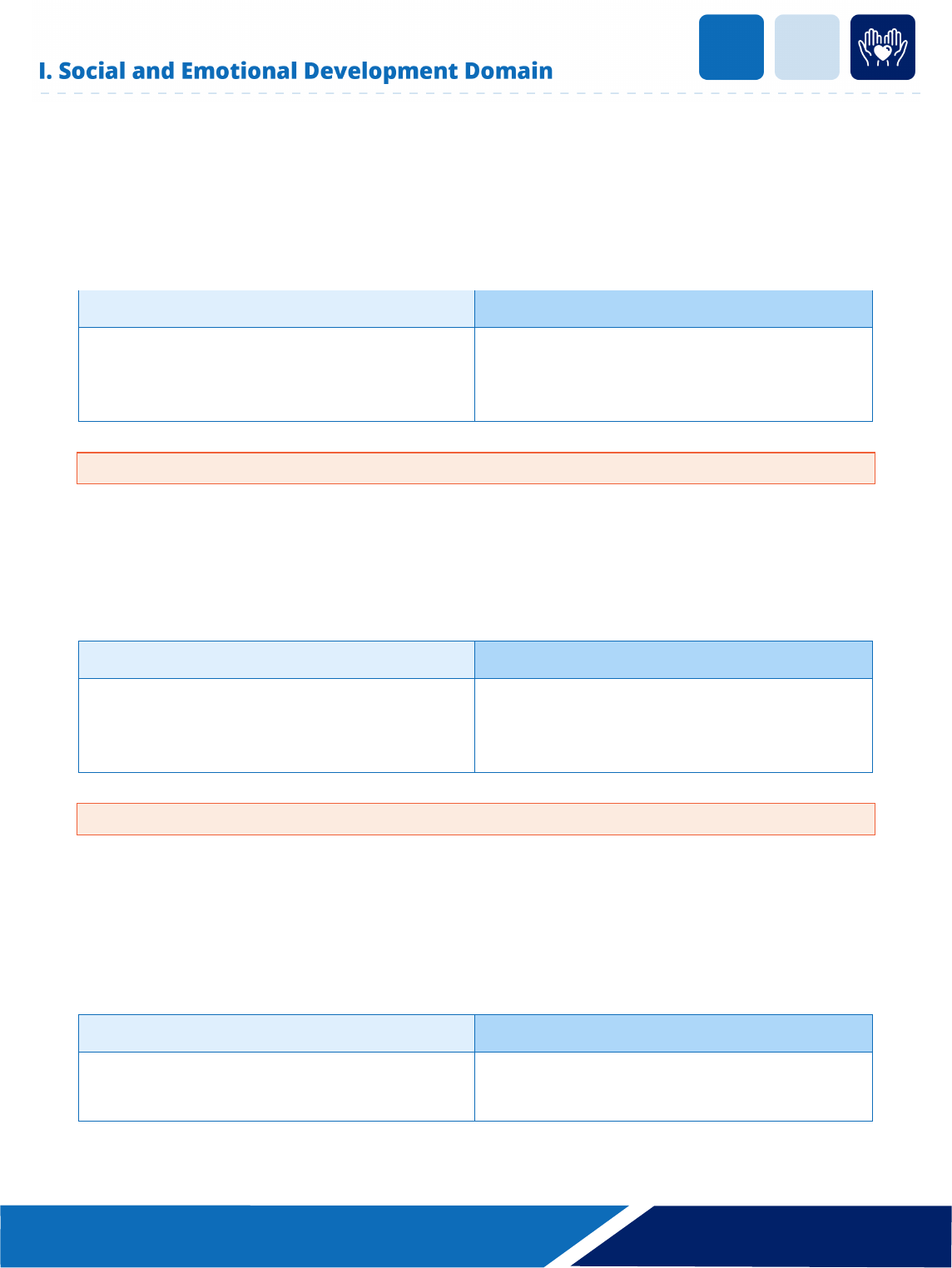
Social and Emotional Development
16
The child may:
• participate spontaneously in a variety of group activities, tasks, and play
• actively seek out partners and appropriately invite them to play (e.g., starts a game with
classmates on the playground)
• seek out the teacher to ask questions, when appropriate
PK3 Outcome
PK4 Outcome
PK3.I.C.4 Child enjoys parallel and associative play
with peers.
PK4.I.C.4 Child increasingly interacts with
peers during cooperative play scenarios that share
a common plan and goal.
Child Behaviors
The child may:
• demonstrate the ability to negotiate and compromise with peers to achieve a cooperative goal
• follow the lead of others (e.g., enters a center and adapts to the ongoing play of others)
• generate joint play goals and carry them out with at least one other peer
PK3 Outcome
PK4 Outcome
PK3.I.C.5 Child seeks adult help when experiencing
conflicts with another child.
PK4.I.C.5 Child initiates problem-solving
strategies when experiencing conflicts with
others and seeks adult support when necessary.
Child Behaviors
The child may:
• follow conflict resolution steps, with teacher’s guidance, to solve a dispute with a classmate
• ask an adult or peer for help when needed (e.g., “Teacher, Johnny isn’t listening to me; he took
my toy and won’t give it back.”)
• attempt to work out problems with a peer independently before seeking adult help
PK3 Outcome
PK4 Outcome
PK3.I.C.6 Child responds with concern when a child
or adult is distressed.
PK4.I.C.6 Child demonstrates empathy and caring
for others.
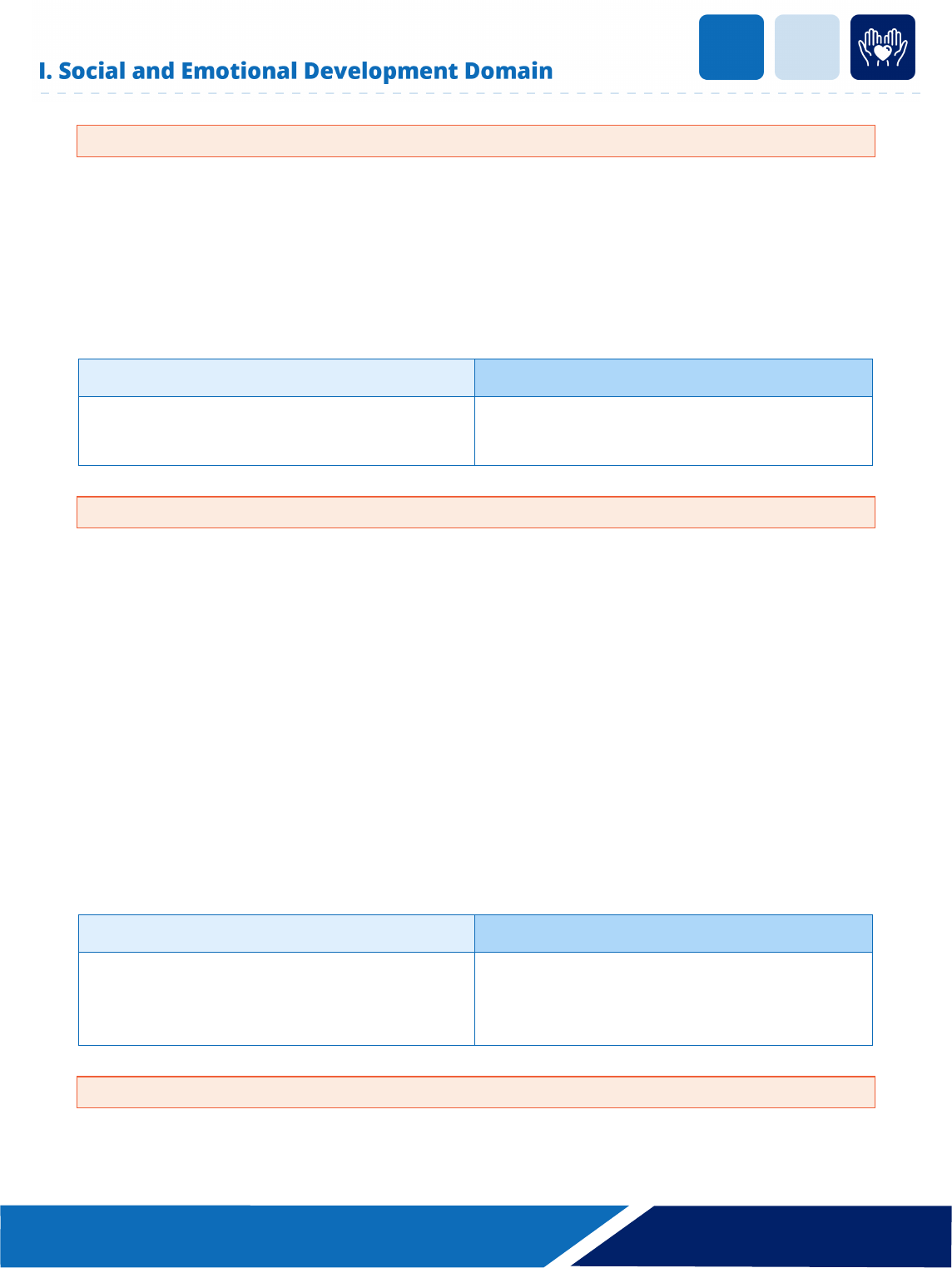
Social and Emotional Development
17
Child Behaviors
The child may:
• show emotions related to another’s experience (e.g., expresses sadness for a character in a book
or shows excitement when a classmate crosses the finish line in a race)
• demonstrate a desire to be helpful (e.g., volunteers to help a classmate clean up a spill)
• demonstrate consideration for a classmate (e.g., comforts a classmate who is crying, slows down
to walk with a classmate who has an injury, befriends a classmate who is shy)
PK3 Outcome
PK4 Outcome
PK3.I.C.7 Child interacts with peers and may have
preferred friends.
PK4.I.C.7 Child interacts with peers and has
preferred friends.
Child Behaviors
The child may:
• talk with friends to plan their play (e.g., planning to play ‘house’ in the dramatic play/pretend
and learn center)
• express interest in playing with a preferred playmate outside of school
• independently choose a work or play partner
D. Social Awareness
Prekindergarten children need adult support and guidance in learning how to socially interact with
others. It can be a challenge for a young child to sense other people’s emotions or to imagine what
someone else might be thinking or feeling. Teachers can reinforce children’s social awareness
skills by facilitating peer-to-peer and adult-to-child interactions and asking thought-provoking
questions with the support of rich, socially relevant educational materials.
PK3 Outcome
PK4 Outcome
PK3.I.D.1 Child shows interest in other people and
their feelings.
PK4.I.D.1 Child demonstrates an understanding
that others have perspectives and feelings that are
similar and/or different from her own.
Child Behaviors

Social and Emotional Development
18
The child may:
• use words to express own and other’s preferences (e.g., “I like to paint with red and Mary likes
to paint with blue.”)
• use words to express own and other’s feelings (e.g., “Michael thinks that’s funny, but I don’t!”)
• ask questions that indicate understanding that others may have a different perspective (e.g.,
“Do you like cats or dogs?” or “Were you scared of the thunder?”)

Emergent Literacy: Language and Communication
19
II. Emergent Lite racy: Language and Com munication Doma in
II. Emergent Literacy: Language and Communication Domain
During the prekindergarten years, children’s expanding language skills have a tremendous impact upon
their ability to read and write as they progress successfully through school. Explaining the differences in
words and sounds, talking to children about objects and their names (labeling), using expanded
vocabulary, and modeling language with grammatical complexity are all ways in which teachers can help
to build children’s oral language development. Additionally, the pragmatics of oral language in an
academic setting, such as conversational skills and the development of storytelling and oral
explanations, are an important part of all children’s oral language development. Given adequate
opportunities to interact with responsive adults in language-rich classrooms, young children’s language
abilities will expand rapidly during these years. The language and communication domain of learning
includes not only receptive (listening) and expressive (speaking) skills, but also vocabulary and sentence
structure skills. Mastery of these skills will build young children’s ability to understand what they hear
and communicate their own ideas and experiences effectively.
Many prekindergarten students in Texas are multilingual learners. A multilingual learner is a student
who is exposed to more than one language. A multilingual learner who is also identified as an emergent
bilingual student is not as proficient in spoken English as their native English-speaking peers. An
identified emergent bilingual student will be offered the opportunity to participate in a state approved
bilingual education or English as a Second Language (ESL) program.
Developing language and communication skills across two languages is an important part of a child’s
unique identity regardless of program placement or participation. It will be important for
prekindergarten teachers to intentionally make connections between home and school, honor children’s
native language, and send the message that knowledge of a language other than English is an inherently
valuable asset. Prekindergarten educators help all children develop academic vocabulary and the
language skills required for basic social communication, but they should also provide targeted language
opportunities for multilingual learners. The guidelines in this domain outline end-of-year language
outcomes for 3- and 4-year-old children in their language of instruction.
The Language and Communication Domain of the Texas Prekindergarten Guidelines is divided into the
following skills: listening comprehension, speaking (conversation), articulation, vocabulary, and sentence
structure.
A. Listening Comprehension
From birth, children begin learning by listening to the world around them. As their exposure to
language(s) increases, so does their understanding. Multilingual learners understand that they are
hearing two language systems from a very early age. Prekindergarten-age children are able to
comprehend (with increasing accuracy) what they hear in conversations and in stories read aloud.
Children demonstrate understanding through their questions, comments, and actions.

20
Emergent Literacy: Language and Communication
PK3 Outcome
PK4 Outcome
PK3.II.A.1 Child responds to situations in ways
that demonstrate an understanding of what has
been communicated.
PK4.II.A.1 Child shows understanding by
responding appropriately to what has been
communicated by adults and peers.
Child Behaviors
The child may:
• use nonverbal gestures to show a response to adults and peers (e.g., nodding/smiling to show
understanding/agreement, tilting head/frowning face to show confusion, or giving a thumbs
up/down or to respond to questions)
• respond to requests by completing the appropriate actions (e.g., passing a pencil when a friend
asks for it)
• appropriately contribute to discussions by commenting or asking questions
• provide appropriate verbal responses to questions asked by peers or adults
PK3 Outcome
PK4 Outcome
PK3.II.A.2 Child shows understanding by following
two-step verbal directions.
PK4.II.A.2 Child shows understanding by following
three-step verbal directions.
Child Behaviors
The child may:
• follow multi-step directions given by the teacher (e.g., “Please put your things away, then find
your square on the carpet, and sit down.”)
• repeat previously given multi-step instructions to a peer or adult
• participate in songs and/or dances that require the response of various movements or gestures
(e.g., “march your feet, then find a friend, grab their hand and dance with them.”)
• participate successfully in games such as “Follow the Leader” or “Simon Says”
B. Speaking (Conversation)
Prekindergarten children become increasingly able to describe their wants and needs, carry on
conversations with others, and share information with both peers and adults. The ability to engage
others in conversations involves asking questions, listening, and responding, as well as using verbal and
nonverbal communication. Additionally, multilingual learners become increasingly aware of language
context. For example, a staff member with knowledge of Spanish and English learns that he can have a
conversation in Spanish with a bilingual librarian but will use English to express a preference to the non-
bilingual art teacher.
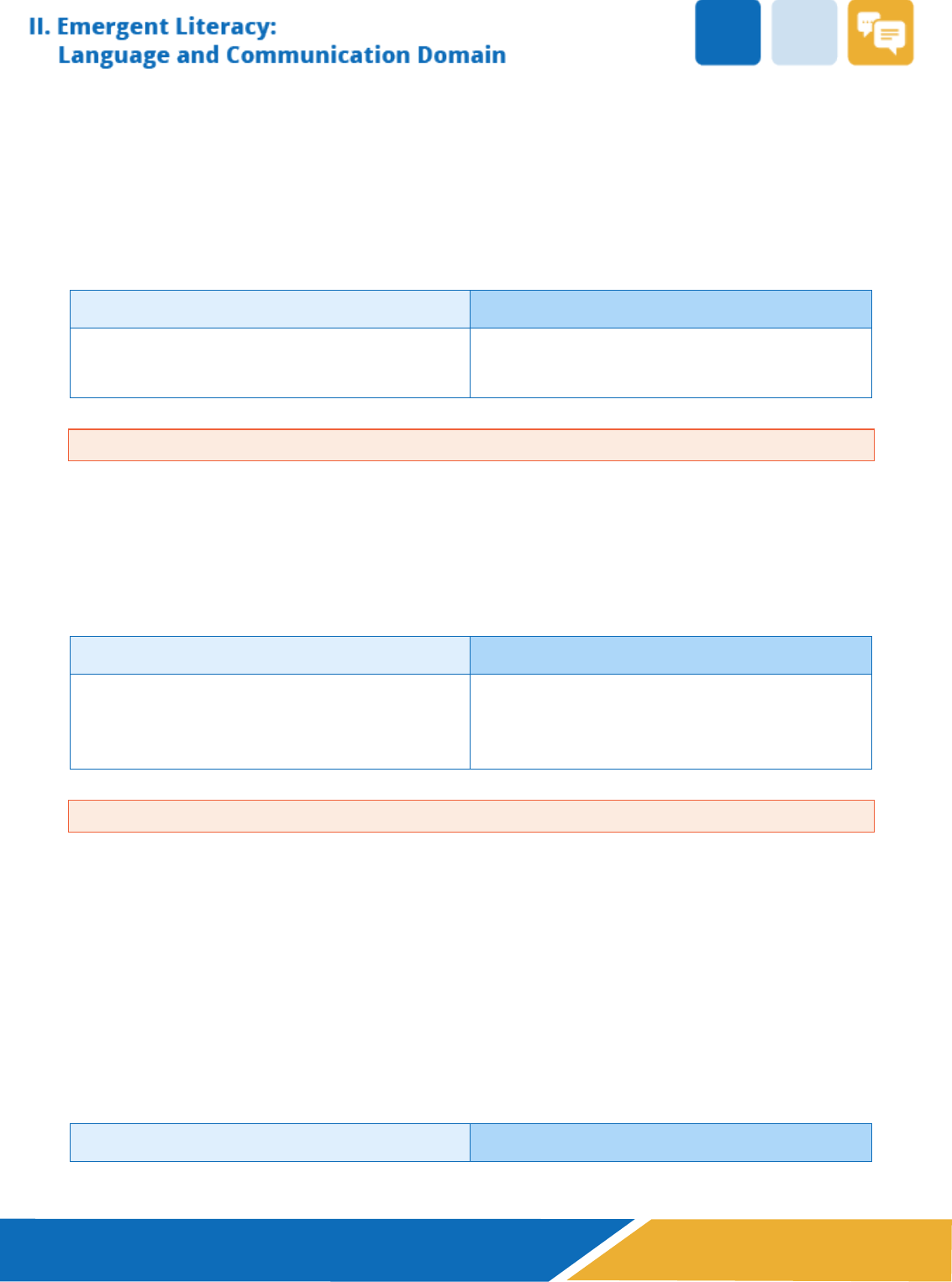
21
Emergent Literacy: Language and Communication
Children who are multilingual learners may require more time to respond because they are learning and
processing two languages at once. Multilingual learners may also respond in one language and use the
other language to fill in a word or phrase within a sentence. Both are normal parts of bilingual
development. Multilingual learners should be encouraged and expected to demonstrate their
speaking/communication skills in their home language as well as in English.
PK3 Outcome
PK4 Outcome
PK3.II.B.1 Child uses language to communicate
basic needs and wants.
PK4.II.B.1 Child uses language for multiple
purposes.
Child Behaviors
The child may:
• request help from an adult or peer when needed
• communicate feelings, needs, and wants
• participate in one-on-one or group discussions during learning activities
• share information or stories
PK3 Outcome
PK4 Outcome
PK3.II.B.2 Child begins to use appropriate
language, style, and nonverbal cues during
communication with familiar adults and peers.
PK4.II.B.2 Child engages in conversations in
appropriate ways, demonstrating knowledge of
verbal and nonverbal conversational rules.
Child Behaviors
The child may:
• initiate, participate in, or terminate conversations appropriately (e.g., engages in appropriate
greetings, contributes to an interactive conversation)
• participate in a conversation with a peer or adult, taking turns talking and not interrupting
• have multiple-turn conversations with others, listening to others or extending/connecting to an
idea expressed by the other person
• use nonverbal gestures appropriately (e.g., makes eye contact with the speaker, uses facial
expressions to illustrate emotion, stands an appropriate distance from the speaker, uses
gestures to communicate basic needs when vocabulary is limited)
PK3 Outcome
PK4 Outcome
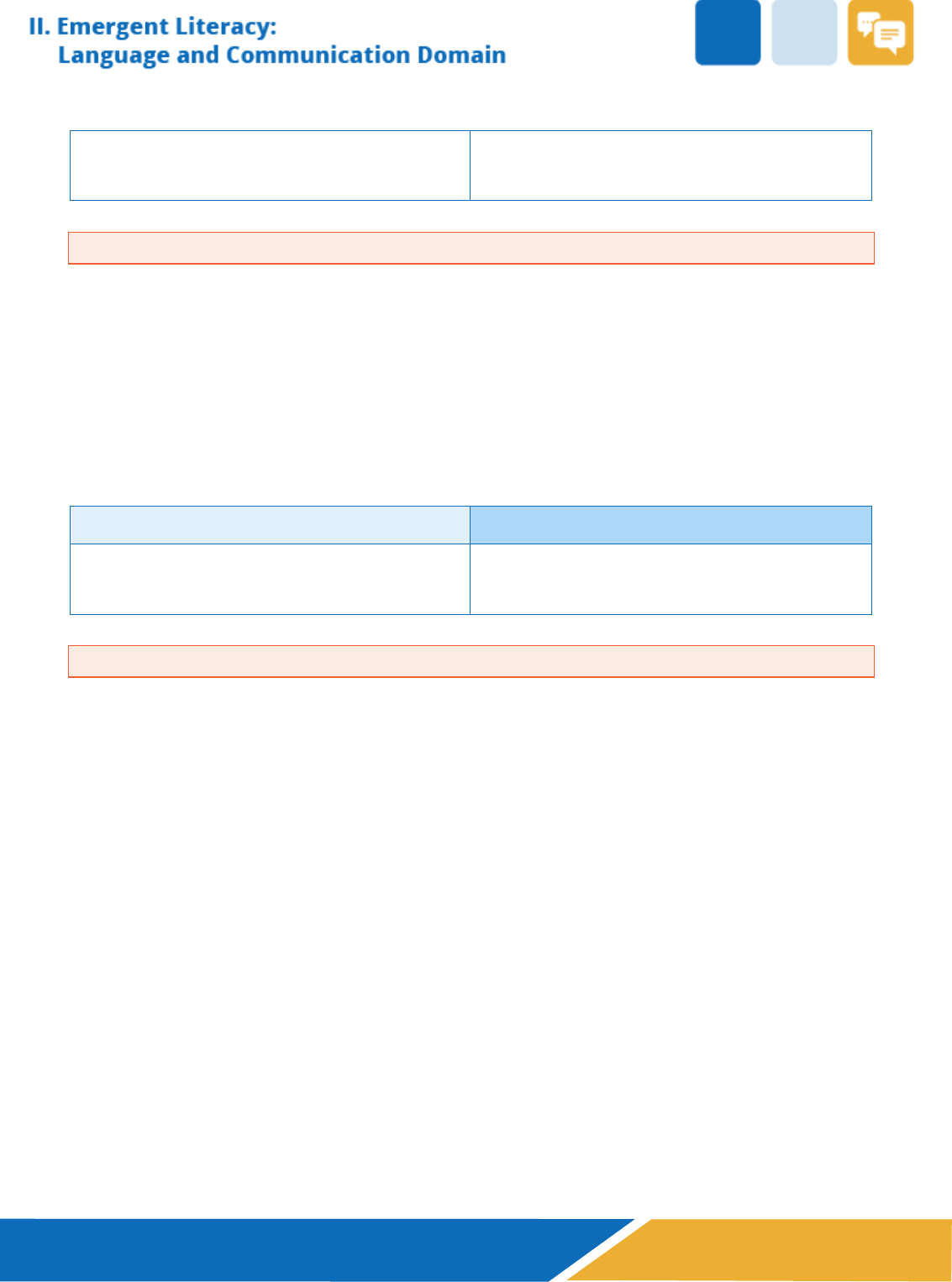
22
Emergent Literacy: Language and Communication
PK3.II.B.3 Child is able to communicate basic
information in familiar social settings.
PK4.II.B.3 Child provides appropriate information
in various settings.
Child Behaviors
The child may:
• answer questions from adults within the school, other than the classroom teacher (e.g., nurse,
secretary, cafeteria staff)
• provide adequate information to update someone new to a situation about what is currently
taking place (e.g., if someone walks up to a group of children playing, the child will explain what
they are playing so the new person can join in)
• communicate emotions and needs/desires appropriately, (e.g., "I'm feeling sad today
because...", asking permission to use the restroom, inviting others to join an activity)
PK3 Outcome
PK4 Outcome
PK3.II.B.4 Child begins to use appropriate
language for different situations.
PK4.II.B.4 Child matches language to social
contexts.
Child Behaviors
The child may:
• use proper titles when speaking to people (e.g., refers to classmates by first name but uses the
title “Mrs.” or “Mr.” when addressing the teacher)
• adjust voice appropriately based on the activity or situation (e.g., moves close to a teacher and
speaks quietly as classmates read a book in the library, yells for a friend across the playground,
uses a caring voice when talking to a friend who is crying)
• align vocabulary to match the situation (e.g., uses academic words in the classroom and more
informal word choice when in the cafeteria)
C. Articulation
Prekindergarten children must learn to vocalize, pronounce, and discriminate sounds and words within
languages. Learning to accurately perceive the difference between similar-sounding words will support
children’s development of early literacy skills and help set them up for future reading and writing
success. Young children will continue to acquire the ability to recognize new sounds but may
mispronounce some words in their own speech. Difficulty with producing some speech sounds (e.g., /l/,
/r/, or /th/) is common for prekindergarten children but may improve with practice and age. Similarly,
multilingual learners may need repeated, meaningful opportunities to more closely approximate the
sounds of the language with which they are less familiar.
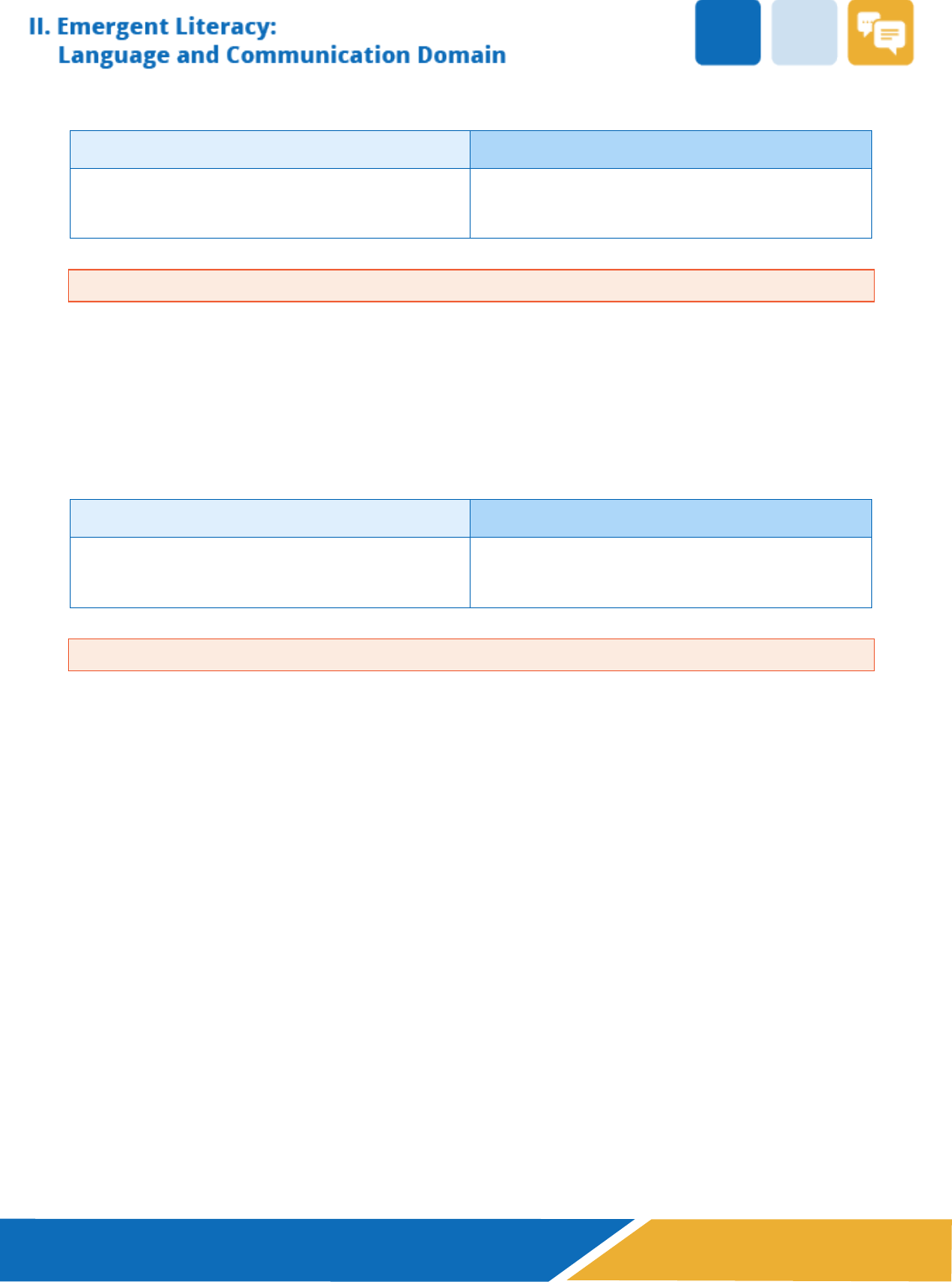
23
Emergent Literacy: Language and Communication
PK3 Outcome
PK4 Outcome
PK3.II.C.1 Child's speech is understood by familiar
adults and peers.
PK4.II.C.1 Child’s speech is understood by both
familiar and unfamiliar adults and peers.
Child Behaviors
The child may:
• speak loud enough so that what is being said can be heard
• articulate individual words in a sentence
• enunciate each sound or syllable in words
• distinctly produce voiced and unvoiced English consonant pair sounds (e.g., /b/- /p/, /d/- /t/,
/z/- /s/, /k/- /g/, and /v/- /f/)
PK3 Outcome PK4 Outcome
PK3.II.C.2 Child begins to mimic intonation of
language through songs and fingerplay.
PK4.II.C.2 Child demonstrates growing
understanding of the intonation of language.
Child Behaviors
The child may:
• recite nursery rhymes and songs with the correct intonation
• use appropriate intonation to represent emotion
• match intonation to the situation (e.g., talking to a baby vs. talking to an adult)
D. Vocabulary
Vocabulary development is one of the most important predictors of later reading achievement.
Prekindergarten children experience rapid growth in their understanding of words and word
meanings when they are learning in a language-rich environment. Vocabulary acquisition is largely
developed by exposing children to new words through stories and engaging them in meaningful and
intentional interactions with adults who incorporate new language into daily conversations.
Vocabulary development occurs when educators create a space in which there are many
opportunities to talk about personal experiences, read familiar stories, sing familiar songs, and play
word games on a regular basis. Vocabulary knowledge reflects children's previous experiences and is
increasingly refined as they learn new words and concepts through their growing knowledge of the
world around them.
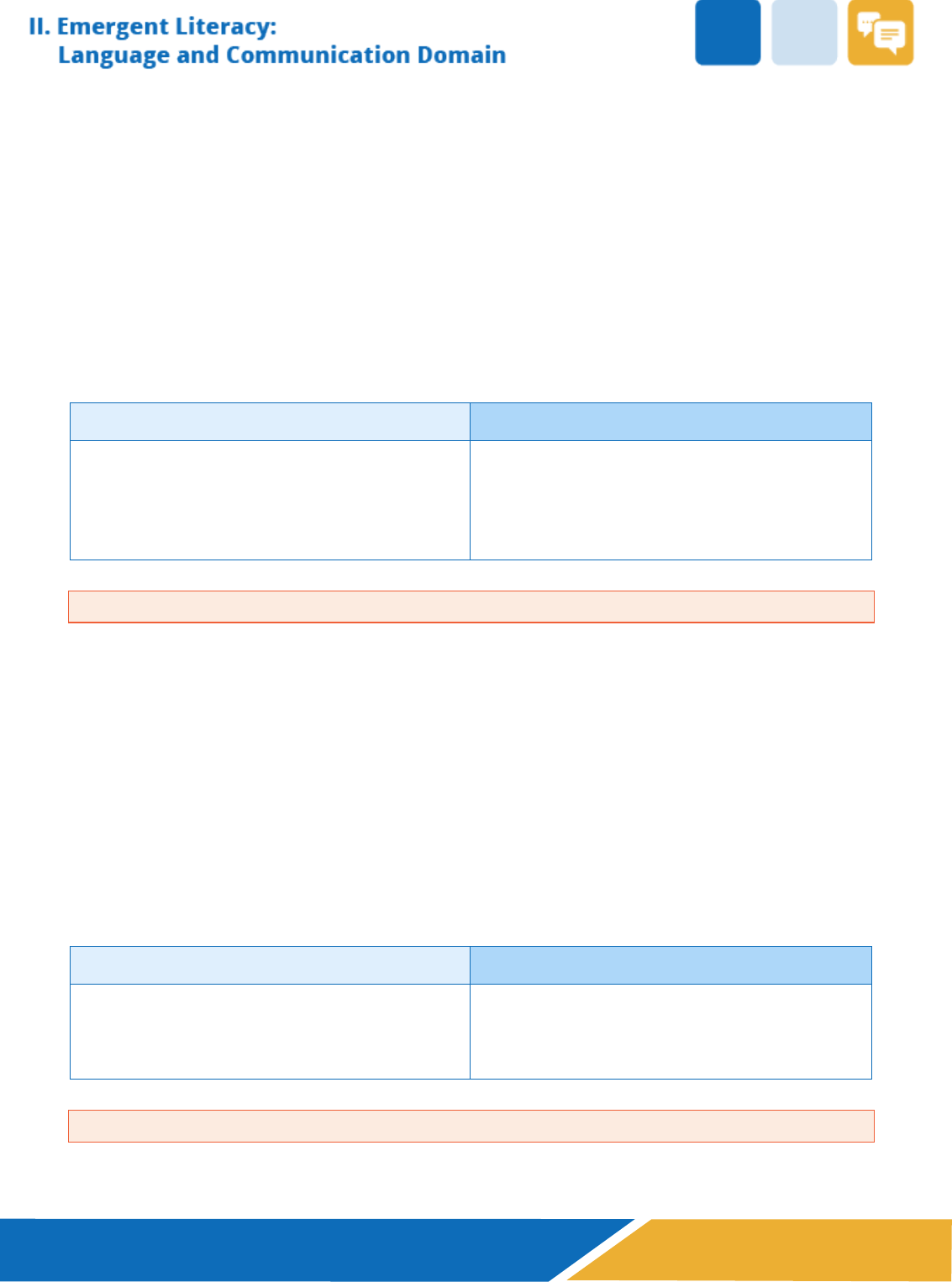
24
Emergent Literacy: Language and Communication
Multilingual learners in a bilingual education program will develop vocabulary in both the program
language and English via learning opportunities in each language as well as direct instruction in
cross-linguistic connections. Both languages are honored and valued, and there is a diminished
linguistic barrier between home and school. Educators of multilingual learners outside of bilingual
programs should intentionally leverage families’ linguistic resources as a foundation for second
language learning. Consider Katie, a multilingual learner who speaks mostly Vietnamese at home.
During a study of fairy tales, Katie’s teacher invites Katie’s mom to read a portion of a Vietnamese
version of the Cinderella tale in Vietnamese. Katie’s language and culture is validated, and Katie’s
peers get to practice making meaning based on prior knowledge, pictures, etc. The class learns a few
key vocabulary words from the story in Vietnamese.
PK3 Outcome
PK4 Outcome
PK3.II.D.1 Child understands (receptive) and uses
(expressive) expected words to label and describe
common objects, people, places, actions, and
events.
PK4.II.D.1 Child understands (receptive) and uses
(expressive) a wide variety of words to label,
describe and make connections among objects,
people, places, actions, and events.
Child Behaviors
The child may:
• appropriately identify items seen in real life, books, or pictures, naturally incorporating new
terminology
• use newly learned words to describe or explain in detail things seen in real life, books, or
pictures
• use descriptive words when asking questions or giving directions to peers in authentic situations
(e.g., “Can you give me that small brown crayon?" or “Please grab that red cup so we can use it
in the kitchen center.")
• use descriptive language to compare, contrast, and categorize objects, people, and actions
• provide opposites (antonyms) or words with similar meaning (synonyms) to demonstrate
understanding of key vocabulary words
PK3 Outcome PK4 Outcome
PK3.II.D.2 Child understands (receptive) the
instructional language of the classroom.
PK4.II.D.2 Child understands (receptive) and uses
(expressive) the instructional language of the
classroom.
Child Behaviors
The child may:

25
Emergent Literacy: Language and Communication
• participate in activities that reinforce the use of instructional language (e.g., circle time
discussions, observational conversations, recall & review)
• respond appropriately to questions related to content-area instruction (e.g., If a teacher asks,
"how many sides does a triangle have?" the child would immediately respond "three")
• follow directions that include language from instruction (e.g., "Please draw a small red square.”
or "Sort the pictures into two categories: pairs that rhyme and pairs that do not rhyme.")
• use language from previous instruction to describe something (e.g., when retelling a story, the
child might use the word "character" or when describing an object, the child might use words
like "heavier" or "lighter")
• incorporate instructional terms into learning center interactions (e.g., in library, the child might
point to the cover of a book and tell a friend “Look, that is a seed, this book must be about
plants.")
PK3 Outcome
PK4 Outcome
PK3.II.D.3 Child shows a steady increase in
understanding (receptive) and using (expressive)
language learned from books, conversations, and
play.
PK4.II.D.3 Child consistently understands
(receptive) and uses (expressive) new vocabulary
acquired through books, conversations, and play.
Child Behaviors
The
child may:
• add a connected idea to another child’s comment (e.g., a child says, “My rock went to the
bottom.” and then the other child responds with: “Your rock sank!”)
• respond to and use thematic vocabulary when engaging in child-initiated play
• use specific terminology when recalling facts from a book that has been read aloud or when
describing the events in the story
• use new vocabulary words when asking and answering questions
• incorporate new vocabulary into comments when contributing ideas related to the current topic
of conversation
E. Sentences and Structure
Prekindergarten children become increasingly adept at using language to express their needs and
interests, share ideas, and participate in conversations with their peers. The grammatical
complexity of a spoken sentence expands when they have plenty of opportunities for rich
conversations with other children and adults. Children’s overgeneralization of language rules, which
results in the use of invented words (e.g., saying “foots” instead of “feet”), is a normal part of
language acquisition. Multilingual learners may also overgeneralize across languages (e.g., saying
“the dog big” instead of “the big dog” is an example of applying the Spanish language structure “el
perro grande” in an English sentence). This flexibility of usage is not a sign of confusion but
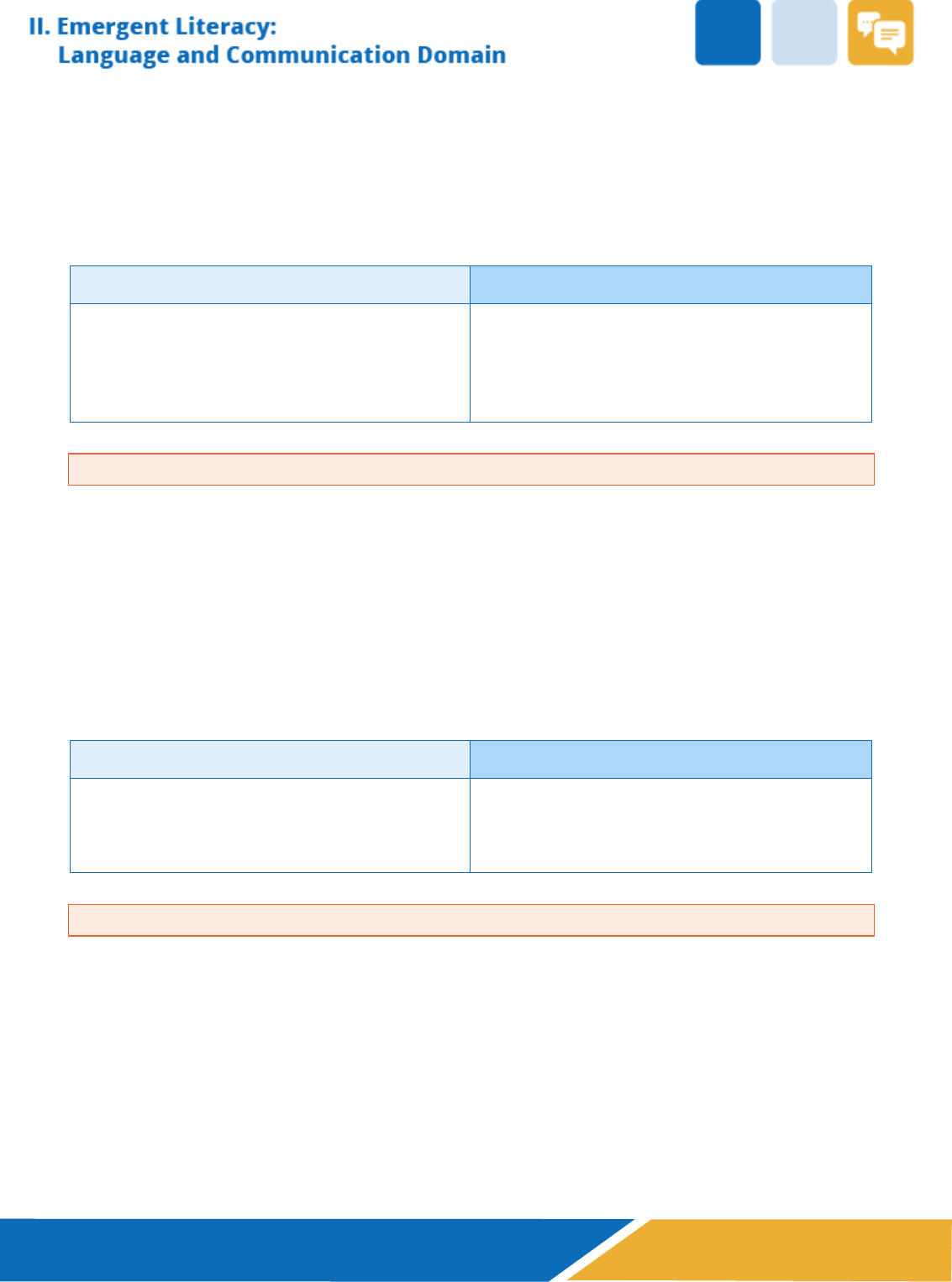
26
Emergent Literacy: Language and Communication
evidence of a developing bilingual brain. Another sign of developing bilingualism is the use of words
from two languages in one sentence. For example, a sequential bilingual student learning Spanish in
a dual language immersion program may say at the class party “Quiero el cookie.” This child is
beginning to use Spanish to communicate thoughts and fills in the gap in vocabulary knowledge
with a known English word in order to make preferences known.
PK3 Outcome
PK4 Outcome
PK3.II.E.1 Child typically uses simple sentences of
three to four words, usually in correct word order.
PK4.II.E.1 Child typically uses complete sentences
of four or more words with age-appropriate
grammatical complexity, usually in standard word
order.
Child Behaviors
The child may:
• share a personal experience using longer, detailed sentences with complex language (e.g.,
nouns, adjectives, verbs, prepositions, etc.)
• participate in interactive discussions accurately using sentences with complex language (e.g.,
nouns, adjectives, verbs, prepositions, etc.)
• respond to questions and add ideas using complete sentences
• speak using complete sentences, with standard word order when engaging in classroom
activities
PK3 Outcome
PK4 Outcome
PK3.II.E.2 Child begins to use regular plurals and
regular past tense correctly.
PK4.II.E.2 Child correctly uses regular and irregular
plurals, regular past tense, personal and possessive
pronouns, and subject-verb agreement.
Child Behaviors
The child may:
• correctly use regular plurals when speaking (e.g., "I have one sister right now, but when my
mom has her baby, I will have two sisters.")
• correctly use irregular plurals when speaking (e.g., "If I brush my teeth every day, how come I
still lost a tooth?")
• use the correct tense when describing something he did yesterday or last week (e.g., says
“went” although a younger classmate says “goed.”)
• use correct personal and possessive pronouns when speaking (e.g., uses “my” and “mine” to
identify own work or “his” and “hers” to identify a peer’s work)
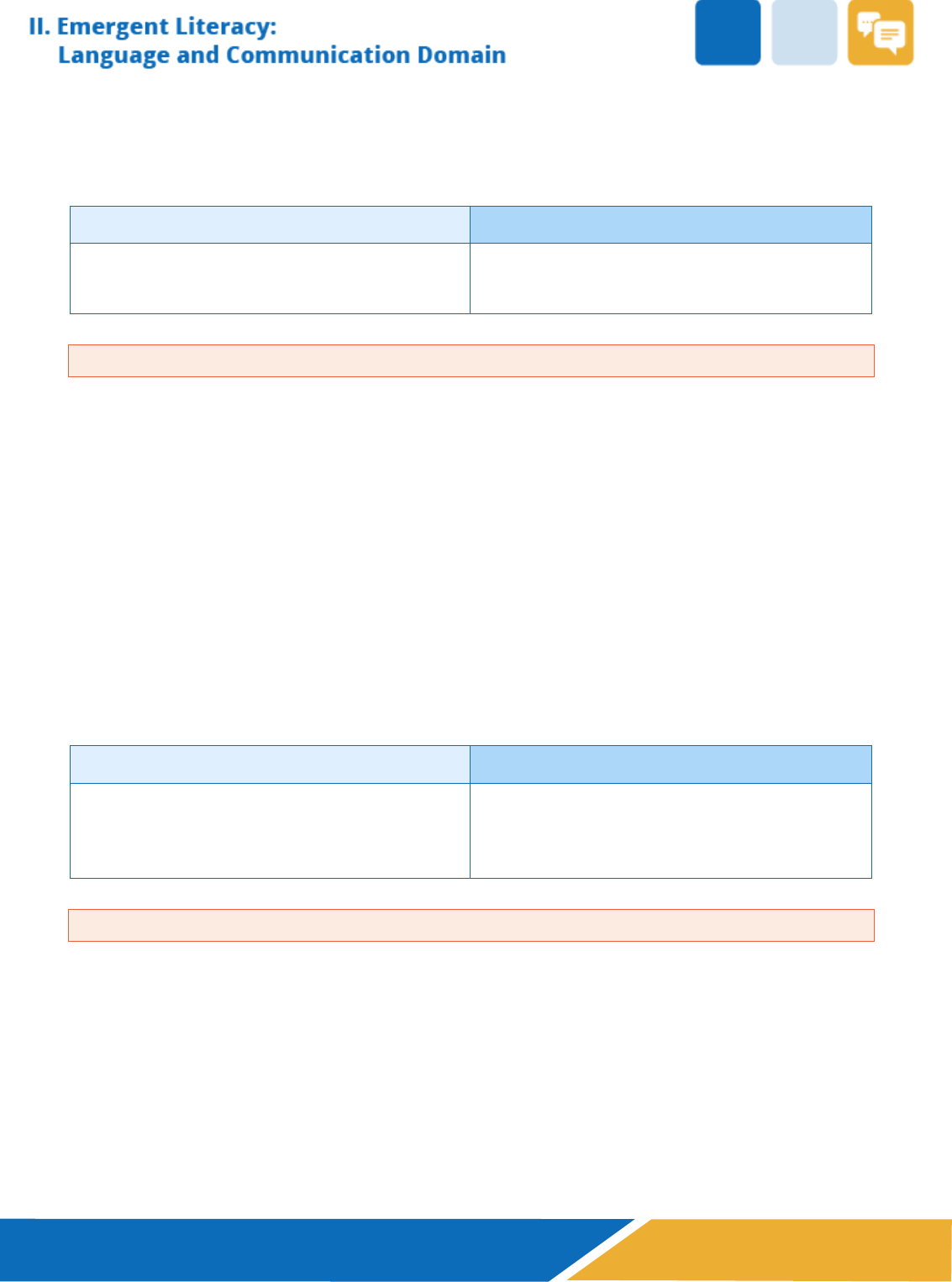
27
Emergent Literacy: Language and Communication
• use proper subject-verb agreement when telling a story (e.g., "First, the black dog chases the
cat. Then the brown dog joins him. Now both dogs chase the cat.”)
PK3 Outcome PK4 Outcome
PK3.II.E.3 Child uses simple sentence structures
with at least one idea.
PK4.II.E.3 Child uses sentences that combine
multiple phrases or ideas.
Child Behaviors
The child may:
• use sentences with more than one phrase when talking with a friend during centers, classroom
activities, or play time (e.g., “Let’s go to the store and get milk for the baby.” or "Since I am
older, I will go first.")
• add information in multiple phrases during circle time or class discussions (e.g., “Birds build
nests in the trees and then they lay their eggs.”)
• combine phrases to show a sequence of events when describing personal experiences or
retelling a story (e.g., “We went to the grocery store and then drove back home.” or "While we
were waiting for the bus, it started to rain.")
• ask questions that include more than one idea (e.g., "If I grab this book, will you come read with
me?")
• use sentences that include cause and effect (e.g., "The rock was heavy, so it sank." or "The little
boy was sad because he lost his toy.")
PK3 Outcome
PK4 Outcome
PK3.II.E.4 Child understands increasingly longer
sentences that combine two ideas.
PK4.II.E.4 Child uses sentences that provide many
details, remains on topic, and clearly
communicates intended meaning.
Child Behaviors
The child may:
• tell a story with lots of detail, that makes sense and stays on topic
• describe a personal experience, combining ideas, giving lots of detail, and remaining focused on
the topic (e.g., “When my grandpa came over, we went to the park. We had fried chicken and
played on the swings.”)
• participate in a group discussion by building on or extending the ideas of peers
• use complex sentences to contribute relevant ideas during shared and/or interactive writing
experiences

Emergent Literacy: Reading
28
III. Emergent Literacy: Reading Domain
Learning to read and write are among the most important milestones and achievements in a young
child’s life. Early language and literacy instruction is critical because research has proven that emergent
literacy skills serve as predictors for children’s school readiness, and their later capacity to learn
academic knowledge. Children acquire emergent literacy skills when they are actively engaged in
meaningful and purposeful interactions and learning experiences. They develop an understanding of the
everyday functions of print and gain the motivation to learn to read through daily exposure and
engagement with various forms of verbal and written language, including nonfiction and fiction books,
poems, songs, and nursery rhymes. Being read to and interacting with culturally relevant stories and
print also helps children build their social and cultural identities.
Even before children start school, they can become aware of systematic patterns of sounds in spoken
languages, manipulate sounds in words, recognize words or environmental print, learn the relationship
between sounds and letters, and establish a basic understanding of storytelling and story structure. The
goal of emergent literacy instruction in prekindergarten is not to teach children to read connected text or
even whole words, but rather to teach the building blocks that will, in later grades, provide children the
foundation needed to become proficient readers and writers. When given ample opportunities to
interact with books and other forms of print, as well as some explicit and systematic instruction in
emergent literacy skills, children can learn much more about the purposes and concepts of written
language and about the letters that can be combined to form print and their corresponding sounds.
Young children learn best through experiences that are meaningful and interesting to them and benefit
from guided practice and repetition.
Multilingual learners learning to read only in English will use what they already know and understand
about literacy in their primary language to make connections to emergent literacy experiences in
English. Families of these learners must be empowered to understand that continuing to expose
children to literacy experiences in their native language is not just important, but a critical form of
literacy support that they are uniquely qualified to provide. Multilingual learners in bilingual programs
who experience emergent literacy instruction in both English and a primary or partner language will be
explicitly guided to make cross linguistic connections in school. This biliteracy perspective can be
supported by families regardless of language proficiency levels in the home.
The Emergent Literacy: Reading Domain of the Texas Prekindergarten Guidelines is divided into the
following skills: motivation to read, phonological awareness, alphabet knowledge, comprehension of
text, and concepts of print.
A. Motivation to Read
The prekindergarten years are an important time for increased motivation to read and write and can be
especially important for children who have not previously and do not currently have access to books. All
children benefit immensely from the targeted opportunity to develop an understanding of and
appreciation of written languages through early school experiences. Prekindergarten children benefit
from classroom activities and environments that build on their own family backgrounds and personal
experiences to create positive connections to reading and writing. These early experiences will come to
define their expectations and influence their motivation to work toward learning to read and write

Emergent Literacy: Reading
29
independently. These same experiences also give families a first impression of how their home culture
will be acknowledged and valued within the school system. It is therefore critical that students of all
cultural and linguistic backgrounds see themselves and their families reflected in books, activities, and
the classroom culture in general.
Children who are motivated to read and write find pleasure in looking at the covers and illustrations in
books, listening and making personal connections to stories being read aloud, and mimicking reading
behaviors through independent exploration of books and other forms of text. They also have an intrinsic
motivation to ask about surrounding print and a desire to understand how writing works. Learning to
read is a gradual, ongoing process; however, building young children’s enthusiasm for books and written
text at an early age can impact their willingness to overcome potential future challenges with reading
and writing
.
PK3 Outcome
PK4 Outcome
PK3.III.A.1 Child demonstrates an interest in
pictures, text, and stories read aloud.
PK4.III.A.1 Child engages in story-related pre-
reading activities.
Child Behaviors
The child may:
• repeat or “chime in” on repeated parts of predictable stories
• ask a teacher to re-read a favorite book
• engage in “pretend readings” of familiar books, verbalizing what is happening in a story while
looking at pictures and turning the pages of a book
• participate in various reading experiences, including read alouds, shared reading, listening to
recorded stories with headphones, or interacting with digital books
PK3 Outcome PK4 Outcome
PK3.III.A.2 Child tells a story by looking at pictures
or from memory.
PK4.III.A.2 Child self-selects books and other
written materials to engage in pre-reading
behaviors.
Child Behaviors
The child may:
• independently choose a book, magazine, brochure, or other reading material to read to self,
peer or stuffed animal
• select and interact with a digital book of their choice by clicking on the cover of the book they
choose to read or listen to
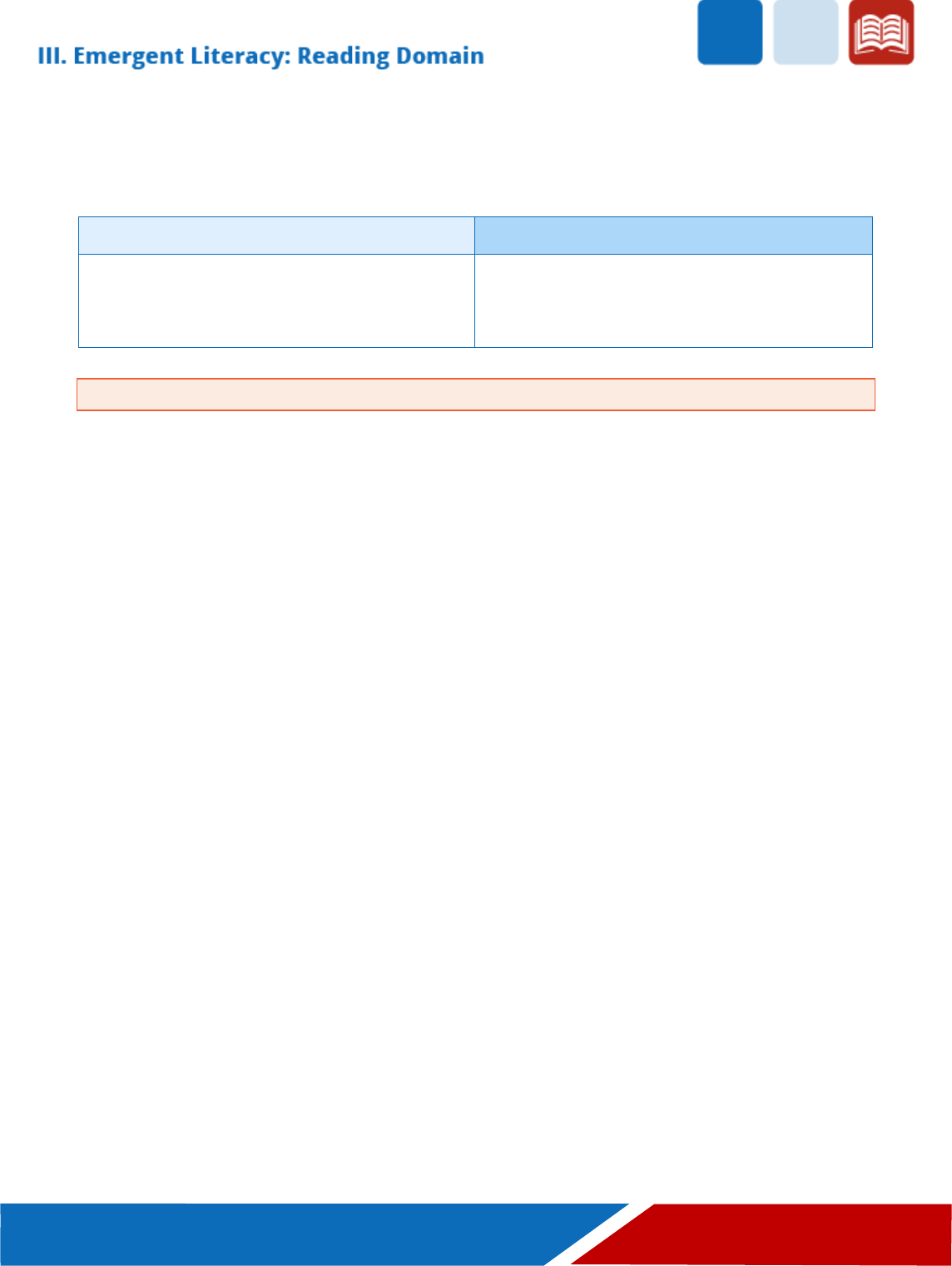
Emergent Literacy: Reading
30
• select a favorite book for the teacher to read during read aloud time
• select the reading/library center during free play
PK3 Outcome
PK4 Outcome
PK3.III.A.3 Child notices and connects meaning to
environmental print.
PK4.III.A.3 Child recognizes that all print carries
meaning and serves as a means for
communication.
Child Behaviors
The child may:
• recognize and “read” environmental print (e.g., the writing on a food container, signs, menus,
etc.)
• ask the meaning of text (e.g., posters, charts, or digital materials) encountered throughout the
classroom or school
• ask what a note from home says
• point to the words while pretending to read or listen to a story (e.g., a digital story or a story
read aloud)
B. Phonological Awareness
Phonological awareness is an auditory skill that involves the understanding of the sounds of spoken
language; it is the ability to detect and manipulate the sound structures at the sentence, word, syllable,
and phoneme level. The overarching term refers to a continuum of skills that are universal across
languages including sentence segmentation, alliteration, rhyming, syllabication, onset-rime (in English
only), and phonemic awareness. Research has shown that phonological awareness begins to develop in
children as young as 2.5 years old. See Appendix.
Children generally develop sensitivity to large units of sound, like words and syllables first, and
eve
ntually progress to sensitivity to individual phonemes, the smallest units of sound. For example,
children are able to detect and manipulate words in phrases before they can detect or manipulate
syllables, and they can detect and manipulate syllables before they can detect or manipulate phonemes.
Within the continuum of skills are varying levels of task complexity. To ensure learning is adequately
scaffolded, task difficulty is an important consideration for phonological awareness instruction. For
example, teachers should begin with easier tasks such as identification and blending (e.g., synthesis)
before introducing more challenging tasks such as segmenting and manipulation (e.g., adding, deleting,
or substituting). However, children do not need to master one skill or task before being introduced to or
practicing another skill or task.
Phonological awareness is highly predictive of success in beginning reading and writing, specifically
related to automatic decoding and encoding abilities. Phonemic awareness, the most advanced skill on
the continuum, facilitates children’s understanding of the individual sounds in spoken words and helps

Emergent Literacy: Reading
31
them make the connection that sounds can be represented by letters in print. Therefore, phonological
awareness and alphabet knowledge should work together, with skill development in one area
reinforcing development in the other. Once children demonstrate mastery in both alphabet knowledge
and phonemic awareness, they can benefit from the inclusion of letters in phonemic awareness
activities to begin building their understanding of the alphabetic principle.
Oral language proficiency in children’s native language supports the development of phonological
awareness in English for first- and second-language learners. English learners draw upon their
phonological awareness skills in their first language when developing phonological awareness in a
second language. English learners benefit from explicit and systematic phonemic awareness
instruction, specifically segmentation, blending, and manipulation.
For multilingual learners who are exposed to phonological awareness instruction only in English, it is
important to accept oral approximations of English sounds due to English proficiency level or articulation
difficulties rather than correcting them in the moment. Non-standard pronunciation does not indicate a
lack of understanding, and multilingual learners benefit more from targeted instruction rather than a
quick correction. It is also important to connect activities with context, often by adding a picture. For
example, if students are generating words that begin with /m/, a native English speaker has a repository
of vocabulary from which to draw based on all his oracy experiences from birth. A child who is just
beginning to speak English may not have a similarly sized mental word bank. Adding picture cards may
remind children of words they know or will allow them to sort cards into /m/ and “other” when the
teacher says the word.
PK3 Outcome
PK4 Outcome
PK3.III.B.1 Child recognizes when a word in a
spoken sentence is changed.
PK4.III.B.1 Child identifies the individual words in a
spoken sentence.
Child Behaviors
The child may:
• identify a word that changes in a sentence (e.g., If the two sentences are: "The cat sat." and
"The rat sat." the child will recognize that the word "cat" was replaced with "rat")
• clap (or do some other type of action like tapping, stomping, jumping, or holding up a finger) to
represent each individual word in a spoken sentence
• count the number of words in a sentence
• repeat a sentence spoken by the teacher and move a counter forward as each word in the
sentence is spoken
• change a word used in a sentence to make a new sentence (e.g., "Carlos plays with friends."
becomes "Kevaeh plays friends." or "Carlos plays with toys.")
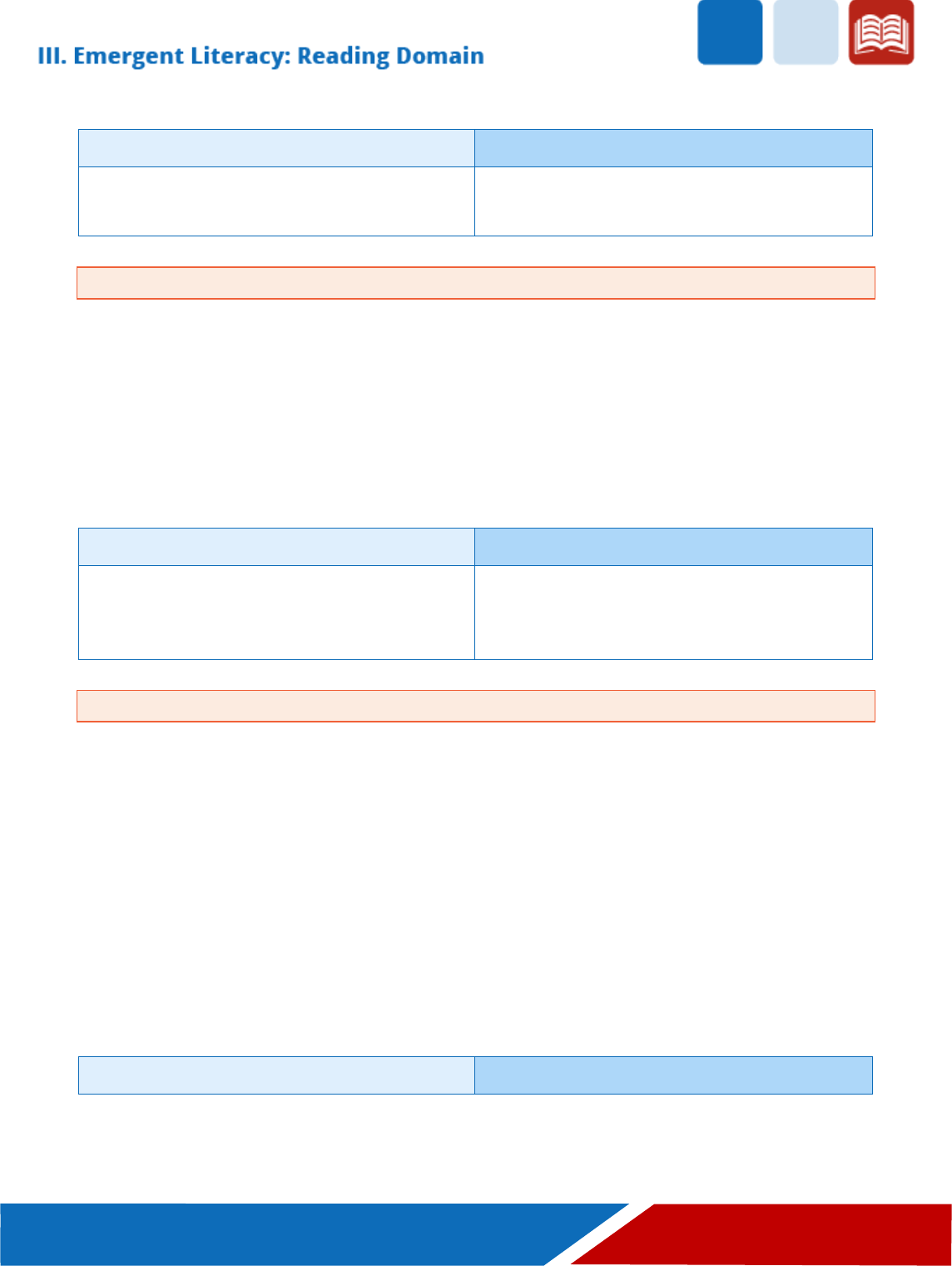
Emergent Literacy: Reading
32
PK3 Outcome
PK4 Outcome
PK3.III.B.2 Child begins to distinguish differences
between similar-sounding words.
PK4.III.B.2 Child distinguishes differences between
similar-sounding words.
Child Behaviors
The child may:
• during a rhyming game, the child demonstrates the difference between a “bat” (e.g., makes a
swinging motion) and a “pat” (e.g., pats top of head)
• point to the appropriate picture when prompted (e.g., when shown a picture of a goat and a
coat, the child correctly points to the picture that matches the word spoken)
• discriminate between similar initial consonant sounds (e.g., /b/ and /p/, /g/ and /k/, or /t/ and
/d/)
PK3 Outcome
PK4 Outcome
PK3.III.B.3 Child recognizes the individual words in
a compound word.
PK4.III.B.3 Child uses two familiar base words to
form a compound word with pictorial or gestural
supports.
Child Behaviors
The child may:
• blend two words together to create a new compound word (e.g., Teacher: “If I say the words
sun and flower what compound word can you make?” Child: “sunflower”)
• use picture cards to create compound words
• make compound words by responding with a second part of the word after the teacher has
provided the first part (e.g., Teacher: “What word can I add to “rain” to make a compound
word?” Child: “bow so you get rainbow” or “drop so you get raindrop”)
• segment a compound word by separating and naming the two smaller words that make up the
compound word (e.g., Teacher: “What two words do you hear when I say starfish?” Child: “star”
and “fish”)
PK3 Outcome
PK4 Outcome
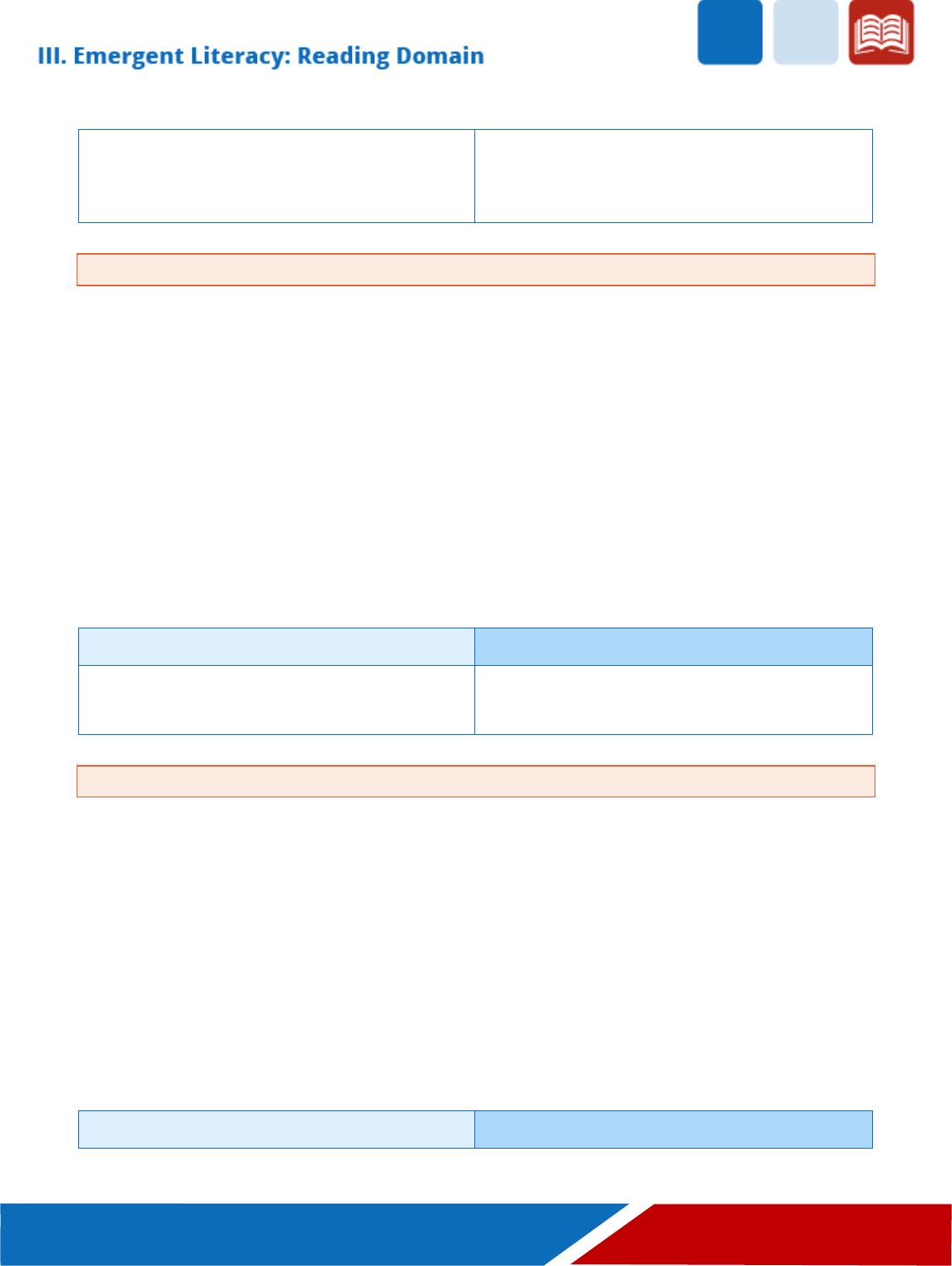
Emergent Literacy: Reading
33
PK3.III.B.4 *Three-year olds do not typically
develop word manipulation skills, so no outcome
is included*
PK4.III.B.4 Child manipulates compound words
with pictorial or gestural support.
Child Behaviors
The child may:
• take compound word picture cards apart by deleting either the first or second part and stating
the word that is left (e.g., “sunflower” - “sun” =” flower”)
• create a compound word by adding a word to the given word (e.g., A teacher might point to a
picture and ask, "What is a compound word that has the word rain in it?" and the child would
respond with, "rainbow" or "raincoat")
• play with words to make different compound words (e.g., If the child has the word “basketball”
and substitutes a picture of a basket with a picture of a foot, they now created the word
“football”)
• use movements to represent manipulation of combining words to make a compound word (e.g.,
using one hand to represent “rain” and the other hand to represent “coat,” clapping together to
make “raincoat”)
PK3 Outcome
PK4 Outcome
PK3.III.B.5 Child participates in oral syllabication
activities.
PK4.III.B.5 Child begins to blend and segment
syllables in multisyllabic words.
Child Behaviors
The child may:
• identify a segmented word by blending the syllables together (e.g., teacher says, /dī/-/nō/-
/saur/ and the child says “dinosaur”)
• provide the second syllable when the teacher holds up a picture and says the first syllable of the
word (e.g., teacher holds up a picture of a bucket and says “buck”; the child finishes the word by
saying “et”= “bucket”)
• clap, tap, or jump for each syllable in a familiar word (up to three syllables)
• identify the number of syllables in own name or a peer’s name
• sort picture cards or objects based on the number of syllables in the word
PK3 Outcome
PK4 Outcome
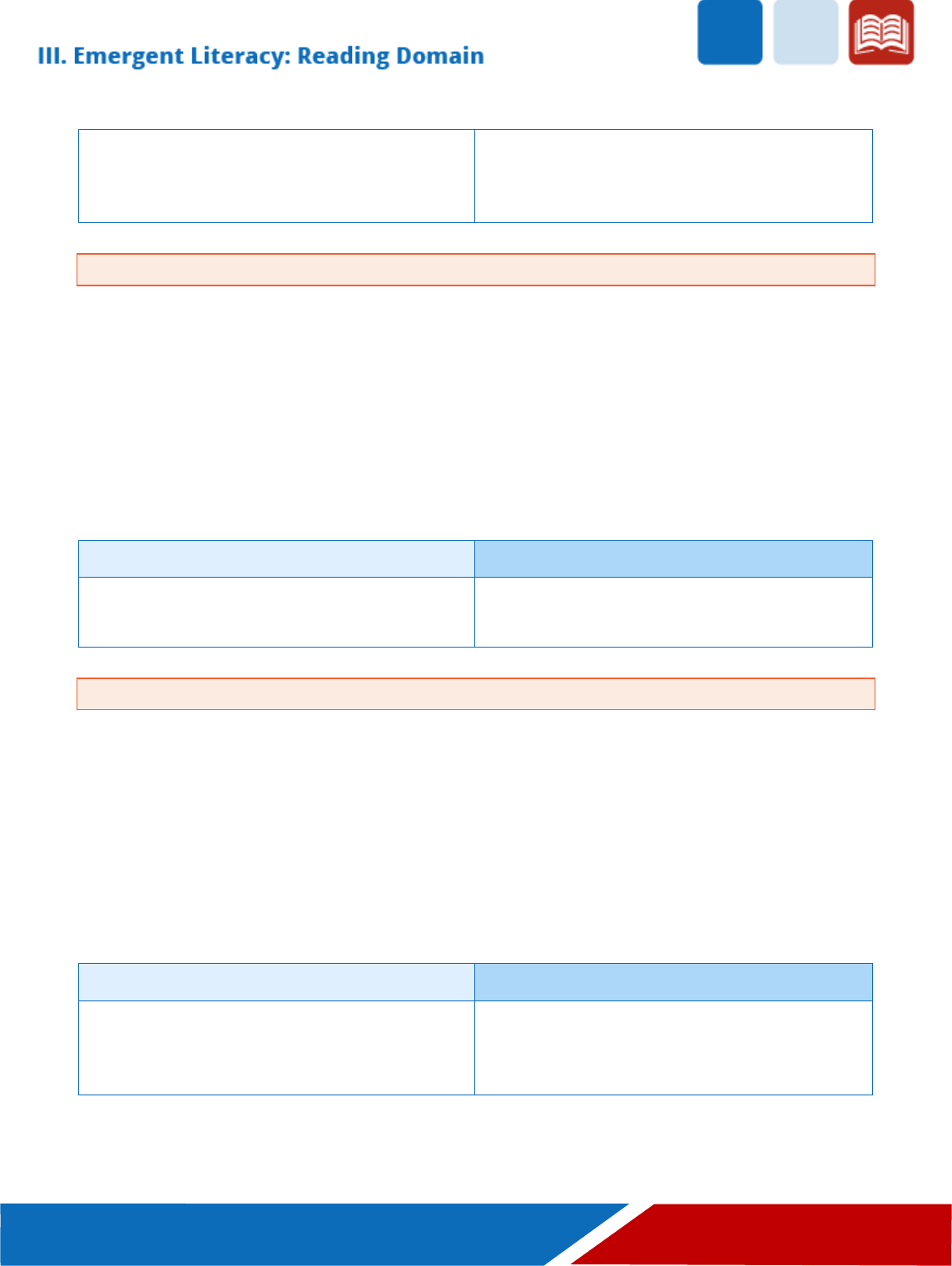
Emergent Literacy: Reading
34
PK3.III.B.6 Child uses rhyming words through
playful activities such as songs, nursery rhymes,
and fingerplay.
PK4.III.B.6 Child identifies rhyming words.
Child Behaviors
The child may:
• pair pictures or objects that rhyme
• give a thumbs up if two words rhyme or thumbs down if they do not
• state which word does not rhyme when listening to a list of three words within a story
• identify the words that rhyme in a nursery rhyme, poem, or book
• generate real or nonsense words that rhyme with a given word
• listen to two words that rhyme and produces a third word (real or nonsense) that rhymes with
the pair
PK3 Outcome PK4 Outcome
PK3.III.B.7 Child uses alliteration through playful
activities such as songs and read alouds.
PK4.III.B.7 Child identifies alliterative words with
pictorial support.
Child Behaviors
The child may:
• pair pictures or sort objects into groups by beginning sound
• identify words in rhyming songs that begin with the same sounds
• make silly phrases by changing the beginning sounds of all words to have the same sound (e.g.,
“Mappy Mirthday Moo Moo")
• play name games (e.g., producing a word that begins with same beginning sound as their name -
Jumping Jasmine, Dancing David, Silly Sofia, Funny Fernando)
• listen to two sentences within a story and identify which sentence has alliteration in it
PK3 Outcome
PK4 Outcome
PK3.III.B.8 Child participates in onset-rime
blending activities (in English only).
PK4.III.B.8 Child identifies a familiar one-syllable
word that is segmented by onset and rime (in
English only).
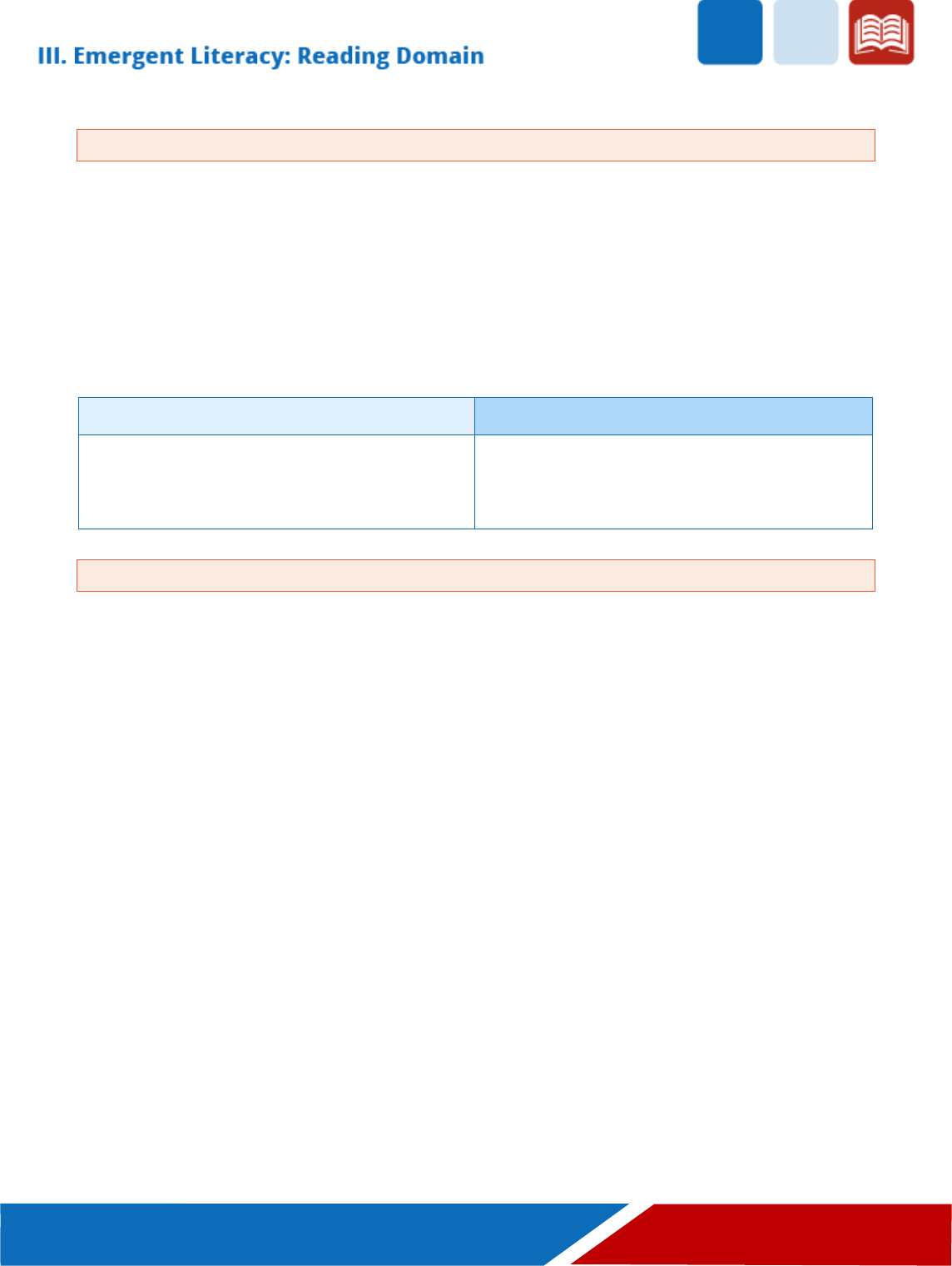
Emergent Literacy: Reading
35
Child Behaviors
The child may:
• identify a word that is segmented by onset-rime (e.g., if the teacher says /b/+/ark/ then child
will say “bark")
• select the appropriate picture from several pictures when the teacher says a word segmented
between the onset and rime (e.g., when shown several pictures, and adult says /r/+/ug/, child
selects the picture of the rug)
• look at a picture of an animal and when the teacher says the onset, the child finishes the word
by saying the rime (e.g., if the teacher says /t/ the child says /oad/)
PK3 Outcome
PK4 Outcome
PK3.III.B.9 *Three-year olds do not typically
develop phonemic awareness, so no outcome is
included*
PK4.III.B.9 Child blends and segments one-syllable
words by phonemes with visual or gestural
support.
Child Behaviors
The child may:
• watch an adult say a word segmented by phonemes, tapping a dot for each phoneme, and
correctly identifies the word by naming it or pointing to a picture/object that matches (e.g.,
teacher says, /b/- ŏ/-/x/ and child points to a box or says “box”)
• p
ull down a chip for each phoneme they hear, when the teacher says a word segmented by
phonemes
• select a picture or an object and uses sound boxes or gestures to accurately segment the
word by phoneme (e.g., child points to a hat and says /h/-/ ă/-/t/)
C. Alphabet Knowledge
Alphabet knowledge is an essential component of emergent literacy and is a strong predictor of success
in learning to read and write. Alphabet knowledge includes letter recognition, letter naming, letter-
sound correspondence, and alphabetization. The distinction between each component of alphabet
knowledge is identified below:
• letter recognition (a receptive skill): the ability to identify letters when asked to touch or point
to a letter*
• letter naming (expressive skill): the ability to name letters with automaticity
• l
etter-sound correspondence: knowledge of the common sounds – the sounds that a letter
represents most frequently
• alphabetization: the ability to say and place letters of the alphabet in sequential order

Emergent Literacy: Reading
36
Letter formation is also an important aspect of alphabet knowledge because learning how to write each
letter draws children’s attention to the similarities and differences among letter shapes. To support
young learners’ knowledge of letters, adults need to provide children with easy and repeated
meaningful interactions with written letters and words within the context of daily experiences and
engage them in activities that are fun and interesting. These experiences must integrate all components
of alphabet knowledge and should include many opportunities for children to see letters within the
context of written text. Relying solely on rote practice can result in frustration and negative attitudes
toward learning. Knowing how letters function in writing and how these letters connect to the sounds
children hear in words is crucial to children’s success in reading. Combined with phonological
awareness, letter knowledge is the key to children understanding the alphabetic principle. Children will
use this sound/letter connection to begin to identify printed words, such as their names and other
familiar words.
*Important things to note:
• In English, students generally identify letter names before letter sounds. However, in Spanish,
children tend to learn letter sounds before letter names. During Spanish alphabet knowledge
activities, students may know letter sounds before letter names.
• Children generally recognize capital letters before lowercase letters because uppercase letters
are more distinguishable than lowercase letters.
PK3 Outcome
PK4 Outcome
PK3.III.C.1 Child shows awareness of letters by
singing alphabet songs and recognizing some
frequently encountered letters (e.g., first letter of
name or letters in environmental print).
PK4.III.C.1 Child recognizes and names at least 20
letters (upper- or lower-case letters).
Child Behaviors
The child may:
• name letters on name cards, posters, books, and signs around the room
• identify specific letters in shared reading or writing experiences (e.g., points to a letter in a book,
circles a letter on a poster, etc.)
• recognize the letters in their own name (e.g., “If your name starts with ___, please stand up" or
"if you have a ___ in your name, touch your nose")
• match upper and lowercase letters, while recalling the name of the letters
• participate in letter recognition games or activities (e.g., alphabet bingo, alphabet arcs, letter
hunts, I Spy the letter..., etc.)
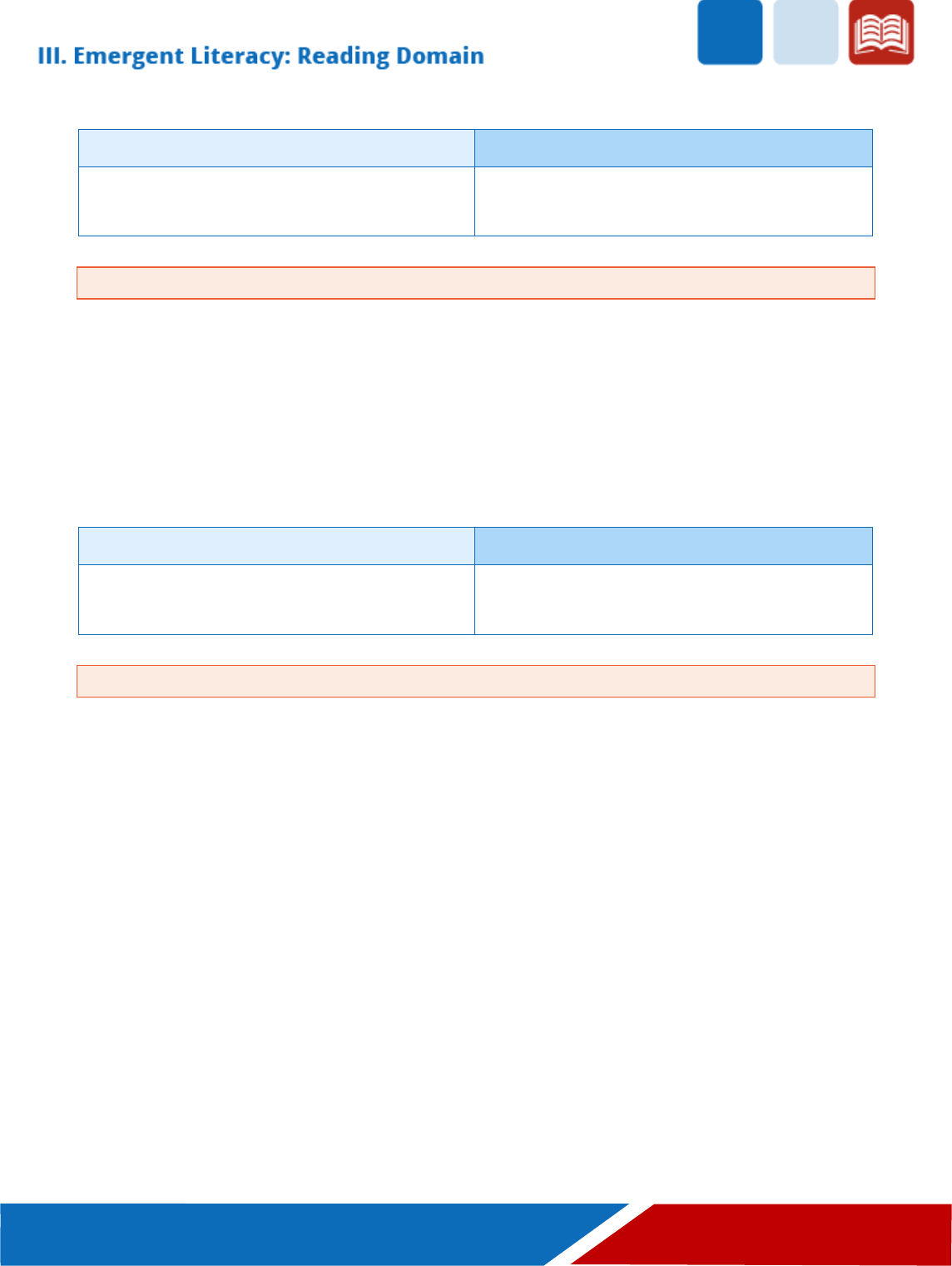
Emergent Literacy: Reading
37
PK3 Outcome
PK4 Outcome
PK3.III.C.2 Child identifies the letter associated
with the sound of the first letter of his name.
PK4.III.C.2 Child recognizes at least 20 distinct
letter-sound correspondences.
Child Behaviors
The child may:
• match a letter to the picture that begins with the corresponding letter sound
• identify the letter that corresponds with a specific letter sound (e.g., “I am thinking of a letter
that makes the /s/ sound. What letter am I thinking of? Can you find the letter that makes the
/s/ somewhere in the room?”)
• point to the letter that matches the sound heard when shown 2-4 letters
• categorize objects or pictures by beginning sounds, matching the sound to the printed letter
PK3 Outcome
PK4 Outcome
PK3.III.C.3 Child produces the correct sound for
the first letter of his name.
PK4.III.C.3 Child produces at least 20 distinct letter-
sound correspondences.
Child Behaviors
The child may:
• say the correct sound when shown a letter or given a letter name
• make the correct letter sound while pointing to a letter in a book or on a poster
• produce the sound of each letter in their name as they write each letter
• say the correct sound when shown a picture of a keyword for a specific letter (e.g., says /b/
when shown the picture of a boat)
D. Comprehension of Text
Exposure to many kinds of books, both fiction and nonfiction, helps prekindergarten children build
vocabulary, make connections to text, build schema, and background knowledge, and become familiar
with how stories and other types of texts work. Children develop concepts of story structures, character
actions, and knowledge about informational text structure which influences how they understand,
interpret, and link what they already know to new information.
Multilingual learners must have read aloud experiences in their home language regardless of bilingual
education or ESL program participation. These experiences are opportunities to learn everything
mentioned above without a language barrier. Teachers of multilingual students must communicate the
importance of home language read aloud experiences to families and support them as they provide
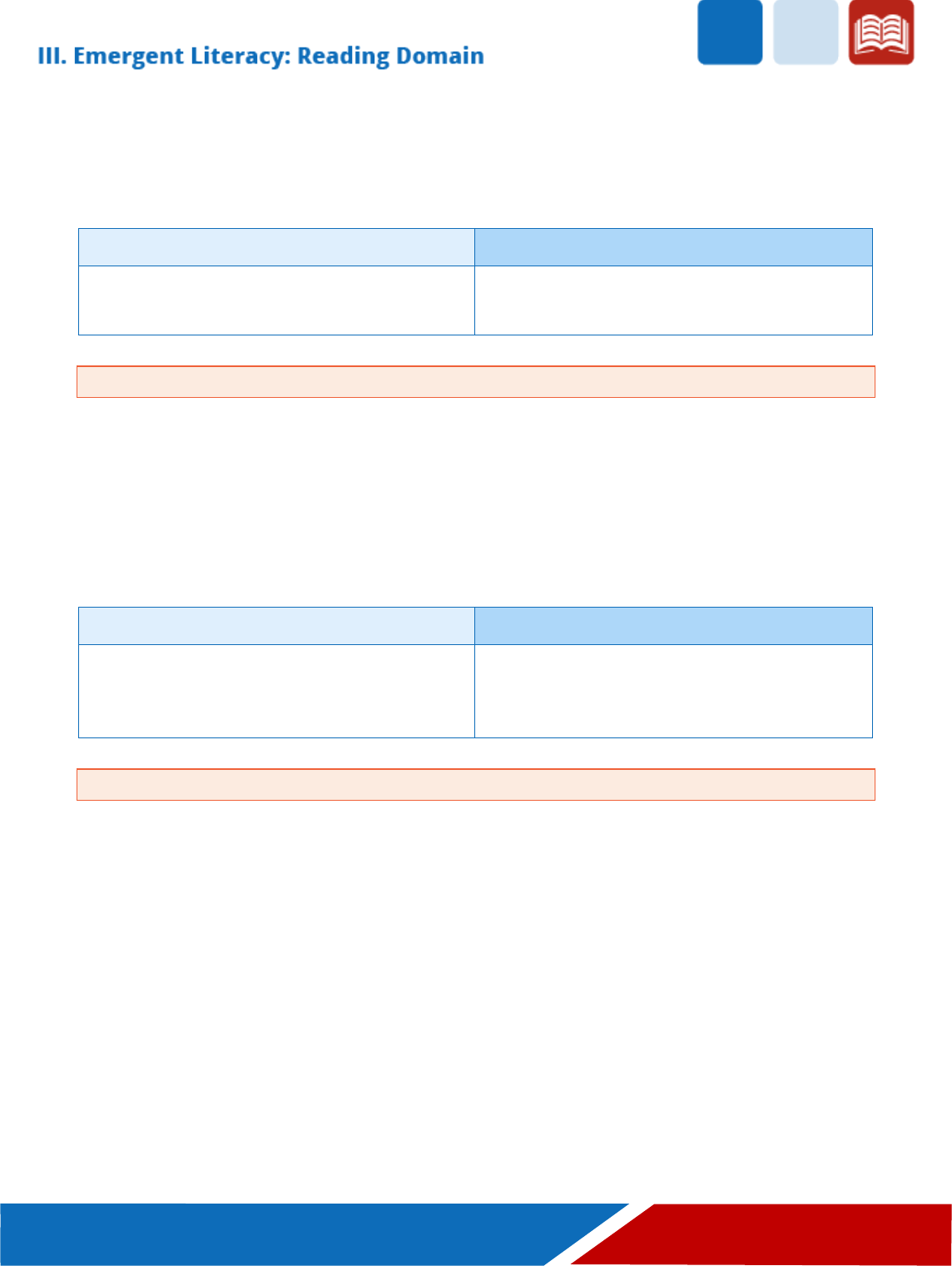
Emergent Literacy: Reading
38
these experiences at home. Multilingual learners who have experiences with stories read aloud in the
home language can be prompted to make connections between texts in different languages.
PK3 Outcome
PK4 Outcome
PK3.III.D.1 Child re-enacts a story after it has been
read aloud.
PK4.III.D.1 Child retells or re-enacts a story with a
clear beginning, middle, and end.
Child Behaviors
The child may:
• participate in acting out a familiar story in whole group and small group settings
• retell the main events of a story in sequence
• use the pictures in the books to recall what is happening in the story
• organize pictures to represent the accurate sequence of events in a story read aloud
• recall characters, setting, and main idea of a story read aloud
PK3 Outcome PK4 Outcome
PK3.III.D.2 Child makes personal connections to
books read aloud.
PK4.III.D.2 Child uses information learned from
books by describing, relating, categorizing, or
comparing and contrasting.
Child Behaviors
The child may:
• relate own experiences to facts learned from books (e.g., makes connection to garden at
home when reading about plant life cycles) or events in a story (e.g., relates a personal trip
to the zoo to the character’s trip to the zoo)
• describe how to do something learned from reading a book
• reference information learned from a book when sorting objects (e.g., when sorting pictures
based on needs and wants, the child explains the decision by referring back to how the story
distinguished needs and wants)
• use information learned from a book to make comparisons about things in his world (e.g.,
after reading a book about community helpers, the child says, “My mom is a veterinarian.
That is like a doctor, but instead of helping people she helps animals.”)
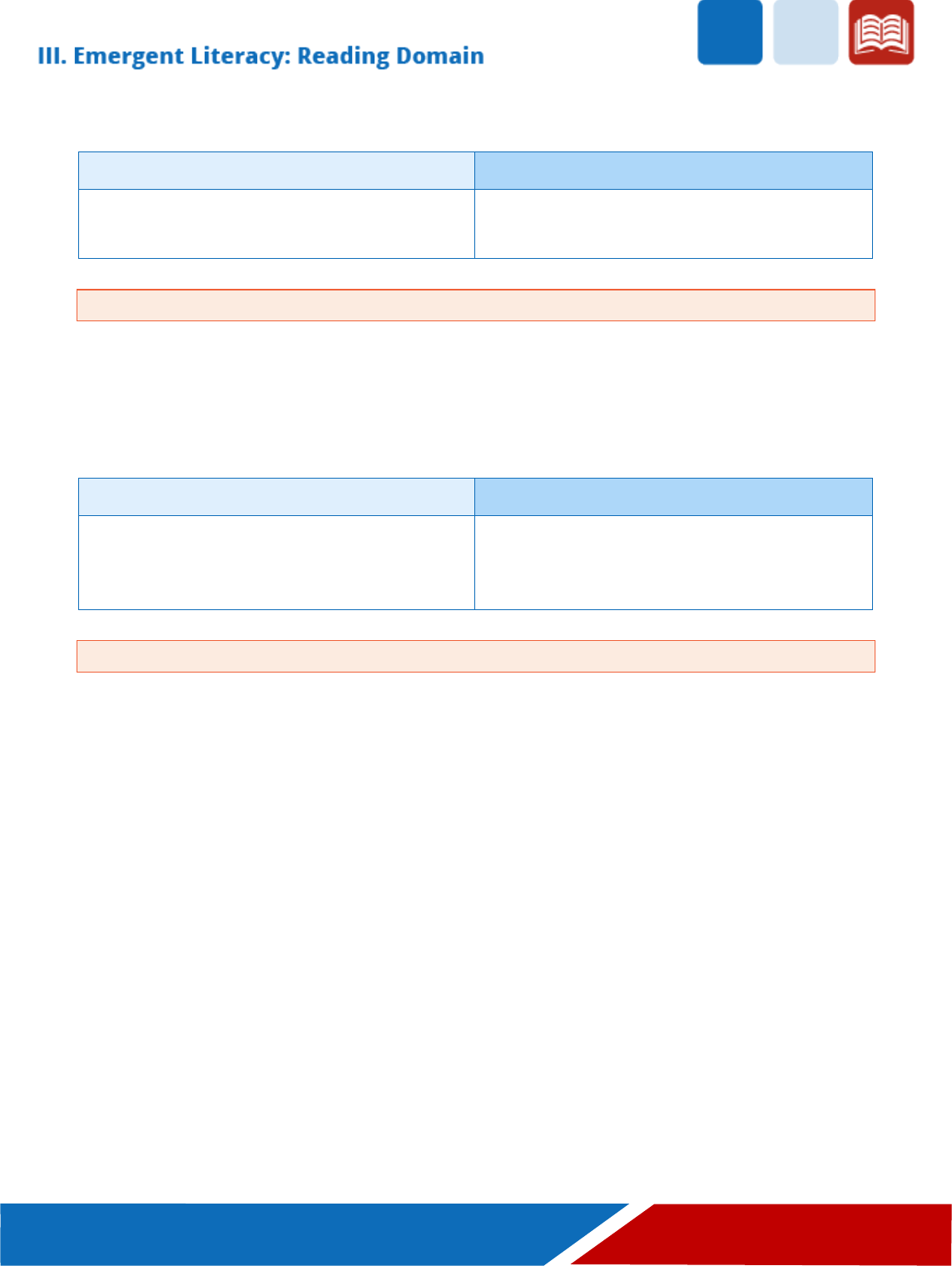
Emergent Literacy: Reading
39
PK3 Outcome
PK4 Outcome
PK3.III.D.3 Child asks and answers age-
appropriate questions about a book.
PK4.III.D.3 Child asks and responds to questions
relevant to the text read aloud.
Child Behaviors
The child may:
• ask and answer questions about the story details and events
• ask and answer questions about the characters or actions within a story
• ask and answer questions about information learned from a text
PK3 Outcome PK4 Outcome
PK3.III.D.4 Child attempts to make predictions by
looking at the cover of a book or the pictures
within a story.
PK4.III.D.4 Child makes inferences and predictions
about a text.
Child Behaviors
The child may:
• actively participate while being read to by predicting what might happen next in the story
• predict what might happen in a book based on the cover or title of the book or by doing a
picture walk prior to reading a story
• use illustrations to make inferences about how a character might feel or consider why a
character acted in a certain way
• discuss how the story might change if it had different characters, a changed setting, or an
alternate ending
• tell what might happen next if the story continued
E. Concepts of Print
Through daily experiences with a variety of print materials, young children delight in discovering the
connections between spoken and written words. Frequent exposure to print allows prekindergarten
children to understand that print carries meaning and encourages them to explore what print is used for
and how it works. Children will begin to recognize the distinction between letters, words, sentences,
punctuation marks, and images. They will also deepen their understanding of how books work, including
print directionality and appropriate handling of books, and learn how to hold and care for books. These
print concepts and skills can be taught explicitly, modeled through shared reading experiences, and
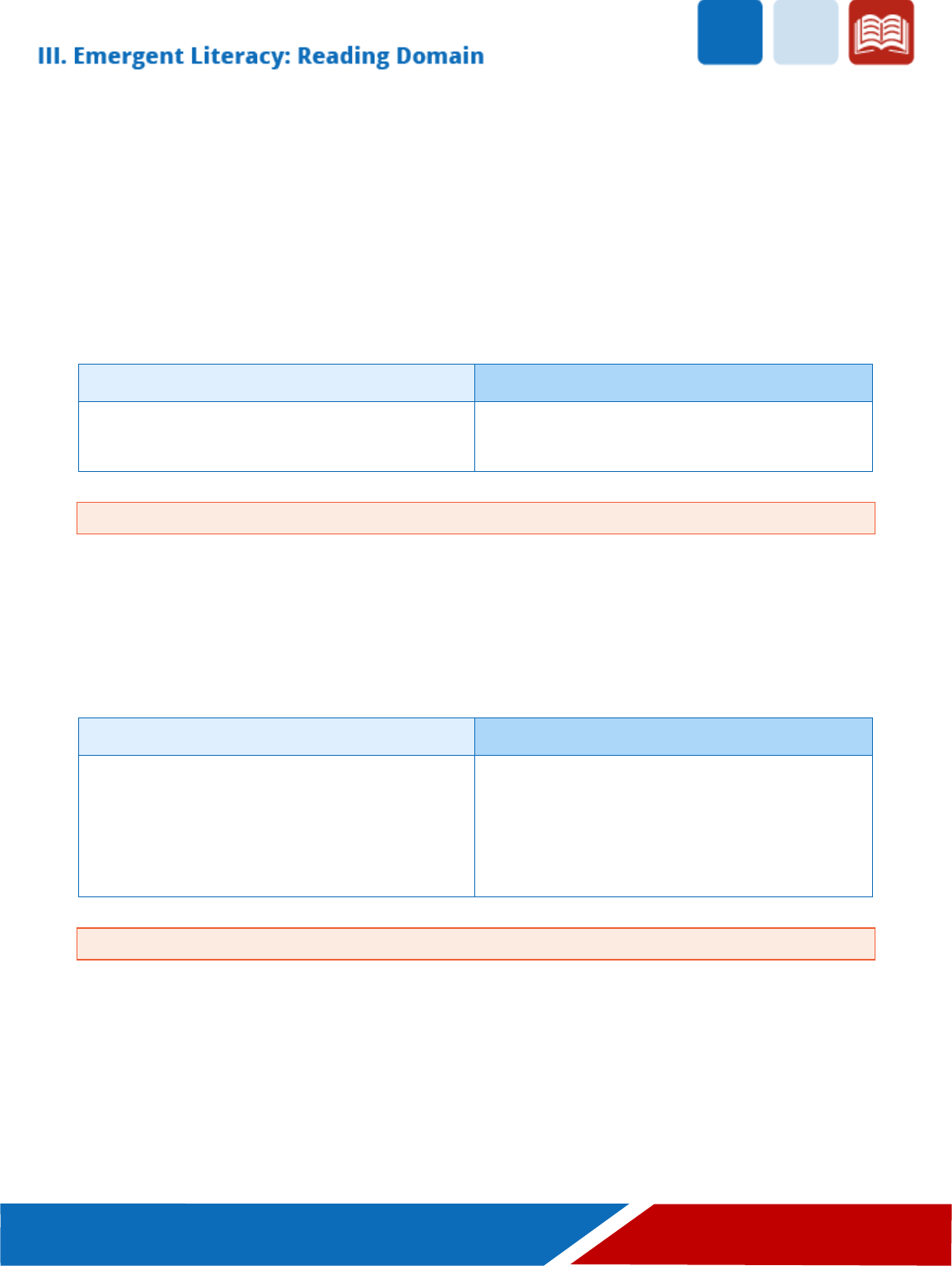
Emergent Literacy: Reading
40
reinforced through print-rich learning environments. Print-rich learning environments incorporate
labels, signs, letters, menus, magazines, digital media, and storybooks into every aspect of the day.
Multilingual learners should be exposed to print in both the home language and English. Targeted
instruction should be provided for students whose home language differs from English to explicitly
compare characteristics of the two print systems, rather than elevate print concepts in one language
over another. This will reinforce the transferability of many print concepts across both languages and
help children understand key distinctions.
PK3 Outcome
PK4 Outcome
PK3.III.E.1 Child can distinguish between pictures
and print.
PK4.III.E.1 Child can distinguish between elements
of print including letters, words, and pictures.
Child Behaviors
The child may:
• point to the print or pictures in a book when prompted
• point to specific letters within a word when prompted
• use a pointer or highlighting tape to identify a letter or word when prompted
• sort letters, words, and pictures into their corresponding categories
PK3 Outcome
PK4 Outcome
PK3.III.E.2 Child handles books with increasing
skill and imitates reading with awareness of
directionality (e.g., imitates reading text across a
page).
PK4.III.E.2 Child holds books right side up and
demonstrates understanding of print directionality
(e.g., knows where a book starts and ends, turns
pages, points to words left to right, top to bottom,
with correct sweeping).
Child Behaviors
The child may:
• correctly turn the pages in a book from beginning to end
• imitate reading behaviors (e.g., moving top to bottom and left to right; return sweep, etc.)
on charts, lists, and big books
• use a pointer or finger to track print in big books or enlarged text as the teacher is reading
• accurately model left-to-right directionality when reading labels around the room (e.g.,
placing a finger or pointer on the first letter of a word and moving it underneath from left to
right as the word is read aloud by an adult or the child)
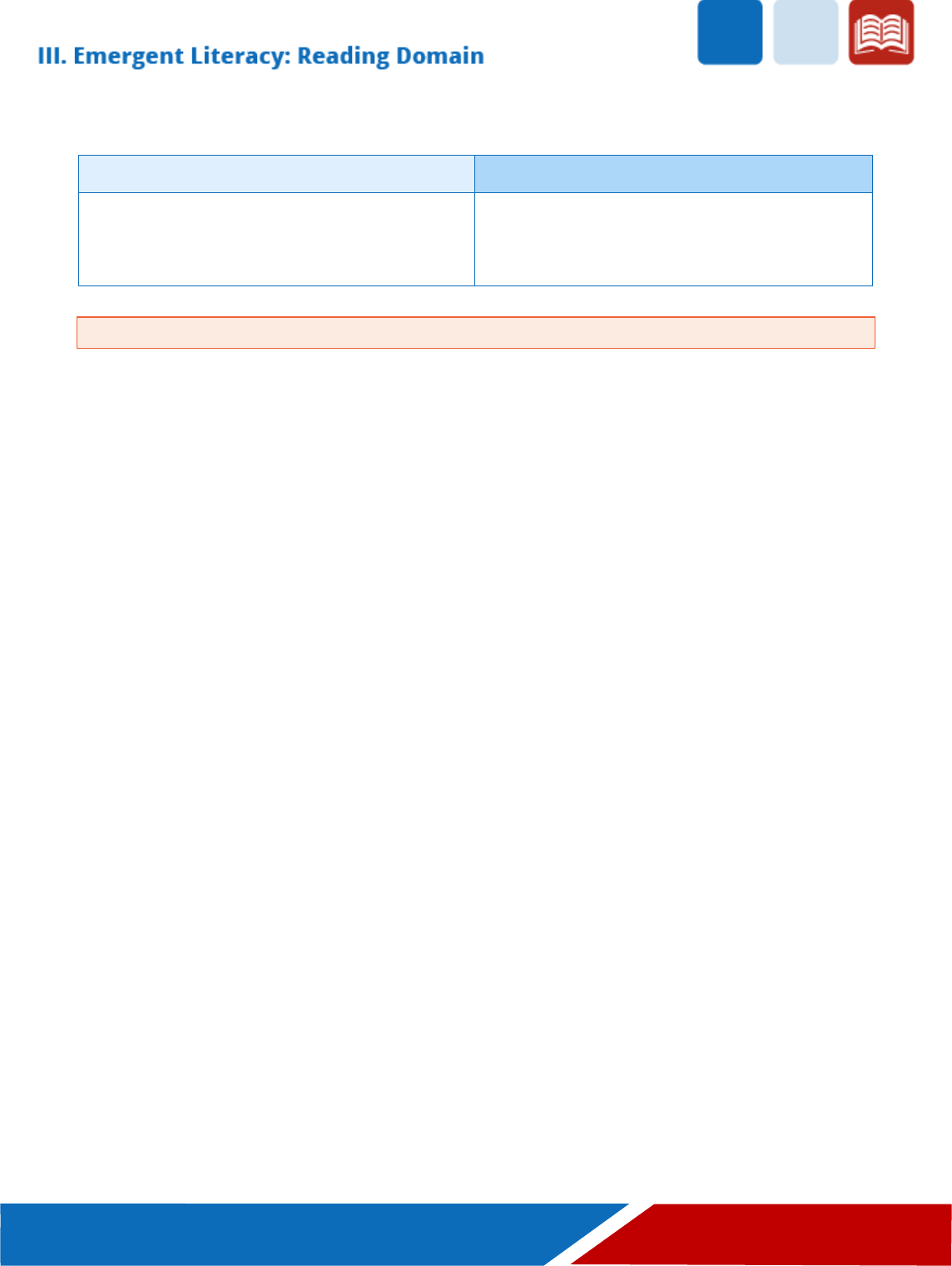
Emergent Literacy: Reading
41
PK3 Outcome
PK4 Outcome
PK3.III.E.3 Child begins to notice the basic features
of print (e.g., repeating words, space between
words, punctuation vs. letters).
PK4.III.E.3 Child can identify some conventional
features of print that communicate meaning
including end punctuation and case.
Child Behaviors
The child may:
• point to or name a period at the end of a sentence
• recognize different types of punctuation (e.g., period, question mark, exclamation) even if
they don't understand the purpose of each kind
• write name with the correct case (e.g., capital letter at the beginning of the name and
lowercase letters for the rest)
• recognize that the first letter in a name is capitalized
• recognize that the first word in a sentence is capitalized

Emergent Literacy: Writing
42
IV. Emergent Literacy: Writing Domain
Prekindergarten children begin to notice, imitate, and explore the many ways adults use writing to
communicate. Early writing experiences may include asking adults to write their names, signs, and
letters for them and progresses to independently imitating adults, using marks to represent their
own thoughts and ideas. Through these early writing experiences, young children develop initial
understandings about the forms, features, and functions of written language. Over time, children’s
writing attempts more closely approximate conventional writing. In prekindergarten classrooms,
teachers serve as models and guides, writing for different purposes for and with children.
Fine motor skills may impact children’s ability to write legibly; however, this should not limit their
opportunities to write for meaning. The child’s level of fine motor development should determine the
tools and the size of the surfaces that are provided for writing experiences. Fine motor skills can be
developed alongside writing and through writing as children progress through the developmental
stages.
The Emergent Literacy: Writing Domain of the Texas Prekindergarten Guidelines is divided into the
following skills: motivation to write, writing as a process, and conventions in writing. See Appendix.
A. Motivation to Write
As young children watch adults write for many purposes, they develop the understanding that print
conveys meaning and become motivated to write by engaging in drawing or scribbling to communicate.
They will sketch lines and scribble “notes” in an attempt to imitate adults’ writing behaviors and begin
to make connections between print and spoken words. Eventually their writing abilities will progress,
and they may begin to use letters or letter strings to communicate. It is important to remember that all
efforts to convey meaning in the form of scribbles, letter-like forms, or strings of letters should be
celebrated. Teachers play an important role in the development of prekindergarten children’s emergent
writing by encouraging them to communicate their thoughts and record their ideas.
PK3 Outcome
PK4 Outcome
PK3.IV.A.1 Child engages in free-choice drawing
and writing activities.
PK4.IV.A.1 Child intentionally uses marks, letters,
or symbols to record language and verbally shares
meaning.
Child Behaviors
The child may:
• use letter-like shapes when writing or making labels in learning centers
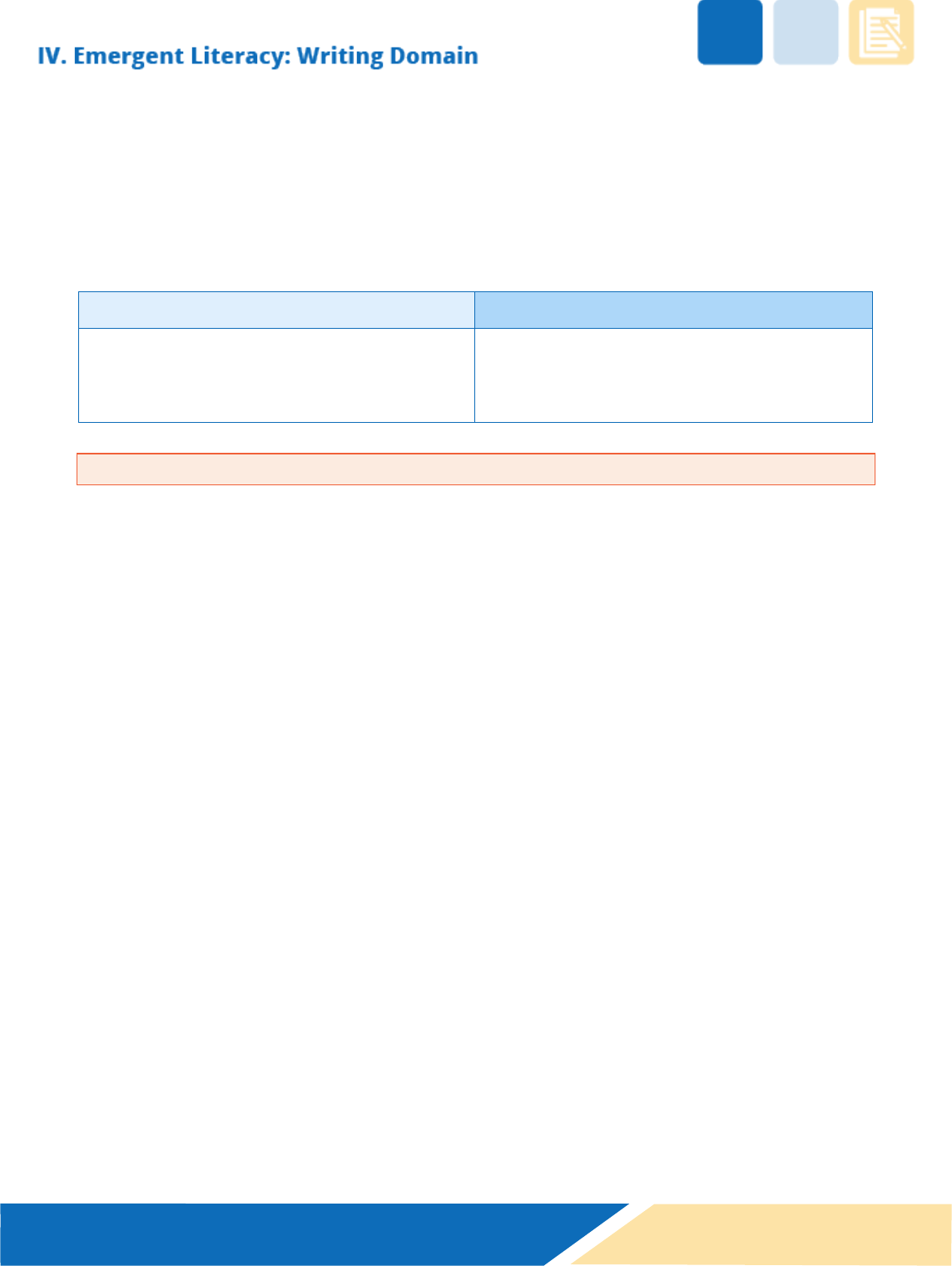
Emergent Literacy: Writing
43
• attempt to write letters to represent a word as a caption under a drawing and “reads” it to an
adult or peer
• write a story or message using mock letters, symbols, or other marks and “reads” it to the
teacher
• label pictures to tell a story
PK3 Outcome
PK4 Outcome
PK3.IV.A.2 Child attempts to draw and write for
many purposes and begins to explore different
writing tools.
PK4.IV.A.2 Child independently draws and writes
for many purposes to communicate ideas, using a
variety of writing tools.
Child Behaviors
The child may:
• draw and attempt to write to share a personal experience (e.g., petting the animals at the zoo or
eating cake at a birthday party)
• draw and label pictures to tell a story
• use various writing utensils and types of paper to create personalized cards that include drawing
and writing
• make labels, signs, or menus to contribute to learning centers, using many different types of
writing utensils and paper
• use a journal or hand-made paper booklet to record ideas or write stories through drawings and
writings
B. Writing as a Process
As young children begin to understand that marks convey meaning (what they think, they can say; and
what they say, they can read and write), it is important to model that writing is not simply about a
product. Writing is a thought process that moves from thinking of an idea to a well-developed idea or
piece of writing (one the young author is proud to share). Teachers who interact with children to
compose a piece of writing over a series of days, using modeled, shared, and/or interactive writing
expose children to the process of prewriting/brainstorming, writing/drafting, revising (what the writing
sounds like), editing (what the writing looks like), and publishing/sharing in a way that is
understandable. Children’s ability to engage in each of the stages of the writing process develops over
time. Guiding children through the process of taking a piece of writing from the “thought stage” to the
“sharing stage” motivates children to write and helps them see and understand the power of using print
to convey meaning. Multilingual students who begin writing in two languages will also learn which
language is more appropriate to use based on context and audience.
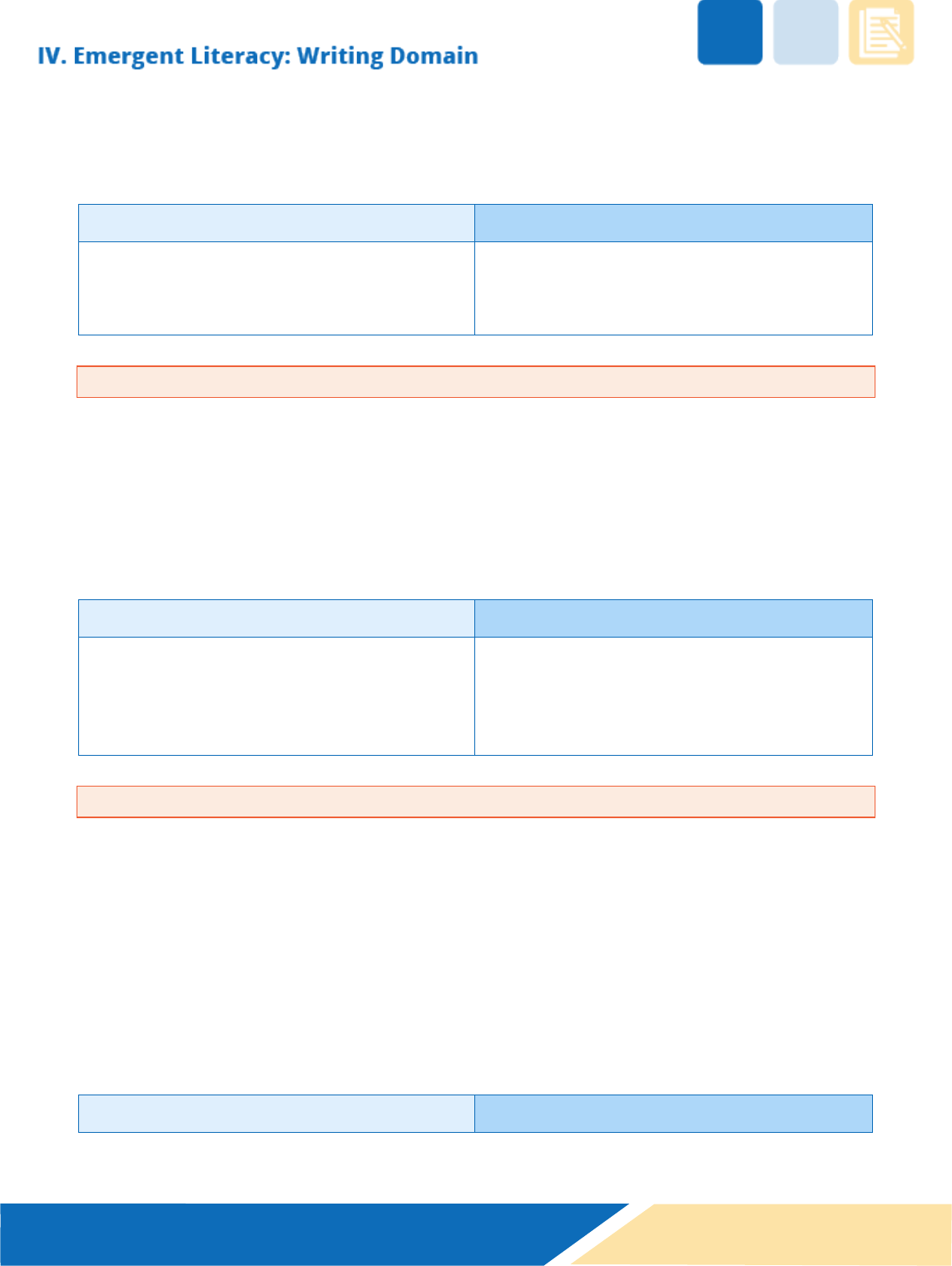
Emergent Literacy: Writing
44
PK3 Outcome
PK4 Outcome
PK3.IV.B.1 Child discusses and contributes ideas
for drafts composed in whole/small group writing
activities with adult prompting.
PK4.IV.B.1 Child discusses and contributes ideas for
drafts composed in whole/small group writing
activities.
Child Behaviors
The child may:
• participate in brainstorming ideas for what to write about during a shared or interactive writing
experience
• share the pen with the teacher to add pictures, letters, or familiar words during an interactive
writing experience
• contribute relevant ideas to a shared writing activity
PK3 Outcome
PK4 Outcome
PK3.IV.B.2 Child observes and discusses ideas for
revising (add, take out, change) drawings and/or
written words in whole/small group writing
activities.
PK4.IV.B.2 Child interacts and provides suggestions
for revisions (add, take out, change order) and
edits (conventions) in whole/small group writing
activities.
Child Behaviors
The child may:
• contribute ideas for adding details to the drawings and words of a story
• share ideas for how to change the details (e.g., a character, the ending, the setting, etc.) of a
piece of writing
• make suggestions for deleting parts of a piece of writing that do not belong
• notice when something that has been written doesn’t make sense or sound right when read
aloud (e.g., incorrect sequence, improper word usage, inaccurate tense, etc.)
• notice when there is incorrect punctuation or a need for punctuation and suggests a change in a
piece of writing (some prompting may be needed)
PK3 Outcome
PK4 Outcome
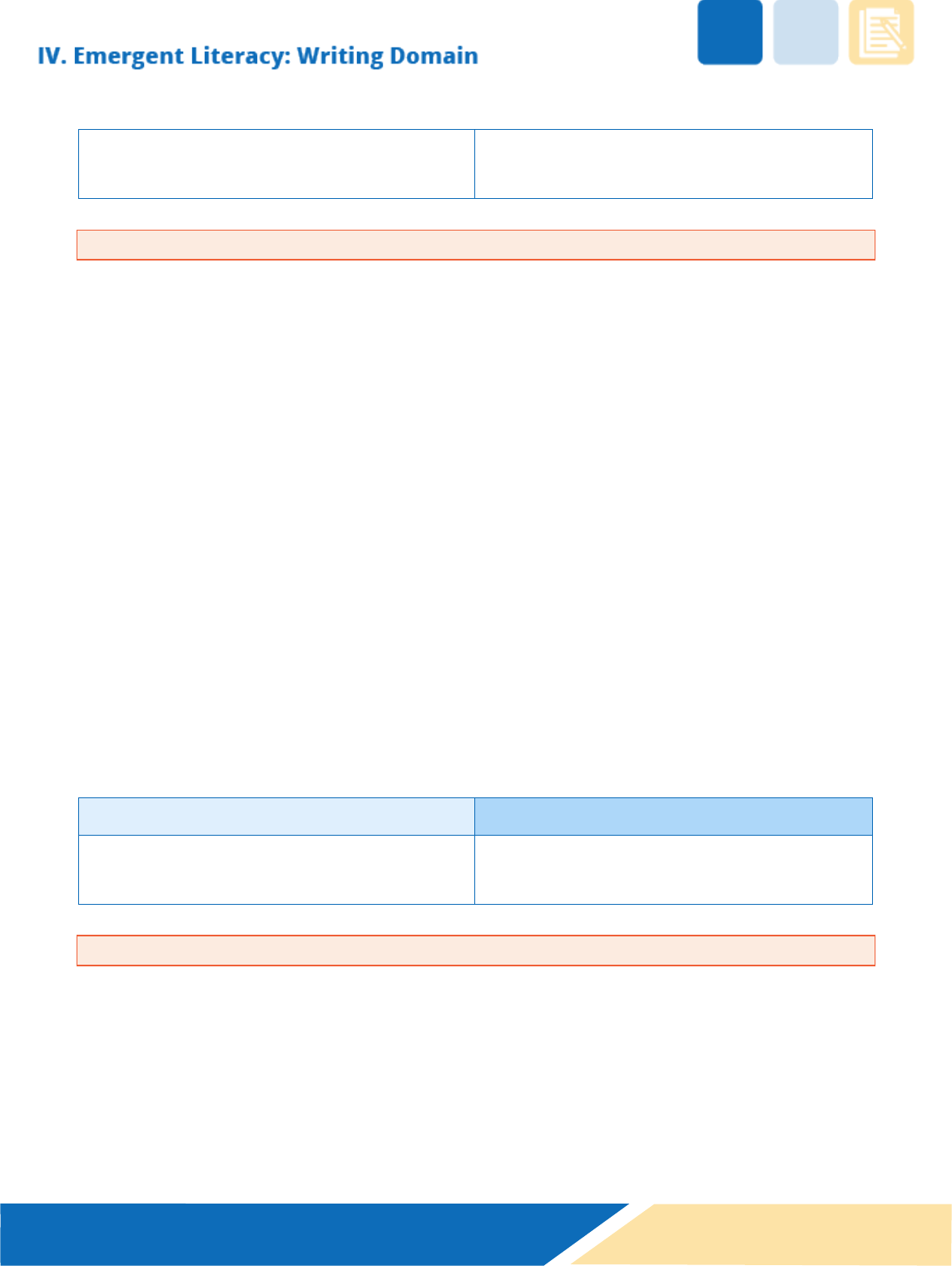
Emergent Literacy: Writing
45
PK3.IV.B.3 Child shares written products with
others.
PK4.IV.B.3 Child shares and celebrates class-made
and individual written products.
Child Behaviors
The child may:
• read and answer questions about own writing (drawings, labels, and/or written representations
of words) with an adult or peers
• engage in rereading writing that has been developed collaboratively (e.g., shared and/or
interactive writing experiences)
• present individually written work to the class during share time
• actively listen to peers while they share their experiences and will respond appropriately (e.g.,
claps for peers, says "thank you for sharing", waits turn, asks thoughtful questions about their
peers’ work)
C. Conventions in Writing
Foundational writing skills (also known as conventional writing skills) are important predictors of
children’s future reading and writing skills. Just as children learn to talk by talking, children learn
concepts of print through interacting with print. To children, it may appear that writing is simply talk
that has been written down. However, there are rules that apply to writing that do not apply to
speaking. These specific rules that govern how to record thoughts in writing must be learned so children
can become more proficient at conveying their thoughts and actions. Shared and/or interactive writing
experiences can help children better understand these conventions of writing.
PK3 Outcome
PK4 Outcome
PK3.IV.C.1 Child attempts to write some letters of
own name (usually beginning with the first letter).
PK4.IV.C.1 Child writes first name (or nickname)
using legible letters in the proper sequence.
Child Behaviors
The child may:
• correctly place letters from a name puzzle in order and then practices writing name on a white
board
• copy or write name using sensory materials (e.g., on a “gel” bag, with shaving cream, or in sand)
• write first name from memory on attendance chart, center waiting lists, in journals, and on
artwork
• sign name on letters or cards (e.g., thank you note to a visitor or a birthday card to a friend)
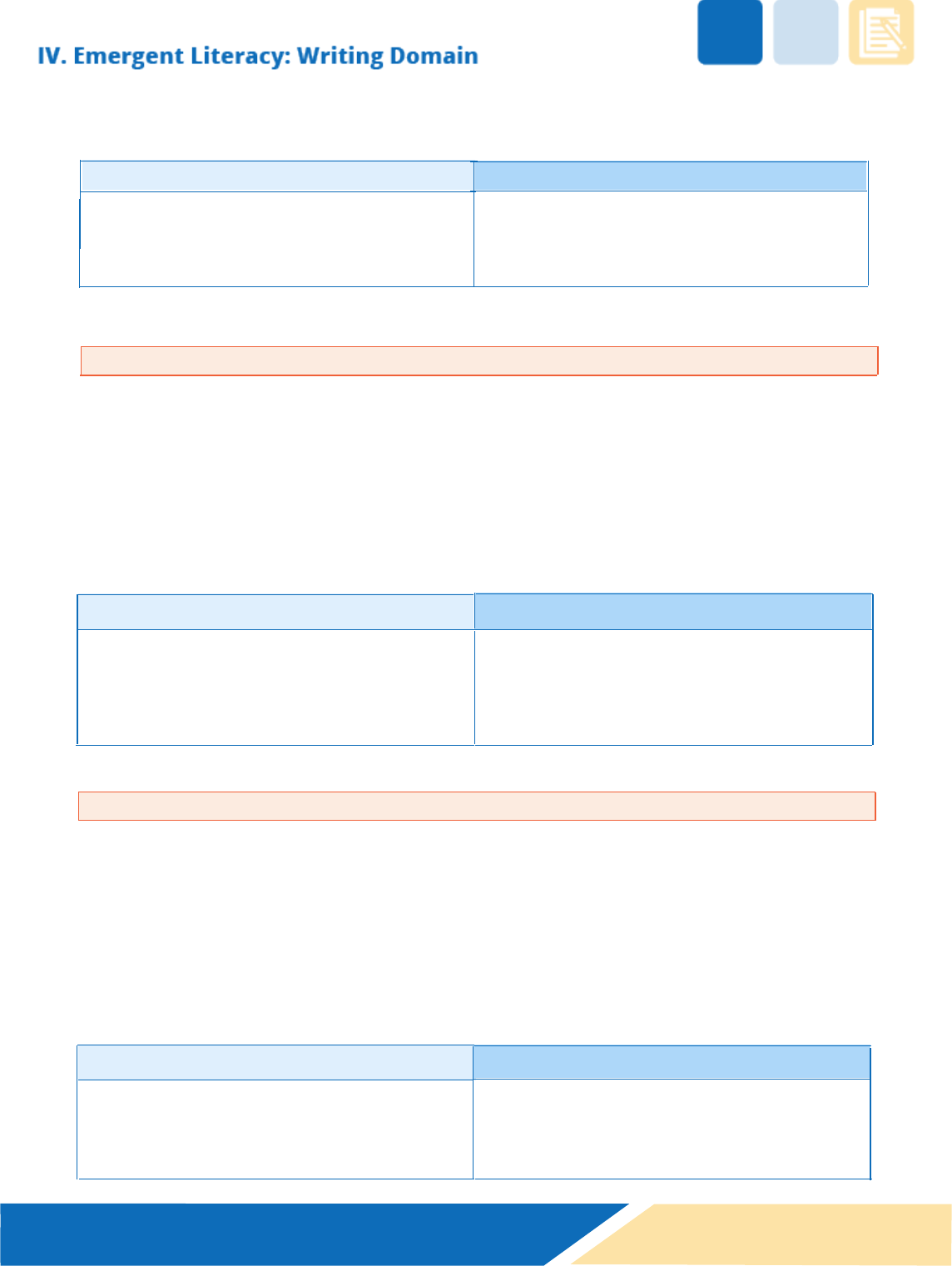
Emergent Literacy: Writing
46
PK3 Outcome
PK4 Outcome
PK3.IV.C.2 Child uses drawings, scribbles, and
mock letters to communicate ideas.
PK4.IV.C.2 Child progresses from using scribbles
and mock letters to forming letters and letter
strings as a way to communicate.
Child Behaviors
The child may:
write known letters spontaneously to represent words when composing a message
add labels to drawings, using one or two letters or letter strings to represent words
write regularly in journals or blank books, using drawings, letter strings or letters to represent
words
PK3 Outcome
PK4 Outcome
PK3.IV.C.3 Child begins to write using letter-like
forms.
PK4.IV.C.3 Child begins to write familiar words
using letter-sound correspondences, often using
letters associated with beginning and/or ending
sounds to write words.
Child Behaviors
The child may:
use letter-like forms and actual letters to represent their name
use approximation spelling to write simple CVC words by applying knowledge of letter-sound
correspondence, but sometimes misses the medial sounds
attempt to write complex words, using letters to represent the sounds heard (e.g., writes btl and
says, “I wrote the word beautiful.”)
use letter walls or labels from around the room to correctly write familiar words
PK3 Outcome
PK4 Outcome
PK3.IV.C.4 Child begins to show understanding of
directionality (e.g., attempts to write top to
bottom, left to right), but may still start at
random places on a page.
PK4.IV.C.4 Child uses appropriate directionality
when writing (e.g., top to bottom, left to right).
•
•
•
•
•
•
•
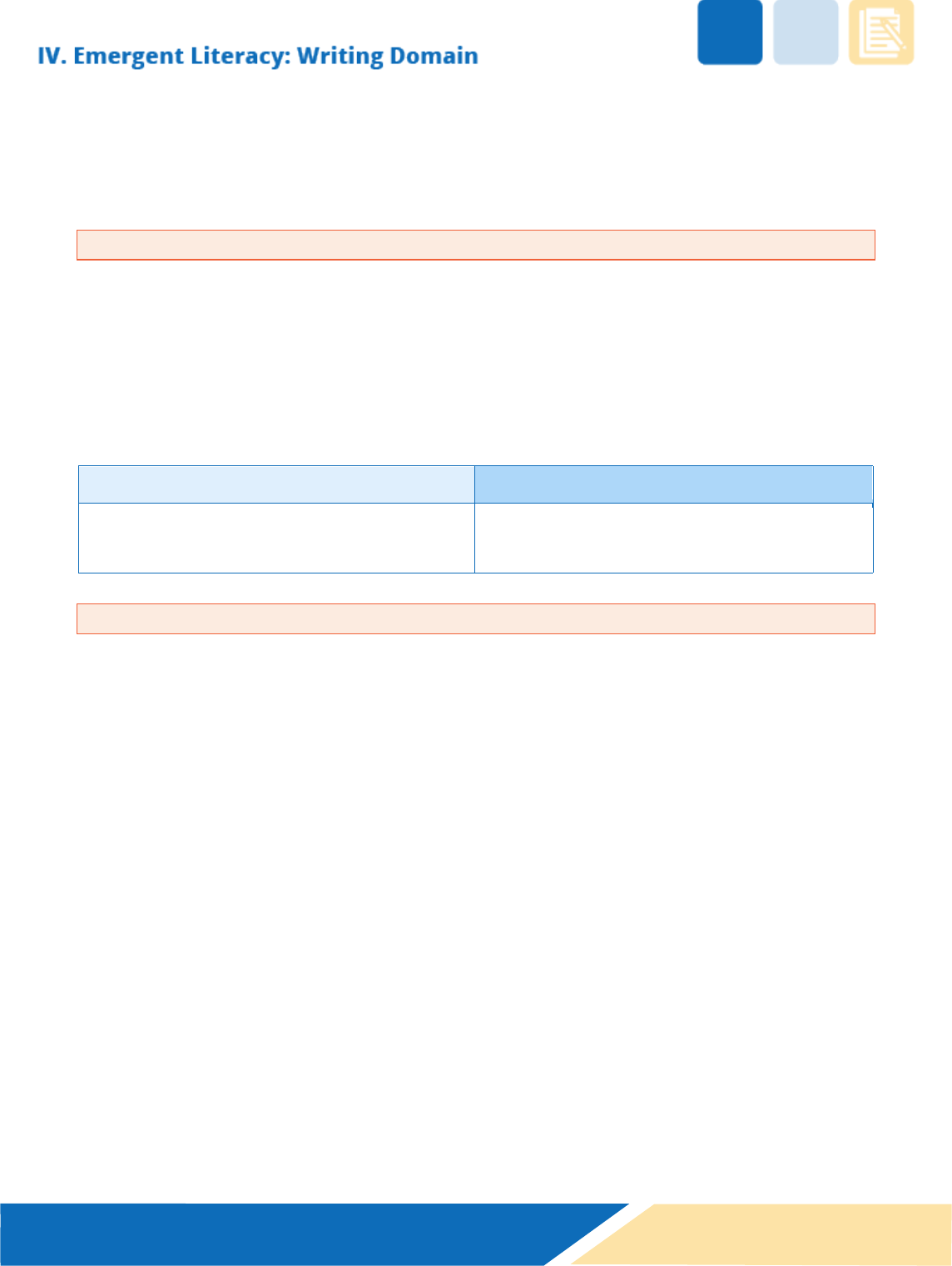
Emergent Literacy: Writing
47
Child Behaviors
The child may:
• write a list starting at the top of the page and moves downward accordingly
• write starting on the left side of paper and progresses to the right
• write more or less in a horizontal line
• write with the correct sweep to begin a second line of text (e.g., starting below the first line in a
left to right direction)
PK3 Outcome
PK4 Outcome
PK3.IV.C.5 *There is not enough research
to support the inclusion of a PK3 outcome*
PK4.IV.C.5 Child begins to experiment with
punctuation when writing.
Child Behaviors
The child may:
• write and put punctuation at the end of the entire piece
• write and put punctuation after each word or in sporadic places
• correctly add missing punctuation to interactive and independent writing, with teacher
prompting

Mathematics 48
III. Emergent Literacy: Read ing Domain
V. Mathematics Domain
Prekindergarten children’s mathematical understandings are built on informal experiences acquired at a
very early age. For example, young children know immediately if someone gets more cookies than they
do simply by looking at the amount of cookies given. Teachers can build upon these informal
foundational mathematical experiences by:
1.) planning a rich environment where math concepts can be practiced,
2.) offering sequential learning experiences that give children the opportunity to learn math
concepts and skills, and
3.) taking advantage of the opportunities in the classroom where mathematical reasoning is
meaningful for the child.
The classroom environment can effectively support mathematical competencies. Those competencies
require the use of informal representation of math concepts. Abstract symbols, no matter how carefully
designed or simplified, cannot involve the child’s senses the way real materials can. Real materials can
be maneuvered to demonstrate the math concept concretely and can be experienced visually by the
child. Concrete representation such as counters, tally marks, fingers, or other objects help children
create connection to math concepts. In addition, concrete objects allow multilingual learners the
opportunity to demonstrate their mathematical knowledge even if they do not have the language to
express it yet. As children gain comfort with concrete representation, they will begin to use pictorial
representations which prepare them for abstract representations.
• Concrete representation: the child counts to five to join a set of two objects and a set of three
objects.
• Pictorial representation: the child uses a sketch to represent the joining of a set of two objects
and a set of three objects.
• Abstract representation: the child uses math symbols to represent the joining of two sets (e.g.,
2 + 3 = 5).
Although math concepts and skills can be learned through one’s experiences, teacher-directed
instruction that focuses on the progression of skills/concepts is an effective way to introduce and/or
expand each child’s mathematical sense. All math concepts should be taught from the progression of
easy-to-understand to the more difficult. Teachers should be especially sensitive to what is known about
each individual learner’s developmental skills to meet their needs most effectively.
E
arly math instruction is not limited to a specific period or time of the day in the prekindergarten
classroom. Instead, it is a natural part of any quality prekindergarten learning environment and can be
incorporated throughout the day. For example, as children build with blocks, their teacher can introduce
concepts such as higher, lower, in front of, beside, larger, and smaller. Children require repeated
opportunities to hear, discuss, and practice math skills and concepts. These informal teachable moments
should be used to reinforce and extend each student’s foundational math vocabulary.
The
Math domain of the Texas Prekindergarten Guidelines is divided into the following skills: number
sense, joining and separating, geometry and spatial sense, measurement, and classification and
patterns.

Mathematics 49
A. Number Sense
Number sense is a broad term that refers to a set of prerequisite skills that are needed to perform basic
math operations; it is the deep understanding of how numbers work. Number sense includes counting,
number recognition, understanding quantities, composing, and decomposing numbers, and making
number comparisons. It is one of the strongest indicators of overall mathematics achievement.
Prekindergarten children learn number sense through play and continuous exploration in their natural
environment. Prekindergarten teachers can organize experiences for children by intentionally setting up
the environment to promote these experiences. The prekindergarten child has innately learned much
about counting and numbers from the environment they live in. They sing songs and listen to rhymes
that contain numbers and can hold up the right number of fingers to show how old they are. To
strengthen their ability to count with an understanding of quantity, the classroom should be filled with
opportunities to practice the counting sequence. Counting is foundational to later math concept
development. To develop a strong understanding of quantity and, eventually, how to manipulate
quantities (like adding and subtracting), children need an abundance of counting experiences.
Prekindergarten children also begin to learn about quantities. They will understand that quantities,
whether tangible or theoretical, are countable. They will also learn that numerals are used to represent
the quantities. In addition to developing an initial understanding of a quantity of small groups of objects,
children can compare small groups to tell if the groups are the same, if one is smaller (has less or fewer),
or which group has more. An understanding of these comparisons provides an important foundation
which helps the child fully grasp the relationship and correlation between one number and another at
the concrete level.
A strong foundation in number sense teaches children to be flexible in their problem solving. Children
learn that numbers are meaningful and despite manipulation, their outcomes are constant and sensible.
PK3 Outcome
PK4 Outcome
PK3.V.A.1 Child rote counts from 1 to 10.
PK4.V.A.1 Child rote counts from 1 to 30.
Child Behaviors
The child may:
• recite poems, fingerplay or songs that use words to count from 1 to 10
• recite number words in order up to 30
• demonstrate counting sequences from 1 to 30 using puppets, counters, or other manipulatives
PK3 Outcome
PK4 Outcome
PK3.V.A.2 Child counts up to 5 objects with one-
to-one correspondence.
PK4.V.A.2 Child counts up to 10 objects with one-
to-one correspondence.

Mathematics 50
Child Behaviors
The child may:
• move, touch, and/or point to each object while counting, using one-to-one correspondence
(e.g., one count per item)
• demonstrate understanding that each finger represents one count (e.g., 2 fingers represent two
counts, and 3 fingers represent three counts)
• point at and count up to 10 children eating during snack
PK3 Outcome
PK4 Outcome
PK3.V.A.3 Child counts up to 5 items and
demonstrates cardinality by communicating that
the last number indicates how many items are in
the set.
PK4.V.A.3 Child counts up to 10 items and
demonstrates cardinality by communicating that
the last number indicates how many items are in
the set.
Child Behaviors
The child may:
• count cars in the block center and when the teacher asks how many cars there are, the child
responds with the correct number
• count 8 plastic cows and point to the number 8 on a number line
• count the number of children in a center and say, “Three of my friends are here.”
• count fingers on one hand and say, “I have 5 fingers.”
PK3 Outcome
PK4 Outcome
PK3.V.A.4 Child instantly recognizes the quantity
of up to 3 objects without counting (subitizes).
PK4.V.A.4 Child instantly recognizes the quantity of
up to 6 objects without counting (subitizes).
Child Behaviors
The child may:
• look at a set of 1–5 objects and quickly say the number of objects without counting (e.g., looks
at 3 red cubes on the table and says three without counting)
• say the number of dots on one side of a domino quickly without counting
• look at a page in a story and say the number of dots, animals, or objects from 1 to 6 on the page

Mathematics 51
PK3 Outcome
PK4 Outcome
PK3.V.A.5 Child recognizes numerals 0-5.
PK4.V.A.5 Child recognizes numerals 0-10.
Child Behaviors
The child may:
• say the number name for numerals from 0 to 10 that are written on paper, cards, or game
pieces
• point out numerals 0 to 10 by name within the everyday environment (e.g., number lines,
calendar, telephone, clock, deck of cards, etc.)
• play games to find “hidden” numerals from 0-10 in the classroom, such as “I Spy.”
PK3 Outcome
PK4 Outcome
PK3.V.A.6 Child represents quantities up to 5.
PK4.V.A.6 Child represents quantities up to 10.
Child Behaviors
The child may:
• draw dots or moves counters/objects to represent the quantity of a given number from 0-10
• jump, clap, or tap the number of times indicated by a written numeral from 0-10
• match a numeral card to set of objects or card that represents the quantity with dots
PK3 Outcome
PK4 Outcome
PK3.V.A.7 *There is not enough research to
support the inclusion of a PK3 outcome*
PK4.V.A.7 Child begins to understand that numbers
0-10 can be composed and decomposed in various
ways to represent a quantity.
Child Behaviors
The child may:
• slide beads on a bracelet or abacus to represent how the number 5 can be shown by 4 and 1, 3
and 2, or 5 and 0
• Show the number 6 with 5 fingers on one hand and 1 finger on the other hand
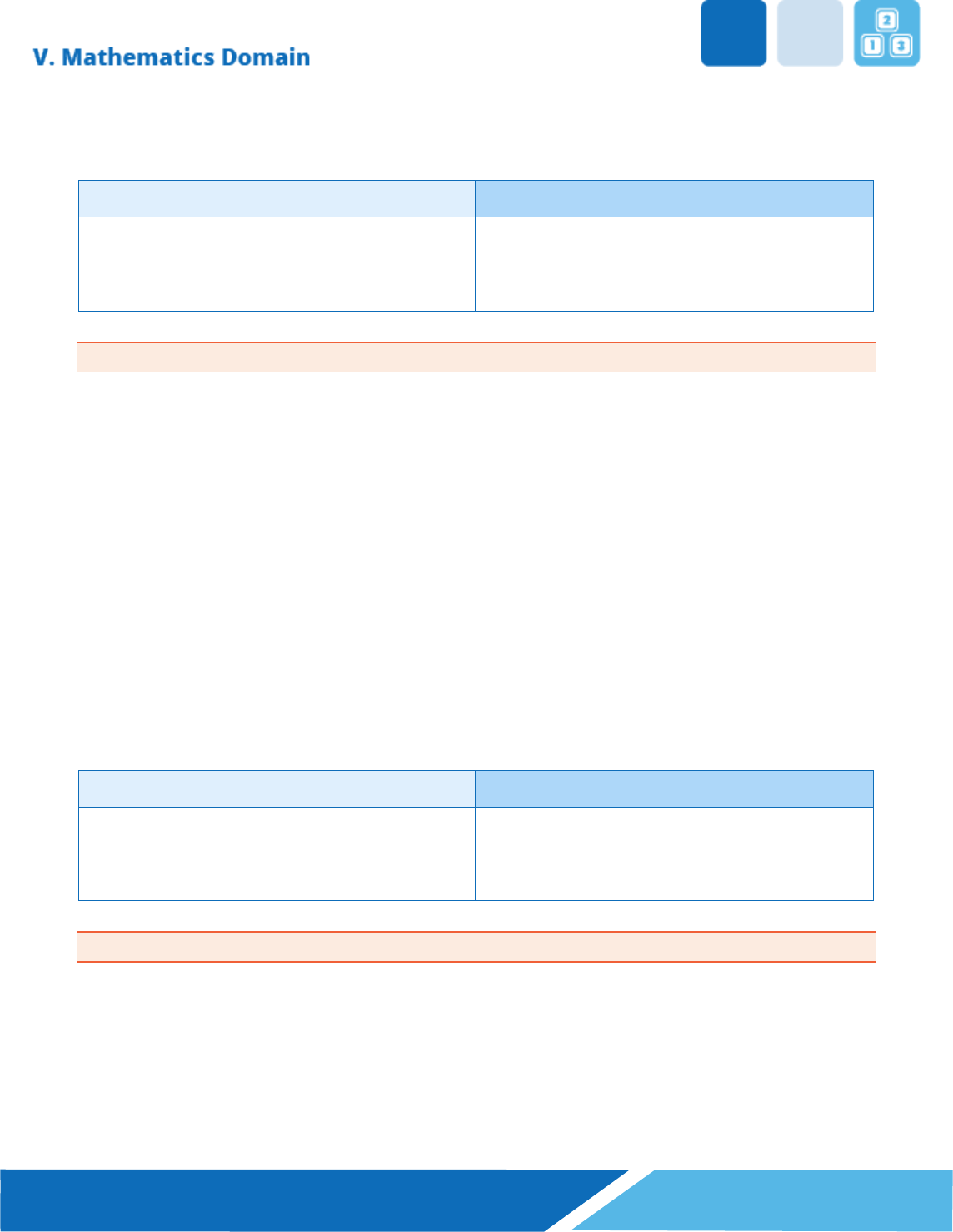
Mathematics 52
• drop a handful of six pom poms onto a placemat and report the number of groupings (e.g., 2
and 4) and the total number of pom poms (6)
PK3 Outcome
PK4 Outcome
PK3.V.A.8 Child compares sets of objects up to 5
using comparative language (e.g., more than, less
than, same number of).
PK4.V.A.8 Child compares sets of objects up to 10
using comparative language (e.g., greater/more
than, less/fewer than, equal to/same number of).
Child Behaviors
The child may:
• create sets of objects with the same amounts
• identify which set of objects in a pair is greater than the other
• explain why a set of 7 crayons is less than a set of 10 crayons
B. Joining and Separating
This math skill develops the concept of more, less, and the same. Children make comparisons — an
understanding of these comparisons provides an important foundation which helps the child fully grasp
the relationship and correlation between one number and another at the concrete level. It is especially
important that young children be given numerous opportunities during the school day to manipulate
objects to internalize this mathematical concept.
PK3 Outcome
PK4 Outcome
PK3.V.B.1 Child uses objects to demonstrate that
adding one or more objects to a set will increase
the number of objects in the set.
PK4.V.B.1 Child uses objects, pictorial models,
and/or a verbal word problem to represent adding
up to 5 objects.
Child Behaviors
The child may:
• create verbal word problems (e.g., tells a story) involving adding up to 5
• show 1 finger, adds 3 more fingers, and then adds 1 more finger to create a set of 5
• count all objects from sets that are being joined (e.g., having a set of two cubes and a set of
three cubes, then counting the cubes starting with 1, followed by 2, 3, 4, 5 to count all cubes)
• use a story mat and counters to model what happens when 3 birds join 2 birds in a tree
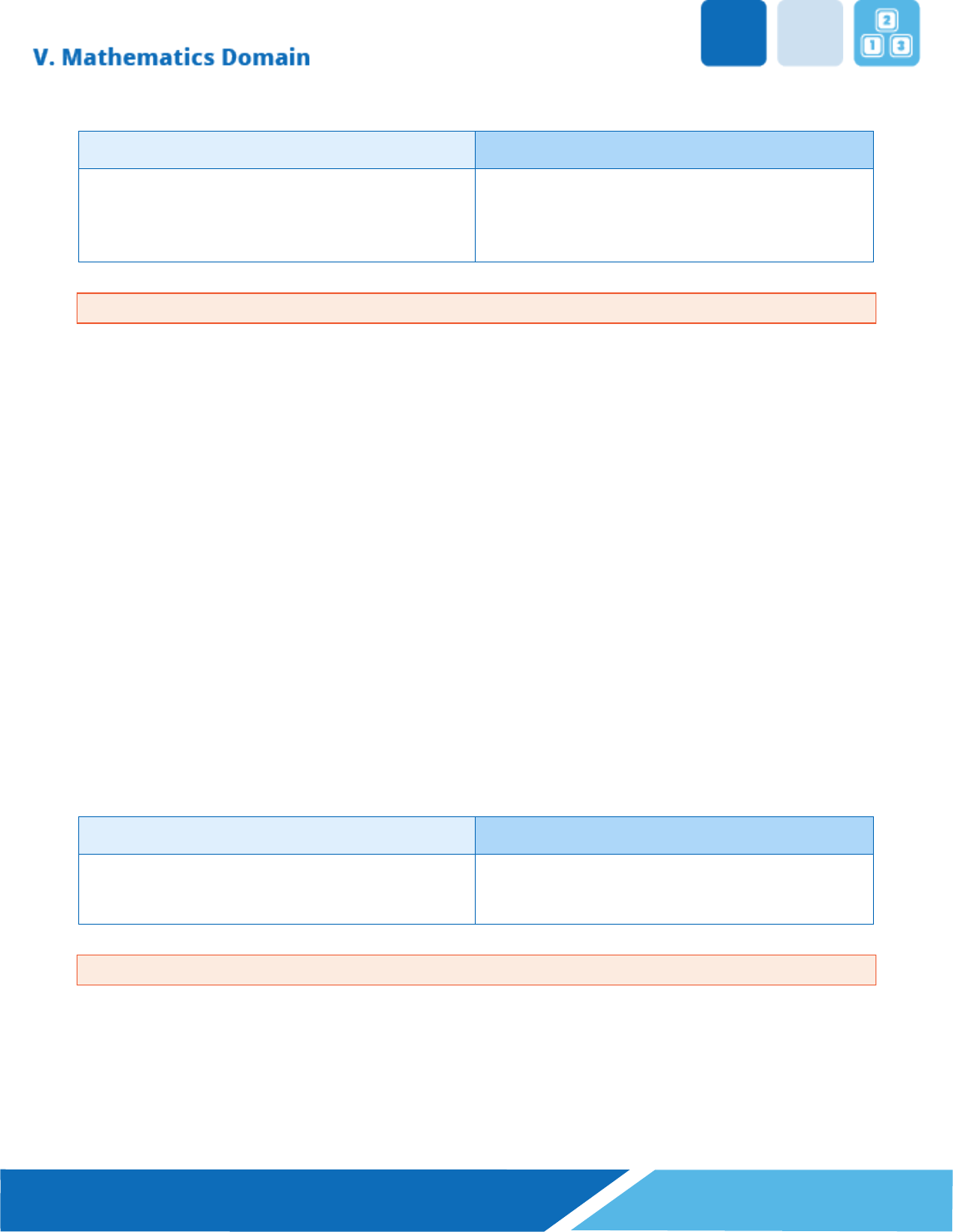
Mathematics 53
PK3 Outcome
PK4 Outcome
PK3.V.B.2 Child uses objects to demonstrate that
taking away one or more objects from a set will
decrease the number of objects in the set.
PK4.V.B.2 Child uses objects, pictorial models,
and/or a verbal word problem to represent
subtracting objects from a set of 5.
Child Behaviors
The child may:
• create verbal word problems (e.g., tells a story) involving subtracting up to 5
• separate the parts of a number (e.g., starts with 4 fingers, then takes away 1 finger to show 3
are left, and then takes away 2 fingers to show 1 is left)
• remove 1-5 objects from a set and says how many are left
• use a story mat and counters to represent removing 2 from a set of 5 (e.g., teacher tells a story
about 5 cookies on a plate, and after 2 cookies were eaten, child figures out only 3 were left)
C. Geometry and Spatial Sense
The basis of geometry and spatial sense skills begins with a child who explores, describes, and organizes
objects according to their attributes and position/location. Through intentional classroom activities
guided by teachers, children notice and describe small details in the materials they see in the
environment, using terms that categorize their shape and describe their relative position in space. They
then progress to investigating what happens when two shapes are put together, and they can apply
their ideas about location to the object’s direction and distance.
PK3 Outcome
PK4 Outcome
PK3.V.C.1 Child names and describes common 2D
shapes.
PK4.V.C.1 Child names and describes common 2D
shapes and names at least 1 solid 3D shape.
Child Behaviors
The child may:
• recognize and describe attributes of shapes
• describe the objects in the environment using shape names
• point to shapes they create in the art area and use the correct names to identify them (e.g.,
“Teacher, look – I made a triangle.” or “Teacher, look, this crayon cup is a cylinder”)
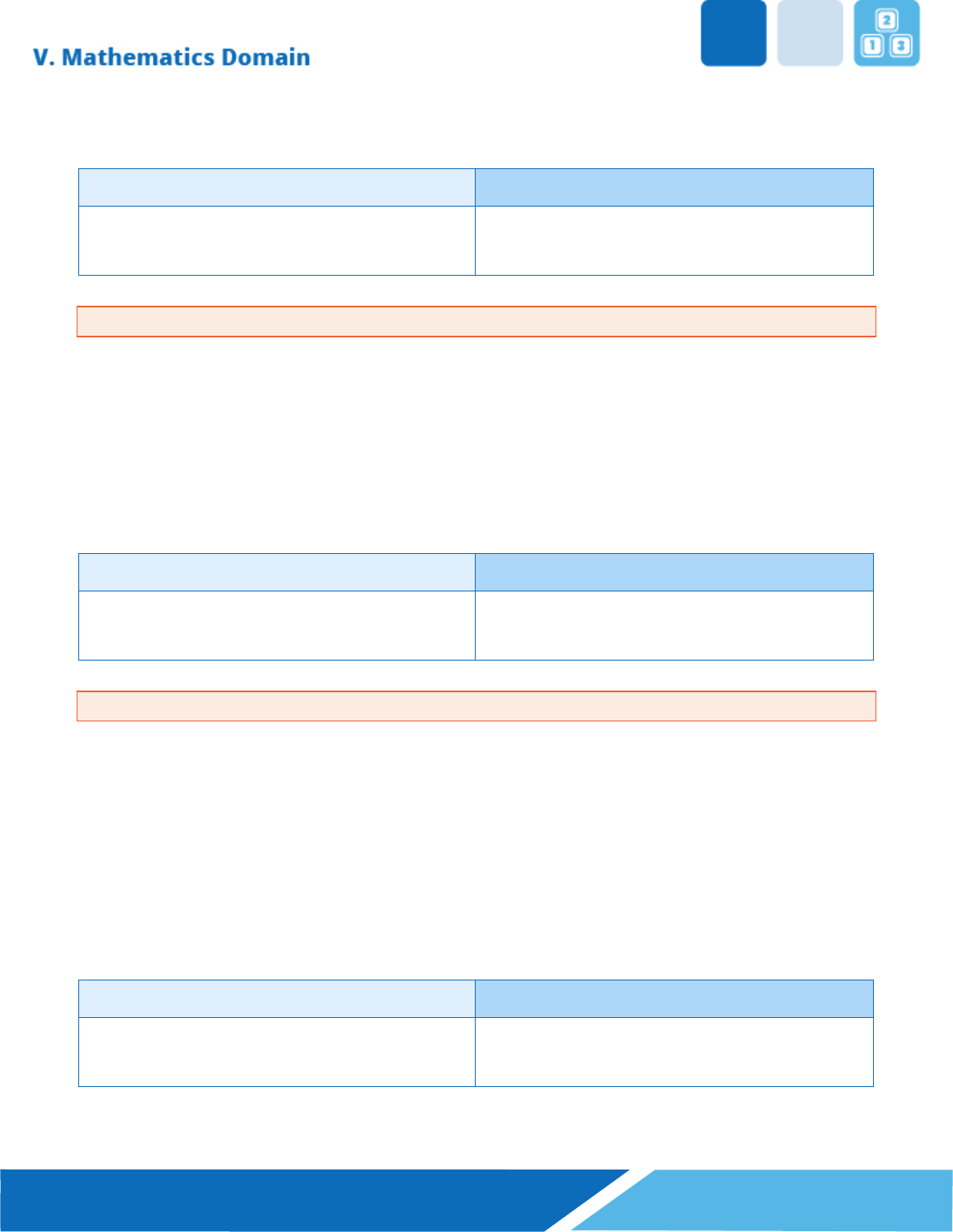
Mathematics 54
PK3 Outcome
PK4 Outcome
PK3.V.C.2 Child attempts to create shapes using
materials and/or manipulatives.
PK4.V.C.2 Child creates shapes using materials
and/or manipulatives.
Child Behaviors
The child may:
• put shapes together to make real-world objects (e.g., uses a square and a triangle to make a
house)
• place pattern block shapes together to make new shapes (e.g., uses 2 triangles to make a
square)
• make and name a shape created when playing with playdough (e.g., says “I’m making a circle”)
PK3 Outcome PK4 Outcome
PK3.V.C.3 Child begins to use language to describe
position of objects.
PK4.V.C.3 Child demonstrates use of position
words.
Child Behaviors
The child may:
• use the words “near” and “far” to describe distance of objects on the playground and in the
classroom
• follow directions that use location words (e.g., places a stuffed animal “on” or “under” a chair,
sits “beside” or “between” friends on the carpet, gets “in front of” or “behind” a peer in line,
etc.)
• tell a friend, using location words, where to find an object (e.g., says “The paper is in front of the
markers in the writing center.)
PK3 Outcome
PK4 Outcome
PK3.V.C.4 Child recognizes common shapes,
regardless of size.
PK4.V.C.4 Child recognizes common shapes,
regardless of orientation and size.

Mathematics 55
Child Behaviors
The child may:
• demonstrate understanding that a shape stays the same across various orientations (e.g.,
identifies shape correctly while playing with blocks no matter how they are oriented on the floor
or table)
• sort a small pile of pattern block shapes into similar shapes, regardless of size
• match shapes that are oriented differently from others (e.g., identifies and matches the two
triangles from a group of shapes even though one is oriented sideways, and one is oriented with
the tip pointing downwards)
• hold a pattern block and finds others of the same shape around the room, regardless of
orientation and size
D. Measurement
Young children can recognize differences in the measurable aspects of objects by saying things like “Her
cup is less full than mine” or “My dog is heavier than your dog because he is bigger”. Classroom
activities that include explorations of weight, length, and capacity should involve children in hands-on
learning using measurement tools. Teachers can introduce and reinforce terms associated with
measurement such as longer, shorter, heavier, and lighter. Early measurement skills begin with
comparisons before progressing to using a unit to measure.
PK3 Outcome PK4 Outcome
PK3.V.D.1 Child understands that lengths of
objects can vary and be compared.
PK4.V.D.1 Child recognizes and compares heights
or lengths of people or objects.
Child Behaviors
The child may:
• identify who is taller when comparing the height of 2 or more friends
• place 2–10 objects from shortest to tallest or tallest to shortest on the table
• use measurement words that can describe height (e.g., uses words like “taller,” “shorter,”
“longer,” or “smaller”)
PK3 Outcome
PK4 Outcome
PK3.V.D.2 Child begins to recognize capacity based
on how much space exists within an object.
PK4.V.D.2 Child recognizes and compares capacity
based on how much space exists within an object.

Mathematics 56
Child Behaviors
The child may:
• compare the amount of space occupied by objects (e.g., says “I want the big bowl of cereal; it
has more.”)
• demonstrate understanding of capacity while filling containers using measuring cups (e.g., says
“I think this one will take two cups to fill it up to the top.”)
• compare capacity of containers accurately (e.g., can compare and identify which object will hold
more water when filled)
PK3 Outcome
PK4 Outcome
PK3.V.D.3 Child understands that weights of
objects can vary and be compared.
PK4.V.D.3 Child recognizes and compares weights
of objects.
Child Behaviors
The child may:
• use hands to compare weight of objects (e.g., holds pumpkins of various sizes and says which is
heavier or lighter)
• use measurement words that describe which weighs more or less using mathematical terms
(e.g., “heavy,” “light,” “heavier” or “lighter”)
• compare the weight of self with the weight of other objects (e.g., such as dolls, stuffed animals,
or blocks)
PK3 Outcome
PK4 Outcome
PK3.V.D.4 Child shows awareness of the passage
of time within a day.
PK4.V.D.4 Child uses language to describe concepts
associated with the passing of time within a day.
Child Behaviors
The child may:
• use the daily schedule to describe what happens next in the day
• talk with friends about what is happening in the day (e.g., notes that snack time happens after
recess or expresses excitement for an upcoming assembly that will happen after lunch)
• use time language to describe events of the day (e.g., “in the morning,” “after snack,” “before
we go home,” etc.)

Mathematics 57
E. Classification and Patterns
Children can sort and classify objects according to one or more of their characteristics. With guidance,
they learn how to arrange a pattern so that an attribute repeats itself over and over in a predictable
manner. In their interaction with adults and peers, children use foundational math vocabulary, picking
up words used for comparison, position, and sequencing. As children progress, they extend their
comparing skills by creating visual representations of objects in the form of graphs.
PK3 Outcome
PK4 Outcome
PK3.V.E.1 Child sorts objects that are the same
and different.
PK4.V.E.1 Child sorts objects that are the same and
different into groups and uses language to describe
how the groups are similar and different.
Child Behaviors
The child may:
• sort all the cars in one box and all the trucks in a different box and describes why
• organize objects with a common attribute (e.g., all the animals that live in the ocean in a pile
and all the animals that live on land in another pile and explains how they are alike and
different)
• organize writing utensils in the writing center according to types and explains how they are alike
and different
PK3 Outcome
PK4 Outcome
PK3.V.E.2 Child participates in group activities of
collecting data and organizing it into graphic
representations.
PK4.V.E.2 Child collects data and organizes it in a
graphic representation.
Child Behaviors
The child may:
• place concrete objects or picture representations on a floor graph (e.g., uses an apple or orange
to show their favorite fruit)
• answer the question of the week (e.g., “Do you have a cat?”) and places a check on the yes or no
graph

Mathematics 58
• compare data on graphs or charts (e.g., talks about the class-made graph showing how children
get to school—walk, car, bus, vans—says, “Look Juan walks to school. See his name is here.”)
PK3 Outcome
PK4 Outcome
PK3.V.E.3 Child recognizes and duplicates
patterns.
PK4.V.E.3 Child recognizes, duplicates, extends,
and creates patterns.
Child Behaviors
The child may:
• identify repeating patterns in their environment
• use different materials (e.g., buttons, beads, color cubes) to create pattern necklaces (e.g., 2
buttons, 2 beads, 2 buttons, 2 beads, etc.)
• anticipate repeating patterns in a predictable book and says the next line before turning the
page
• create a repeated pattern using different colored blocks
• accurately continue to add to an already established pattern

Science 59
Literacy: Writin g Domain
VI. Science Domain
Young children often think that events simply happen without a specific cause or effect. To mature past
this developmental stage, prekindergarten children need exposure to inquiry-based science, which gives
them the opportunity to explore and to make sense of their world with adult guidance. This allows
children to be curious about the environment in which they live, ask a lot of questions, make
observations, describe what they experience using their five senses, and make tentative explanations
that can be shared with others. Children’s curiosity creates a natural desire to watch, explore, question,
and understand the world around them.
Science concepts for p
rekindergarten children should be developmentally appropriate, interesting, and
engaging, and able to be studied from multiple perspectives, in depth, and over time. When children
have many and varied opportunities to explore a concept, they come to the final stage
of scientific inquiry with a rich set of experiences to which they base their reflections and their
developing theories. Although children can easily learn science as they observe and interact daily, it is
the teacher’s role to provide a learning environment that offers discovery and exploration through
hands-on opportunities. These opportunities are particularly helpful for multilingual learners who may
not be able to explain what they know or have learned in a second language. Children should be
encouraged to be curious, ask questions, work collaboratively, plan investigations, record their
observations, and discuss their findings. In addition, science provides a unique context for
developing vocabulary, literacy, and math skills and concepts.
The Science domain of the Texas Prekindergarten Guidelines is divided into the following skills: physical
science, life science, and earth and space science.
A. Physical Science
Prekindergarten children begin to explore properties of materials, positions, and motion of objects
through investigations. These explorations using the senses continue as children use attributes to
classify and sort objects, make observations and predictions, problem solve, question, and compare.
Children learn about sources of energy by investigating and discussing light, heat, electricity, and
magnetism. This builds an early understanding of life science, physical science, earth science and
chemistry. Processes such as observing and recording data, posing questions, predicting, investigating,
and drawing conclusions can provide experiences to support literacy, math, and the sciences.
PK3 Outcome
PK4 Outcome
No PK3 outcomes for this domain of learning.
PK4.VI.A.1 Child observes, investigates, describes,
and discusses characteristics of common objects.
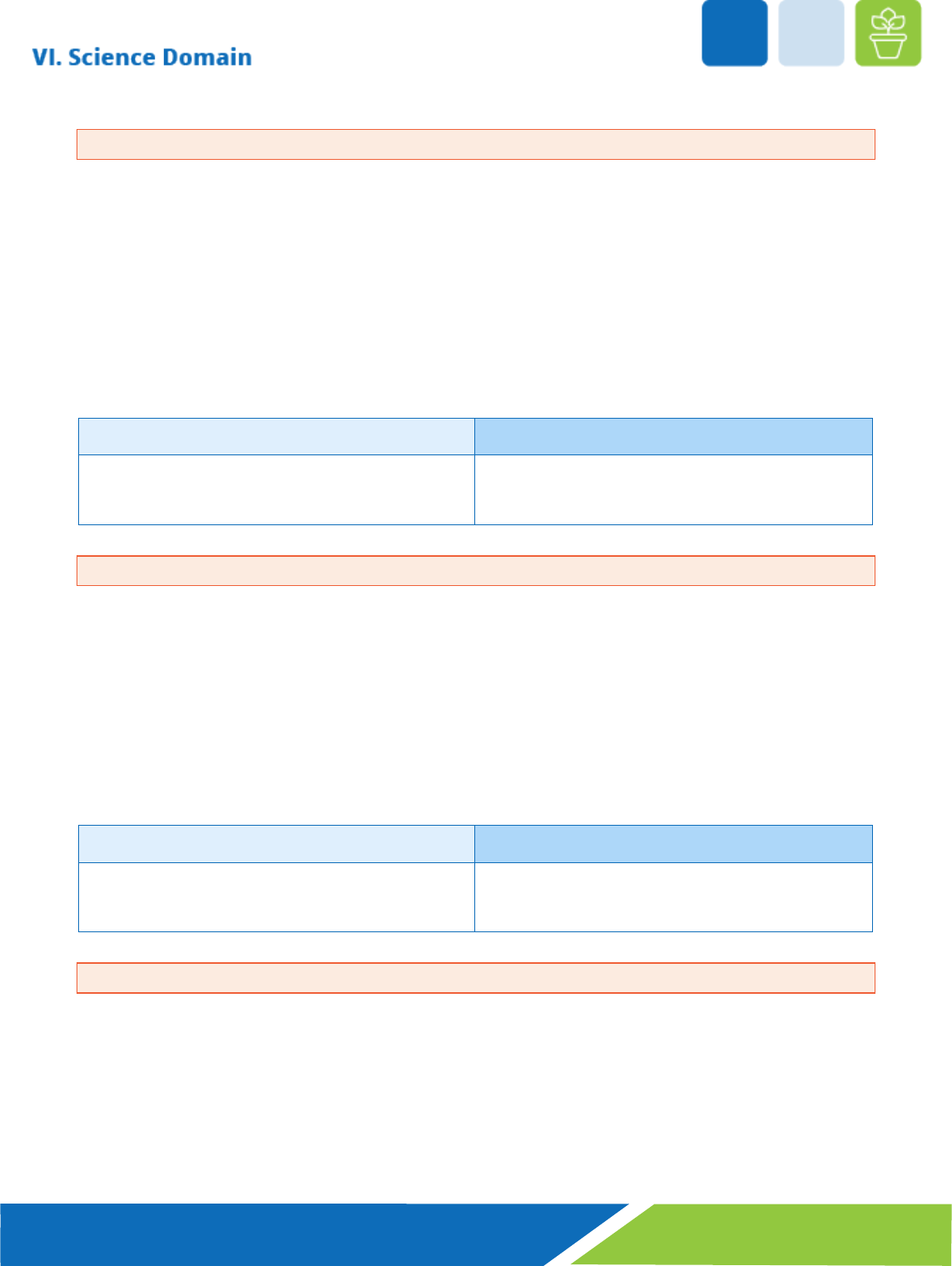
Science 60
Child Behaviors
The child may:
• explore using his senses and uses sensory language to describe characteristics of natural and
human-made objects and materials (e.g., wood, cotton, fur, stone, leather, plastic, paper, foil,
ingredients for cooking, feathers, sponges)
• sort, group, or classify objects in meaningful ways based on one or more characteristics (e.g.,
hard/soft or heavy/light; materials that are made of wood, plastic, rock)
• investigate and predict what common objects will do in response to an action (e.g., whether
materials will sink/float or melt/freeze)
PK3 Outcome
PK4 Outcome
No PK3 outcomes for this domain of learning.
PK4.VI.A.2 Child observes, investigates, describes,
and discusses position and motion of objects.
Child Behaviors
. Ma The child may:
• observe, measure, describe, and demonstrate the numerous ways objects can move (e.g.,
straight, zigzag, round and round, fast, slow)
• use positional language to inform others of the location, arrangement and/or stance of an
object (e.g., the books are under the table, my folder is inside my bag, you are in front of me on
the carpet, the car is beside the track, the ball is near the court etc.)
• investigate, predict, and state conclusions regarding how an object moves under a variety of
conditions (e.g., “The car won’t roll on the carpet,” “These wheels are bigger; it will go faster.”)
PK3 Outcome PK4 Outcome
No PK3 outcomes for this domain of learning.
PK4.VI.A.3 Child uses simple scientific tools to
learn about objects.
Child Behaviors
The child may:
• know the function of specific tools (e.g., a thermometer measures temperature)
• explore objects by appropriately using magnets, balances, eyedroppers, beakers/jars, etc.
• use a magnifying glass to observe, describe, and discuss the features of a common object (e.g.,
texture, color, shape, etc.)
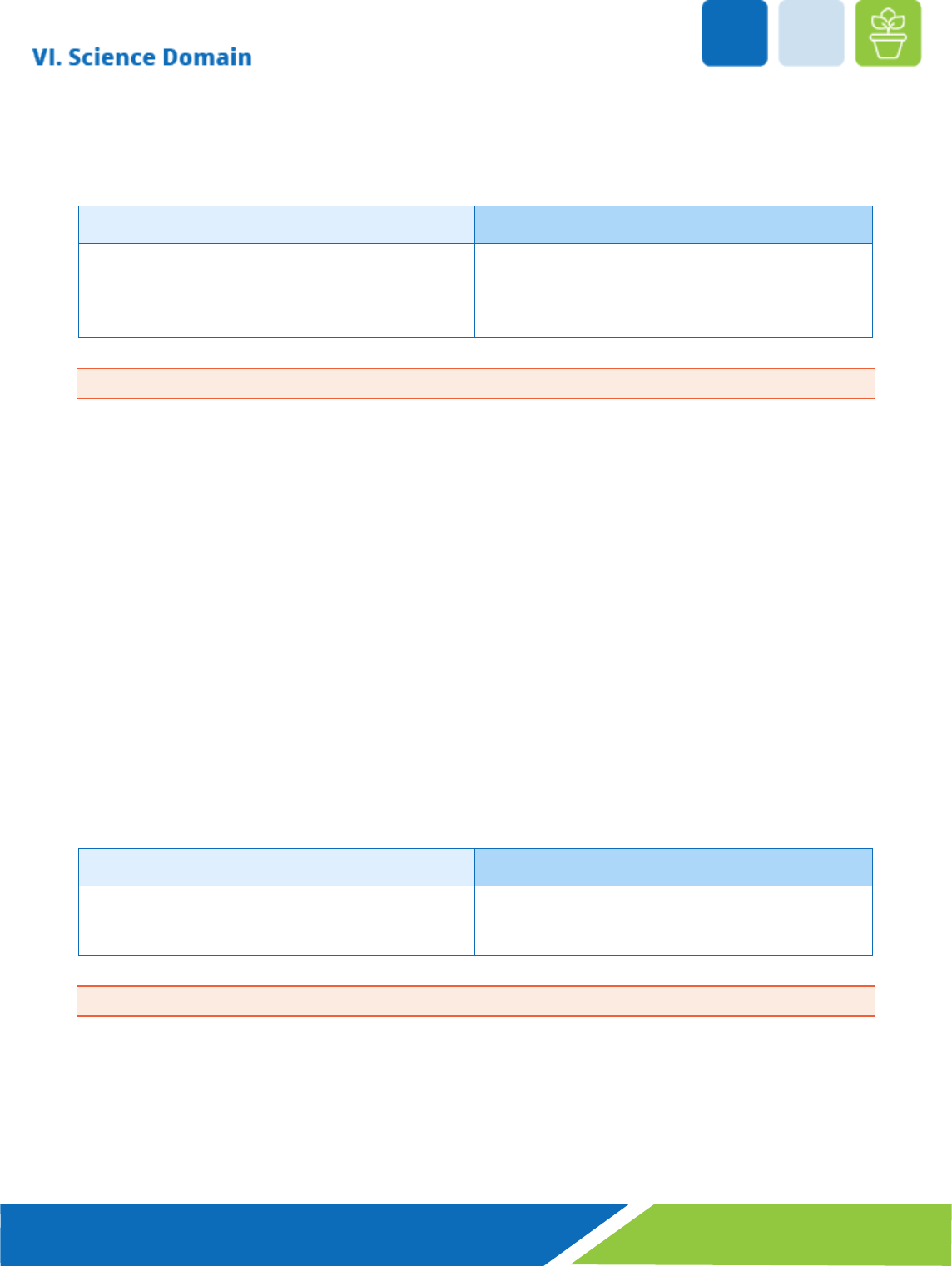
Science 61
PK3 Outcome
PK4 Outcome
No PK3 outcomes for this domain of learning.
PK4.VI.A.4 Child observes, investigates, describes,
and discusses sources of energy including light,
heat, and electricity.
Child Behaviors
The child may:
• describe common sources of energy (e.g., sun, wind, water)
• demonstrate understanding that some items/equipment must have a source of energy to
function (e.g., “Teacher, we need a new battery for this toy.” or “It’s not working; it is not
plugged in.”)
• identify common objects in the classroom or their home that need a source of energy to
function
B. Life Science
Young children have a keen interest in studying living things, including the unique features of plants and
animals, the environments in which they live, and what each living thing needs to thrive. Effective
teachers provide opportunities for children to explore, observe, and investigate various organisms
through hands-on experiences. Through these experiences, children are encouraged to use newly
acquired vocabulary to describe and discuss their observations.
PK3 Outcome
PK4 Outcome
No PK3 outcomes for this domain of learning.
PK4.VI.B.1 Child observes, investigates, describes,
and discusses the characteristics of organisms.
Child Behaviors
The child may:
• describe the color, size, and shape of organisms
• describe an organism’s need for food, water, air, light, and shelter
• compare differences and similarities of animals and plants (e.g., fish live in water, all birds have
feathers, we can eat some plants)

Science 62
PK3 Outcome
PK4 Outcome
No PK3 outcomes for this domain of learning.
PK4.VI.B.2 Child observes, describes, and discusses
the life cycles of organisms.
Child Behaviors
The child may:
• plant seeds, then observe, discuss, and record the plant’s growth
• observe, record, and discuss the stages of the life cycle of an organism (e.g., a baby, dog, frog, or
butterfly)
• observe and discuss human growth (e.g., measures growth using wall chart at the beginning and
end of the year)
• describe the differences in baby and adult organisms
PK3 Outcome
PK4 Outcome
No PK3 outcomes for this domain of learning.
PK4.VI.B.3 Child observes, investigates, describes,
and discusses the relationship of organisms in their
environments.
Child Behaviors
The child may:
• describe characteristics and differences between living and non-living organisms
• discuss how all organisms are dependent on other organisms (e.g., birds eat seeds, cows eat
grass, humans eat vegetables and meat)
• observe living organisms (e.g., spiders, insects, worms, snails, birds) in their natural environment
and discuss and record their behaviors/routines
• observe, discuss, and record seasonal changes in the environment (e.g., tree leaves turn
assorted colors, birds collect nesting materials, weather is warmer)
C. Earth and Space Science
Young children are innately curious about nature and the outdoors. When given the opportunity, they
love to play with earth’s materials – sand, dirt, water, and rocks. They are aware of weather conditions
and wonder why the weather changes from day to day. They notice the clouds in the sky, and they
observe that the sun moves across the sky each day and the moon changes shape. These concepts are
all a part of earth and space science. Studying earth and space science expands young children’s
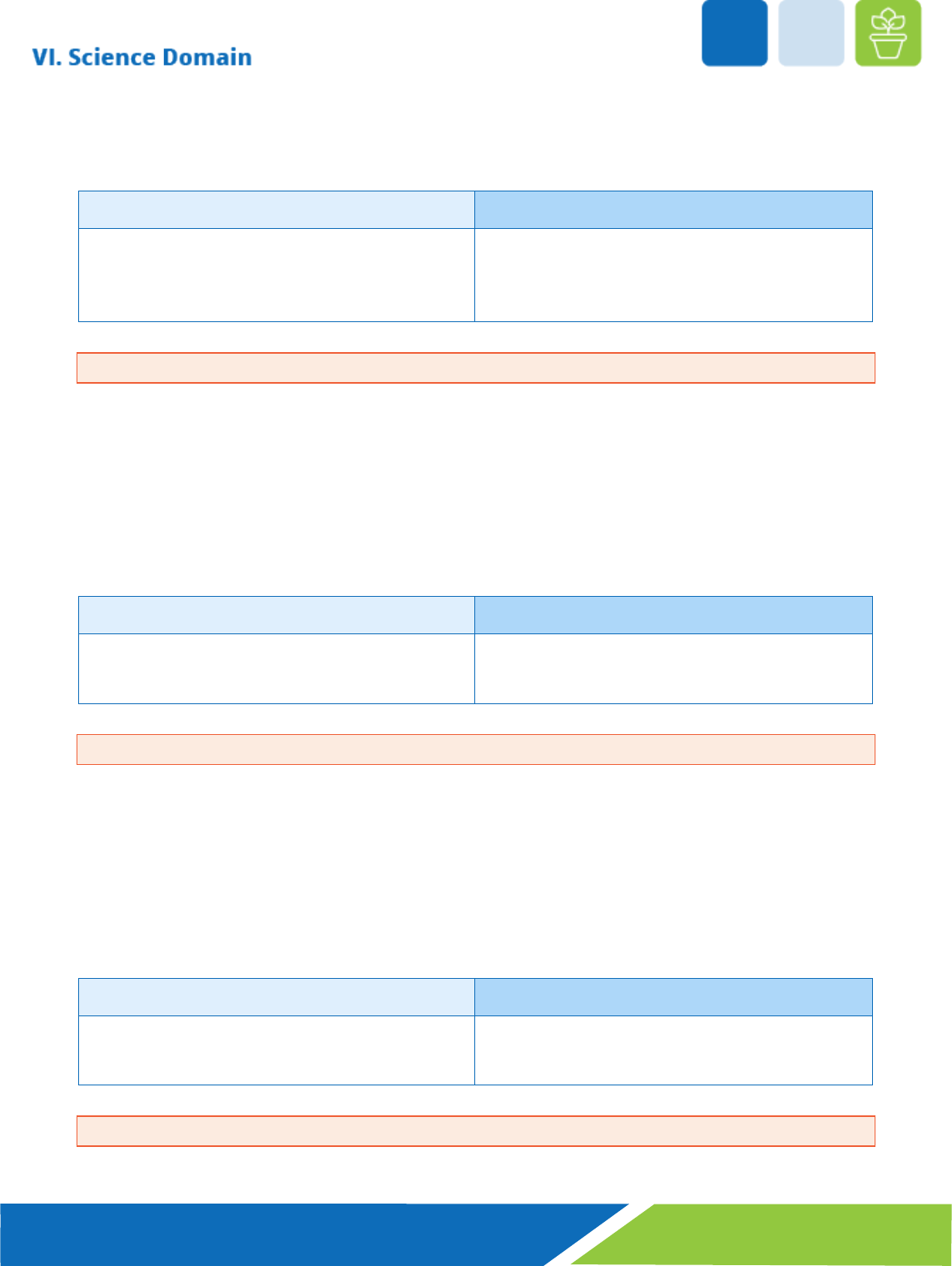
Science 63
vocabulary and guides them to discover their place in the world by understanding how they can impact
their environment with positive actions.
PK3 Outcome
PK4 Outcome
No PK3 outcomes for this domain of learning.
PK4.VI.C.1 Child observes, investigates, describes,
and discusses earth materials, and their properties
and uses.
Child Behaviors
The child may:
• observe, discuss, and compare earth materials (e.g., rocks, soil, sand) using magnifying glasses,
filters, water, and measurement tools
• identify the importance of soil, sunlight, air, temperature, and water to plant growth
• discuss and explain ways earth materials (e.g., soil, rocks) are used (e.g., building houses, road
construction, decorative purposes)
PK3 Outcome PK4 Outcome
No PK3 outcomes for this domain of learning.
PK4.VI.C.2 Child identifies, observes, describes, and
discusses objects in the sky.
Child Behaviors
The child may:
• observe and discuss characteristics of clouds (e.g., makes representation, such as finger painting
the clouds in the sky, and talks about their shape, size or color when sharing their work)
• ask questions and/or makes comments about the sun, stars, and moon
• identify and/or makes comments about objects that are commonly seen in the sky (e.g., sun,
clouds, moon, stars, etc.)
PK3 Outcome
PK4 Outcome
No PK3 outcomes for this domain of learning.
PK4.VI.C.3 Child observes and describes what
happens during changes in the earth and sky.
Child Behaviors

Science 64
The child may:
• observe and describe how different items (e.g., rocks, metal, water) respond to the warmth of
the sun outside on a sunny day or a cold/cloudy day
• explain what happens after a weather event (e.g., erosion after a rainstorm, movements of
leaves after a windstorm)
• observe, record, and predict daily weather changes (e.g., weather charts)
• observe shadows and describe the relationship between the shadow, object, and the sun
• observe and describe seasonal changes
PK3 Outcome PK4 Outcome
No PK3 outcomes for this domain of learning.
PK4.VI.C.4 Child demonstrates an understanding of
the importance of caring for our environment and
our planet.
Child Behaviors
The child may:
• discuss “green” practices (e.g., water conservation, clean air, recycling)
• engage in conservation or recycling projects (e.g., not using as many paper towels, using both
sides of the paper)
• go on a “trash hunt” to clean the school yard

X
Social Studies 65
VI. Science Dom ain
VII. Social Studies Domain
It is important for prekindergarten children to learn about people, places, and events in society,
beginning with themselves, their family, and their community. This helps develop children’s self-identity
and expand their understanding of the world outside their direct experience. The prekindergarten
classroom may be one of the first places children experience a variety of cultures and languages and
where diversity is elevated and honored. Skills such as beginning economics, geography awareness,
problem-solving, decision-making, and working independently as well as in teams in a classroom
prepare children to become active participants in their local and larger society.
Chi
ldren come from a variety of cultural and linguistic settings; therefore, their background knowledge
and understanding of the world can be unique and diverse. It is important to incorporate and honor
children’s home community and culture in the prekindergarten classroom. This will help children make
connections to some of the concepts in the social studies domain.
The Social Studies domain of the Texas Prekindergarten Guidelines is divided into these skill areas:
people past and present, economics, geography, and citizenship.
A. People Past and Present
Prekindergarten children are aware of time and begin to organize their lives around it. Young children
learn to depend on events and routines that occur in a regular and predictable order. They begin to
understand past events and how these events relate to each of their cultural backgrounds as well as
present and future activities, demonstrating evidence of their growing understanding of time, change,
culture, and continuity.
PK3 Outcome PK4 Outcome
No PK3 outcomes for this domain of learning.
PK4.VII.A.1 Child identifies similarities and
differences between himself, classmates, and
other people through specific characteristics and
cultural influences.
Child Behaviors
The child may:
• describe self and classmates in a drawing by identifying distinguishing characteristics (e.g., color
of eyes, length of hair, color or texture of hair, etc.)
• understand that people speak different languages

Social Studies 66
• compare own customs, traditions, and culture with those of a character represented in a read
aloud story
PK3 Outcome PK4 Outcome
No PK3 outcomes for this domain of learning.
PK4.VII.A.2 Child identifies similarities and
differences in characteristics of families.
Child Behaviors
The child may:
• ask questions about other people’s families to make connections to their own family
• make comparisons between own family and classmate’s families (e.g., “I have three sisters and
you have three sisters” or “my grandma lives with me too”)
• share details about family members during circle time
• make c
onnections to character’s families in books or movies
PK3 Outcome
PK4 Outcome
No PK3 outcomes for this domain of learning.
PK4.VII.A.3 Child connects his life to events, time,
and routines.
Child Behaviors
The child may:
• describe similarities and differences between routines (e.g., compares story time at school to
story time at home)
• relate past events to current events (e.g., connects yesterday’s activity with what will happen
today)
• discuss important events (e.g., field trips, moving, fire drills, school concerts, etc.)
• connect life events to stages in development (e.g., “when I was a baby I couldn’t walk, so my
mom had to bring me to the park in a stroller. Now, I am bigger so I can ride my bike there.”)
B. Economics
Prekindergarten children learn about the world through their community. They explore the roles and
relationships of consumers and producers and become aware that people produce both goods and
services. Children learn that their community benefits from its members working to contribute in many
different ways.
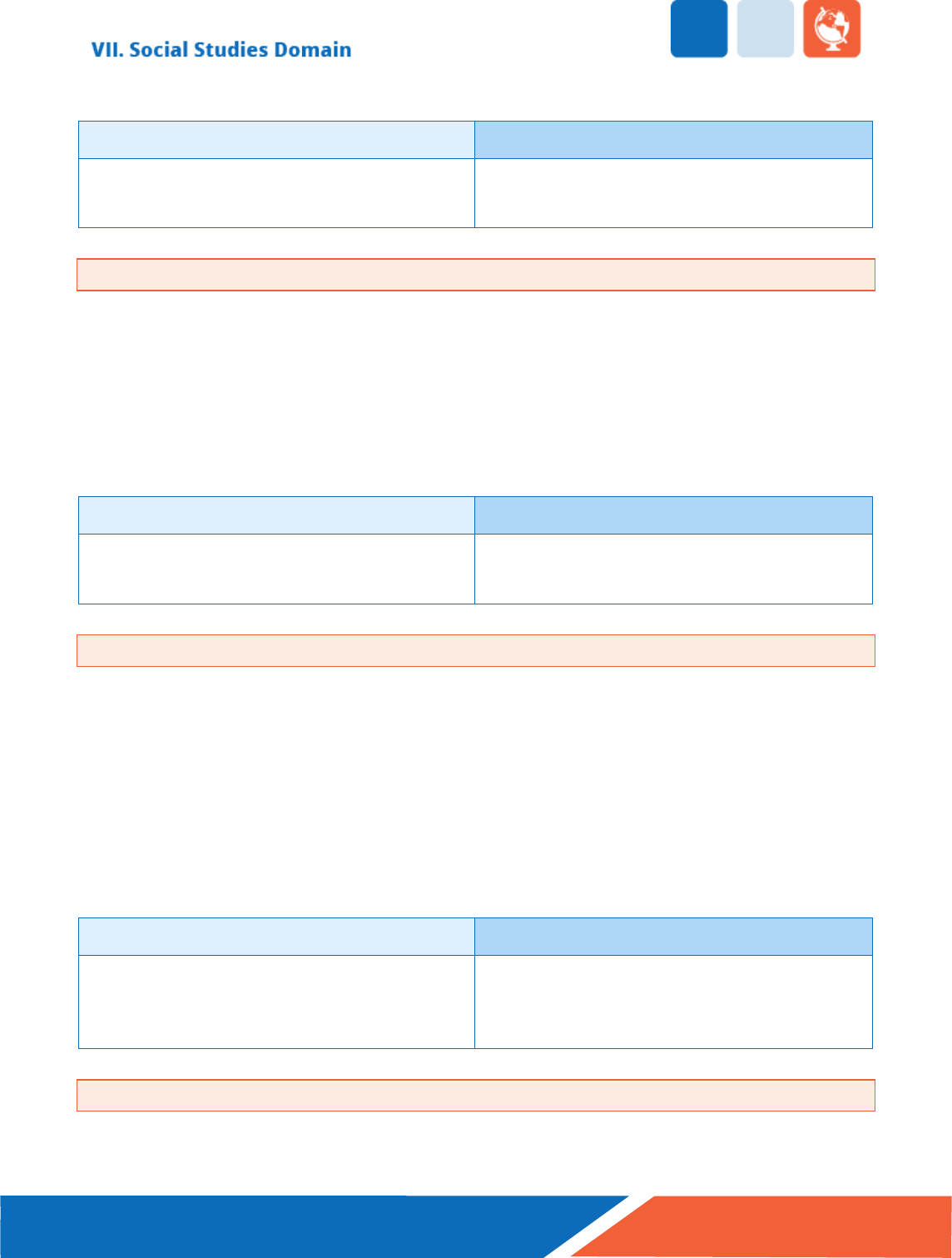
Social Studies 67
PK3 Outcome
PK4 Outcome
No PK3 outcomes for this domain of learning.
PK4.VII.B.1 Child demonstrates an understanding
that all people need food, clothing, and shelter.
Child Behaviors
The child may:
• prepare food, select dress-up clothes, and identify shelter for friends or toys in the dramatic play
center
• include shelter, food, and clothing in drawings
• explain why food, shelter, and clothing are necessary
• sort things by needs and wants and includes food, clothing, and shelter into the needs section
PK3 Outcome PK4 Outcome
No PK3 outcomes for this domain of learning.
PK4.VII.B.2 Child demonstrates an understanding
of what it means to be a consumer.
Child Behaviors
The child may:
• talk with the other children about shopping experiences (e.g., buying or selling items at a store
or garage sale)
• participate in activities using pretend money (e.g., buying or selling items found in the
store/restaurant in the dramatic play center)
• identify a consumer in a story read aloud
• draw or write about experiences as a consumer (e.g., buying groceries, shopping for clothes,
etc.)
PK3 Outcome
PK4 Outcome
No PK3 outcomes for this domain of learning.
PK4.VII.B.3 Child discusses the roles and
responsibilities of family, school, and community
helpers.
Child Behaviors
The child may:

Social Studies 68
• explain why family, school, and community helpers are important during classroom discussions
• role play as family, school, or community helpers during play
• identify community helpers in a story and describe how they helped the characters in the story
• draw or write about family, school, and community helpers
C. Geography
Geography is taught as a part of social studies because it plays a crucial role in developing children’s
awareness of relationships between people and the environment. In prekindergarten, geography is
often viewed with a focus on activities that build geographic skills, such as mapmaking or
drawing/describing geographical land features. Prekindergarten children begin to think about geography
using location and direction. Children use direction to locate their relative position in space and to locate
their home and school in their community. However, the geography discipline consists of two main
categories: physical geography and human geography. While human geography is the study of the
relationship between humans and their natural environment, physical geography is the study of the
natural environment. Prekindergarten children should also explore the outdoors and experience the
natural world. It is recommended that lessons about physical geography be taught outdoors on the
school lawn, playground, or in the neighborhood nearby, when possible.
PK3 Outcome
PK4 Outcome
No PK3 outcomes for this domain of learning.
PK4.VII.C.1 Child identifies and creates common
geographic features.
Child Behaviors
The child may:
• name common geographic features (e.g., rivers, lakes, hills, etc.) in their surroundings
• use modeling clay to create models of common landforms at the sensory table
• include drawings of common geographic features in the scenery of their artwork
• describe the setting of a story in detail, noting common features that make the location
distinctly identifiable
PK3 Outcome PK4 Outcome
No PK3 outcomes for this domain of learning.
PK4.VII.C.2 Child explores geography tools and
resources.
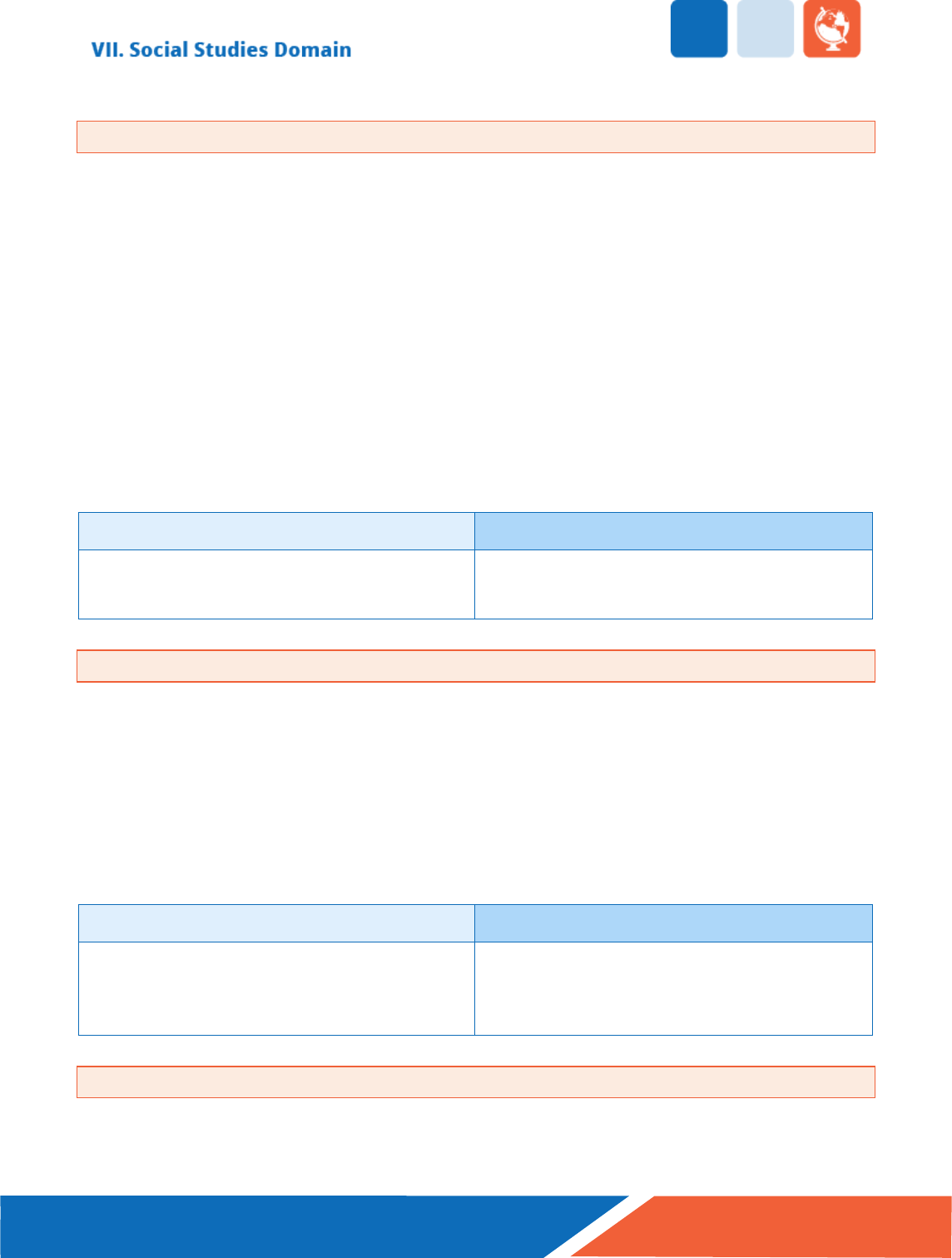
Social Studies 69
Child Behaviors
The child may:
• explore signs and maps to help figure out where they need to go
• make maps or signs to show how to find a location (e.g., creates a map of their bedroom, house,
school, or even a treasure map)
• identify tools used to locate places (e.g., map, GPS, globe, etc.)
D. Citizenship
Prekindergarten children begin to understand important symbols, routines, and celebrations that
represent American culture. They begin to understand what it means to be a citizen of the United States
of America and a resident of the state of Texas.
PK3 Outcome
PK4 Outcome
No PK3 outcomes for this domain of learning.
PK4.VII.D.1 Child identifies the United States and
Texas flag.
Child Behaviors
The child may:
• point to identify the United States or Texas flag when asked
• face the correct flag when saying the Pledge of Allegiance
• compare the United States flag and the Texas flag by discussing their similarities and differences
• recognize the United States or Texas flag in a book or when on a field trip
• include a drawing of the United States or Texas flag in a picture
PK3 Outcome
PK4 Outcome
No PK3 outcomes for this domain of learning.
PK4.VII.D.2 Child recites the Pledge of Allegiance to
the United States flag and the Texas flag and
observes a moment of silence.
Child Behaviors
The child may:
• participate in daily Pledge of Allegiance activities

Social Studies 70
• discuss the purpose of saying the Pledge of Allegiance
• identify places and events where the Pledge of Allegiance is said, (e.g., ball games, assemblies,
etc.)
• demonstrate respect for classmates and country during the Pledge of Allegiance
PK3 Outcome PK4 Outcome
No PK3 outcomes for this domain of learning.
PK4.VII.D.3 The child engages in voting as a
method for group decision-making.
Child Behaviors
The child may:
• participate in voting experiences related to classroom decision-making
• share experiences about going to vote with family members
• create voting situations in dramatic play center

X
Fine Arts 71
VIII. Fine Arts Domain
Art can help prekindergarten children learn to observe, organize, and interpret experiences through
multiple mediums. They can benefit from many opportunities to creatively express themselves through
music, movement and dance, dramatic play, and the visual arts (e.g., drawing, painting, building
sculptures, etc.). The outcomes in this domain reflect children’s need to experiment, manipulate and
transform materials. Teachers can encourage this by providing opportunities for children to engage in
the “process” of creating rather than focusing on the “product” that is created. Art should be integrated
across all learning domains and can be used to support many aspects of development (e.g., self-
expression, fine and gross motor skills, and vocabulary).
The Fine Arts Domain of the Texas Prekindergarten Guidelines is divided into the following skills: art,
music, and dramatic expression.
A. Art
Prekindergarten children explore a wide variety of materials and make discoveries about color, shape,
and texture through art experiences. They learn to express what they know and begin to recognize how
others express themselves through art. They begin to gain control of fine-motor muscles and practice
hand-eye coordination. The majority of art experiences should be model/sample free with the focus
being on the process of creating.
PK3 Outcome PK4 Outcome
No PK3 outcomes for this domain of learning.
PK4.VIII.A.1 Child uses a variety of art materials for
sensory experiences and exploration.
Child Behaviors
The child may:
• manipulate modeling clay by rolling, pinching, squeezing, patting, and cutting
• mix colors to make other colors (e.g., red and yellow finger paint to make orange)
• investigate using a variety of materials to create art (e.g., different sized paint brushes, sponges,
different types of paper, crayons/markers/colored pencils, etc.)
• select a variety of materials in the art center for exploration (e.g., painting with cotton swabs on
paper or writing with crayons/markers/colored pencils)

Fine Arts 72
PK3 Outcome
PK4 Outcome
No PK3 outcomes for this domain of learning.
PK4.VIII.A.2 Child uses art as a form of creative
self-expression and representation.
Child Behaviors
The child may:
• describe own artwork (e.g., “This is me riding my bike.”)
• explain steps for creating her artwork (e.g., “First I rolled the clay into a ball. Then I…”)
• gradually create drawings and paintings that become more realistic and detailed
• share positive feelings about personal artistic creations and experiences
PK3 Outcome
PK4 Outcome
No PK3 outcomes for this domain of learning.
PK4.VIII.A.3 Child demonstrates interest in and
shows appreciation for the creative work of others.
Child Behaviors
The child may:
• comment on and/or ask questions about the artwork of others, including classmates and
illustrators
• notice differences in artwork influenced by a variety of cultures
• notice similarities in the artwork of books created by the same illustrator
B. Music
Prekindergarten children express themselves through singing and movement and by playing simple
instruments. Like art, music is a form of experiencing, learning, and communicating with others. Children
learn to experiment with musical concepts, such as volume, tempo, and sound. Their vocabulary is
expanded. They begin to appreciate different types of music.
PK3 Outcome
PK4 Outcome
No PK3 outcomes for this domain of learning.
PK4.VIII.B.1 Child participates in classroom music
activities including singing, playing musical
instruments, and moving to rhythms.
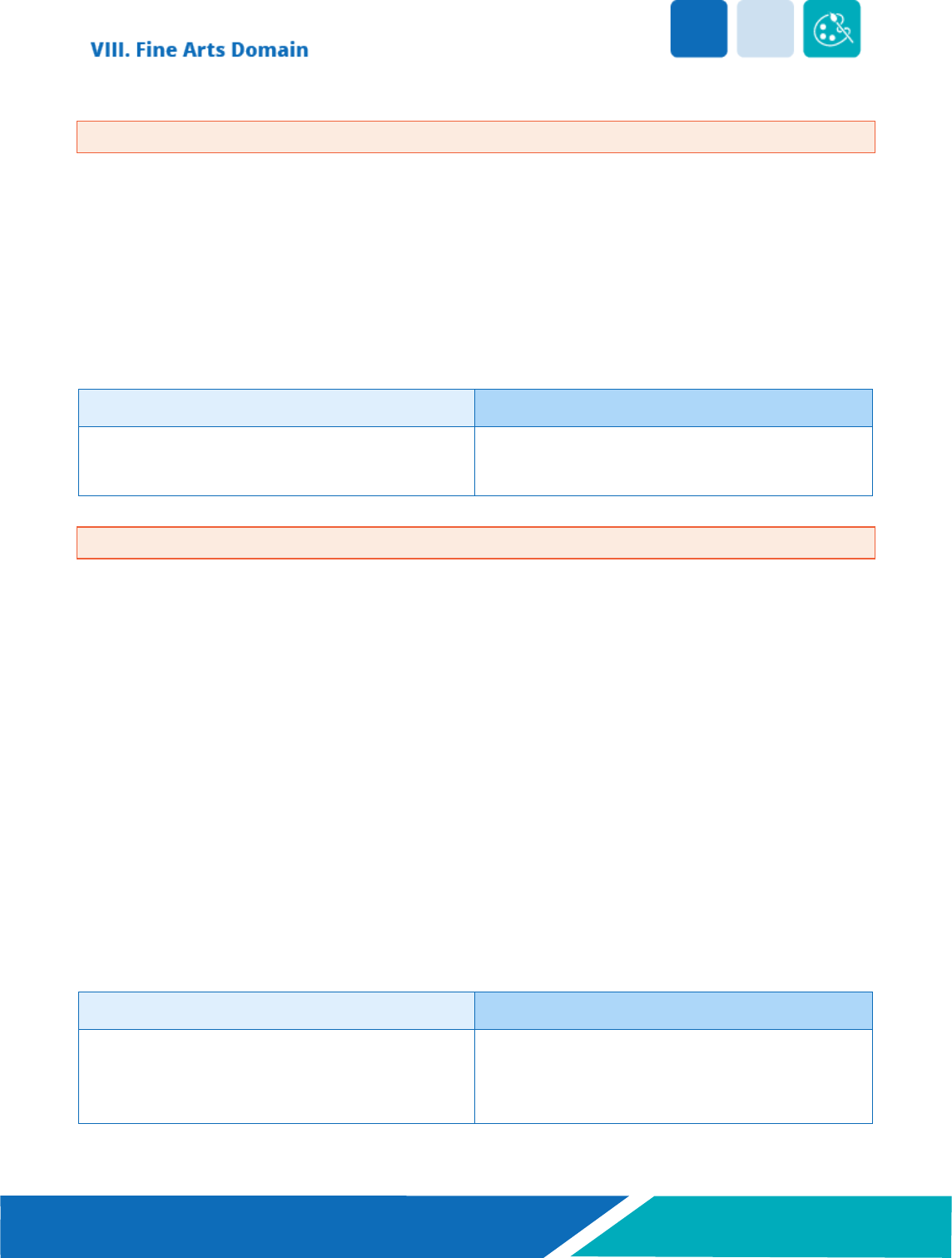
Fine Arts 73
Child Behaviors
The child may:
• sing along with popular songs during circle time (e.g., “Old McDonald Had a Farm”)
• join in fingerplay by chanting and following the movements in songs (e.g., “Itsy, Bitsy, Spider”)
• make up and sing songs during the day
• move in rhythm to simple tunes and musical patterns
• explores or plays with musical instruments (e.g., maracas, cymbals, rhythm sticks, tambourine)
PK3 Outcome
PK4 Outcome
No PK3 outcomes for this domain of learning.
PK4.VIII.B.2 Child responds to different musical
styles through movement and play.
Child Behaviors
The child may:
• use props (e.g., scarves, streamers) to respond to music through movement
• follow the beat using body and musical instruments (e.g., walks or jumps to the beat)
• describe moods and feelings (e.g., happy/sad) associated with different types of music (e.g.,
loud/soft, fast/slow, etc.)
• talk about different styles of music including music from different parts of the world (e.g.,
classical, country, dance, jazz, hip-hop, Latin, rock)
C. Dramatic Expression
Prekindergarten children participate in expressive and spontaneous productions through creative
dramatic play. Children demonstrate their unique interpretation of music, songs, and stories through
movement and dramatic experiences. These experiences contribute to children’s ability to communicate
more effectively and engage in cooperative play with others.
PK3 Outcome
PK4 Outcome
No PK3 outcomes for this domain of learning.
PK4.VIII.C.1 Child creates or recreates stories,
moods, or experiences through dramatic
representations.

Fine Arts 74
Child Behaviors
The child may:
• act out a story read aloud
• engage in dramatic play with classmates to create a story
• make or use props to dramatize a story read aloud
• re-
enact real life events in the dramatic play center

X
Physical Development 75
IX. Physical Development Domain
Prekindergarten children’s learning is directly influenced by their development of gross and fine motor
skills as well as their knowledge of personal safety and health. The motor development outcomes
included in this domain describe opportunities for children to develop rhythmic, stability, loco
-mot
or,
and manipulative skills that ultimately influence many aspects of children’s success in cognitive,
perceptual, and social emotional development. Children’s knowledge of personal safety and health
impacts their development of healthy habits early, which are key to life-long health and overall well-
being.
The Phys
ical Development Domain of the Texas Prekindergarten Guidelines is divided into the following
skills: gross motor development, fine motor development, and personal safety and health.
A. Gross Motor Development
Prekindergarten children explore their physical space and understand how their bodies function in space
through active movement experiences. Large-motor skills are developed first, followed by stability (e.g.,
turning, twisting, balancing, dodging) and manipulative (e.g., throwing, catching, kicking, striking) motor
skills. Gross motor development requires thought and deliberate movement. Four-year-old children
develop greater control of gross motor manipulative movements that involve giving force to objects and
receiving force from objects.
PK3 Outcome PK4 Outcome
PK3.IX.A.1 Child masters basic skills of running,
jumping, climbing, and pedaling.
PK4.IX.A.1 Child demonstrates coordination and
balance in isolation.
Child Behaviors
The child may:
• maintain balance while walking on a balance beam or standing on one foot
• hop on one foot, walk, jog, jump, and gallop in place or from one place to another
• carry a bowl or plate of objects from one spot to another
• coordinate large muscle movement and equipment (e.g., swing on a swing, ride a tricycle, slide
on a slide, dribble a ball, jump over a rope)
PK3 Outcome
PK4 Outcome

Physical Development 76
PK3.IX.A.2 Child engages in movement sequences
with adult support.
PK4.IX.A.2 Child coordinates sequence of
movements to perform tasks.
Child Behaviors
The child may:
• move within a space of defined boundaries, changing body configuration to accommodate the
space (e.g., moving through an obstacle course)
• use non-locomotor (axial) movements such as reaching, twisting, turning, and bending
• participate in group games involving movement (e.g., “Hokey Pokey”)
B. Fine Motor Development
Prekindergarten children participate in fine-motor manipulative movements through object-handling
activities that emphasize motor control, precision, and accuracy of movement. Cutting with scissors,
manipulating modeling dough, and drawing are the foundational skills needed for the demands of
handwriting and other small-motor skills in later school years. Fine motor activities that help to
strengthen the small muscles of the hands in preparation for writing are integrated into learning
centers.
PK3 Outcome PK4 Outcome
PK3.IX.B.1 Child experiments with a variety of fine
motor tasks but may lack strength and control.
PK4.IX.B.1 Child shows control of tasks that require
small-muscle strength and control.
Child Behaviors
The child may:
• use pincer control (grasps small objects between thumb and index finger) to manipulate tools
(e.g., tweezers, eyedroppers) and manipulatives (e.g., linking cubes)
• use hands and fingers to manipulate various classroom materials (e.g., molding modeling clay,
placing caps on and off markers, painting at the easel, tearing paper)
• hold drawing and writing utensils in a more conventional grasp (with fingers instead of fist)
PK3 Outcome PK4 Outcome
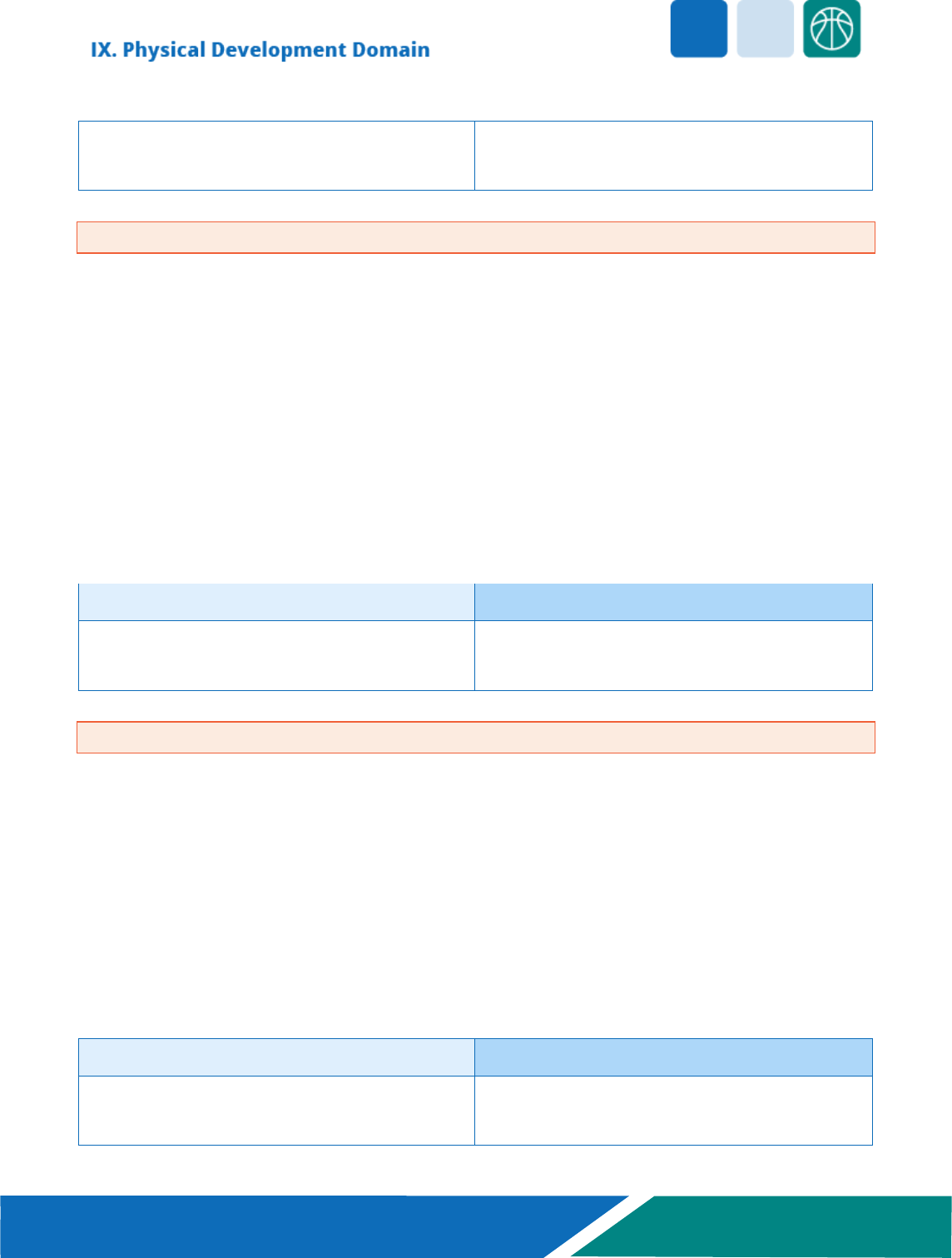
Physical Development 77
PK3.IX.B.2 Child shows emerging proficiency in
tasks requiring eye-hand coordination.
PK4.IX.B.2 Child shows increasing control of tasks
that require eye-hand coordination.
Child Behaviors
The child may:
• engage in activities that develop eye-hand coordination. (e.g., puts puzzles together, strings
beads together, builds with blocks)
• a
ccomplish self-help tasks (e.g., buttoning, zipping, snapping, eating with utensils)
• use one hand to grasp a piece of paper and the other hand to use scissors to snip a piece of
paper
C. Personal Safety and Health
Prekindergarten children develop an understanding of health and safety issues related to their daily
routines and activities. Children learn to make healthy choices in nutrition and understand the
importance of well-being through exercise and rest.
PK3 Outcome PK4 Outcome
No PK3 outcomes for this skill.
PK4.IX.C.1 Child practices good habits of personal
safety.
Child Behaviors
The child may:
• follow safety procedures while using common tools and materials (e.g., glue, scissors, rulers,
pencils, hammers, wood, safety goggles)
• show an understanding of fire safety and shelter in place procedures (e.g., stop, drop, roll or
walking to an exit during fire drills)
• follow safety guidelines for day-to-day routines (e.g., walks in the hallway, looks both ways
before crossing the street, applies playground rules, etc.)
• demonstrate safety precautions when interacting with animals (e.g., knows not to approach a
snake on the playground, asks permission before petting a campus service dog, etc.)
PK3 Outcome
PK4 Outcome
No PK3 outcomes for this skill.
PK4.IX.C.2 Child practices good habits of personal
health and hygiene.

Physical Development 78
Child Behaviors
The child may:
• cough and sneeze into elbow
• wash hands after using the toilet and before eating
• recognize appropriate dress for the weather (e.g., wears a coat when it is cold outside, grabs an
umbrella when it is raining, asks for sunscreen when it is sunny outside, etc.)
PK3 Outcome
PK4 Outcome
No PK3 outcomes for this skill.
PK4.IX.C.3 Child identifies good habits of nutrition
and exercise.
Child Behaviors
The child may:
• identify healthy snacks and discuss how to make nutritious food choices
• participate in preparing healthy snacks that are filled with lots of nutrients
• identify and discuss substances and activities that are unhealthy
• demonstrate and discuss the need for exercise and rest to stay healthy

79
X
X. Technology Applications Domain
Technology can greatly enhance learning experiences for prekindergarten children, but it is critical that
young children learn about the appropriate use of technology and interactive media. It can enhance
active, hands-on, creative, and authentic engagement with others and with the world, but it must be
used with intentionality. Technology should not replace face-to-face instruction. Regular access and
exposure to computers and related technology including challenging learning applications, programs,
and websites, can provide opportunities for children to expand their ability to acquire information, solve
problems, and communicate. These technologies serve as important learning tools and are integrated
throughout the instructional program to enrich learning of curriculum content and concepts. Providing
access to a variety of technologies is critical in the development of skills that young children need to
learn and grow in the 21st century.
The Technology Applications Domain of the Texas Prekindergarten Guidelines includes only one skill:
technology and devices.
A. Technology and Devices
Prekindergarten children learn how technology can enhance our lives. Surrounded by technology,
children can benefit from becoming aware of and interacting with digital media and a variety of other
available technology. They develop techniques for handling and controlling various devices, becoming
increasingly confident and independent users of developmentally appropriate interactive media.
PK3 Outcome
PK4 Outcome
No PK3 outcomes for this domain of learning.
PK4.X.A.1 Child opens and navigates through
digital learning applications and programs, when
appropriate.
Child Behaviors
The child may:
• follow basic oral or visual cues to explore a variety of interactive media websites, learning
applications, and digital programs
• listen to and interact with digital storybooks and informational texts
PK3 Outcome
PK4 Outcome
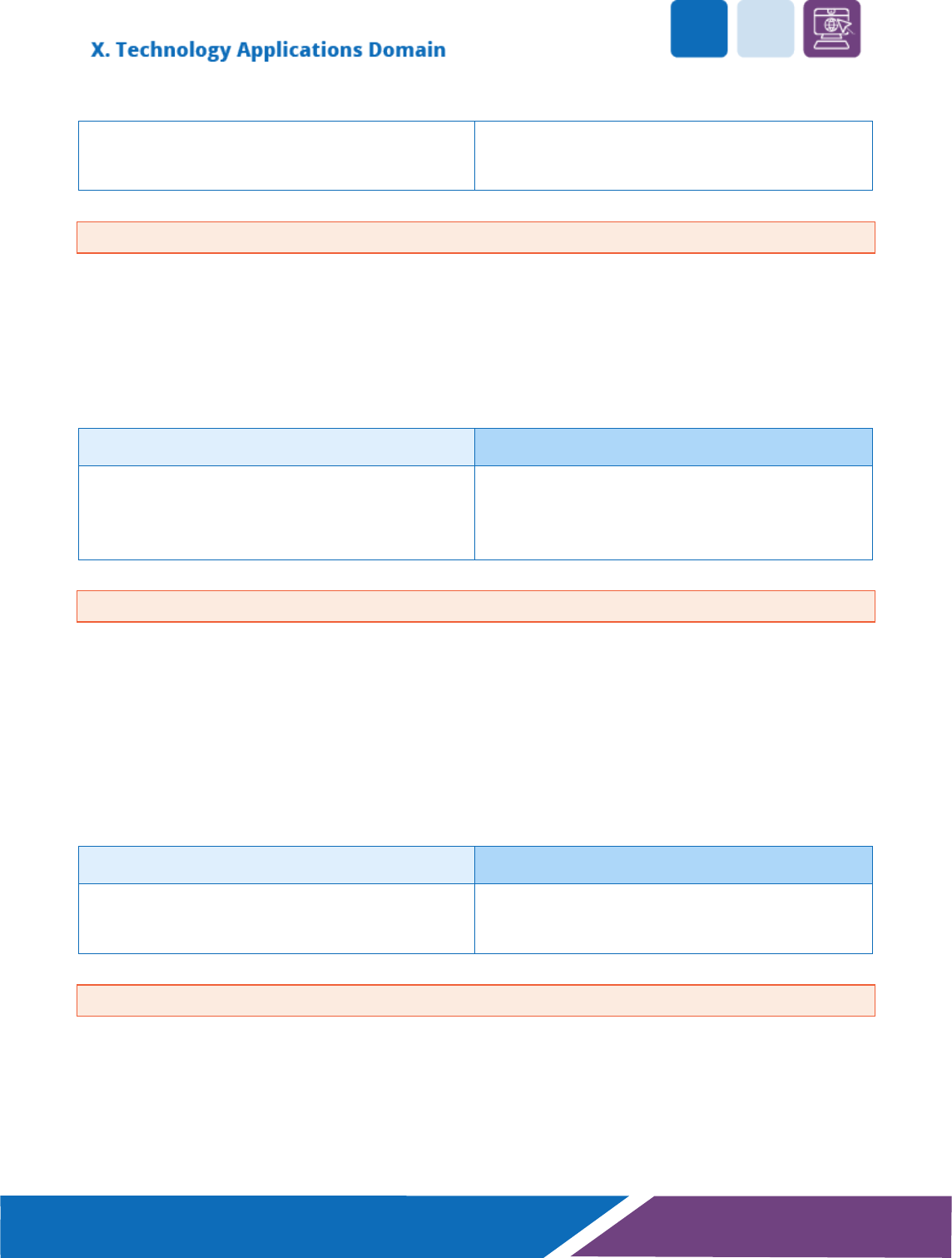
Technology 80
No PK3 outcomes for this domain of learning.
PK4.X.A.2 Child uses and names a variety of digital
tools that support and enhance learning.
Child Behaviors
The child may:
• explore and operate touchscreens, mouse, and computer keyboard to access educational
applications and websites
• use technical terminology associated with working with digital devices (e.g., click, swipe, tap,
etc.)
PK3 Outcome PK4 Outcome
No PK3 outcomes for this domain of learning.
PK4.X.A.3 Child uses digital learning applications to
contribute to class-made digital products that
express own ideas, as appropriate.
Child Behaviors
The child may:
• use digital tools or apps to draw and write
• use a variety of digital tools with audio, video, and graphics to capture original creations and add
it to a digital portfolio (e.g., photos of block buildings or artwork, recording of dramatic play,
etc.)
• explore digital storytelling by co-creating digital books with adult support (e.g., child chooses
photos or takes pictures of drawings to add to a story and records voice narrating the story)
PK3 Outcome PK4 Outcome
No PK3 outcomes for this domain of learning.
PK4.X.A.4 Child uses technology to access
appropriate information, with adult assistance.
Child Behaviors
The child may:
• use technology to learn new information (e.g., listens to a book or watches a video to learn
about animals, participates in a virtual field trip, uses voice-activated features to get a question
answered)
• interact with technology to practice recently learned skills (e.g., used in a learning app or game)
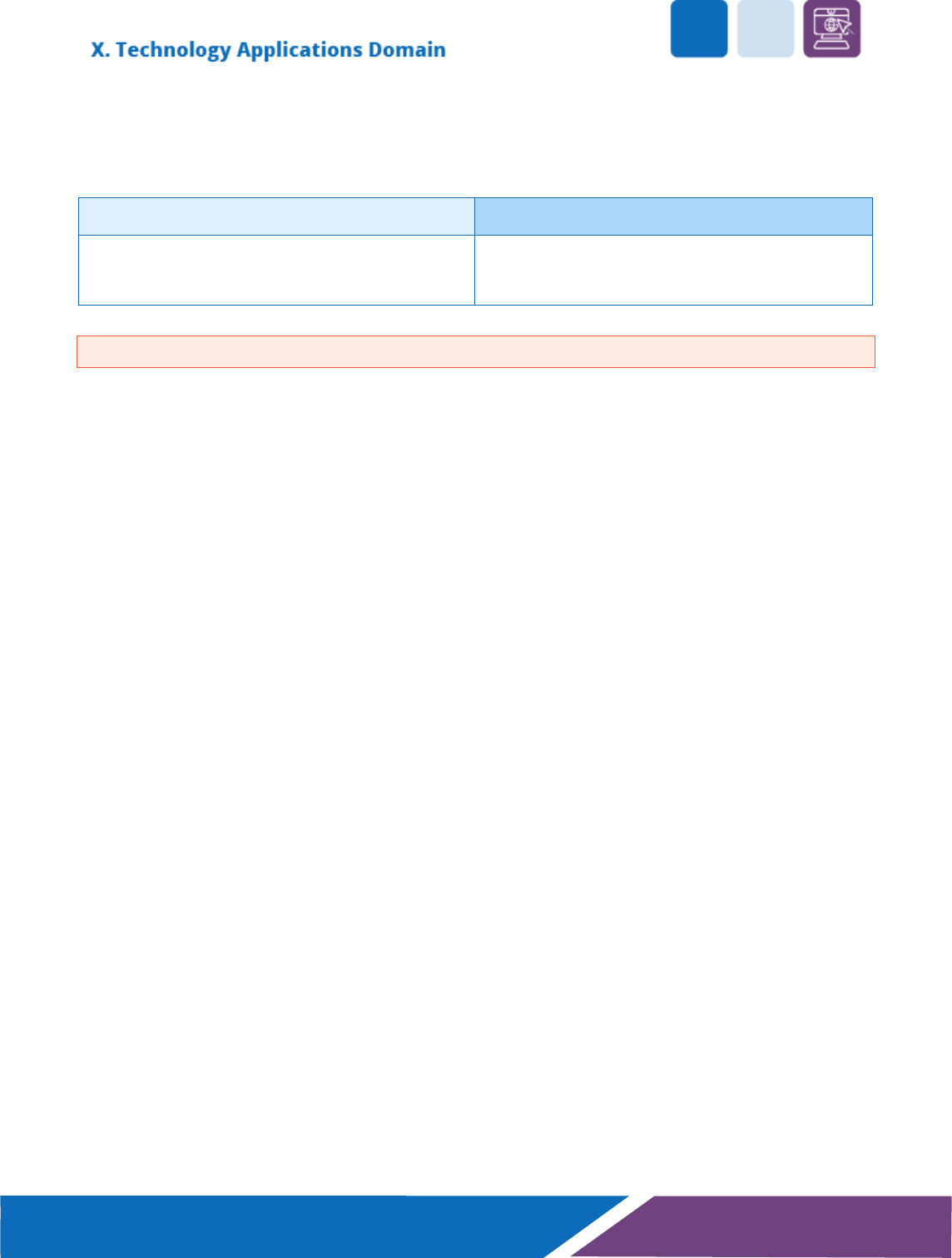
Technology 81
PK3 Outcome
PK4 Outcome
No PK3 outcomes for this domain of learning.
PK4.X.A.5 Child practices safe behavior while using
digital tools and resources.
Child Behaviors
The child may:
• follow procedures set by the teacher when using technology
• carry devices safely across the room (e.g., using two hands)
• log out when finished to maintain privacy
• access only the approved apps or websites on a device (likely from an adult-created menu)
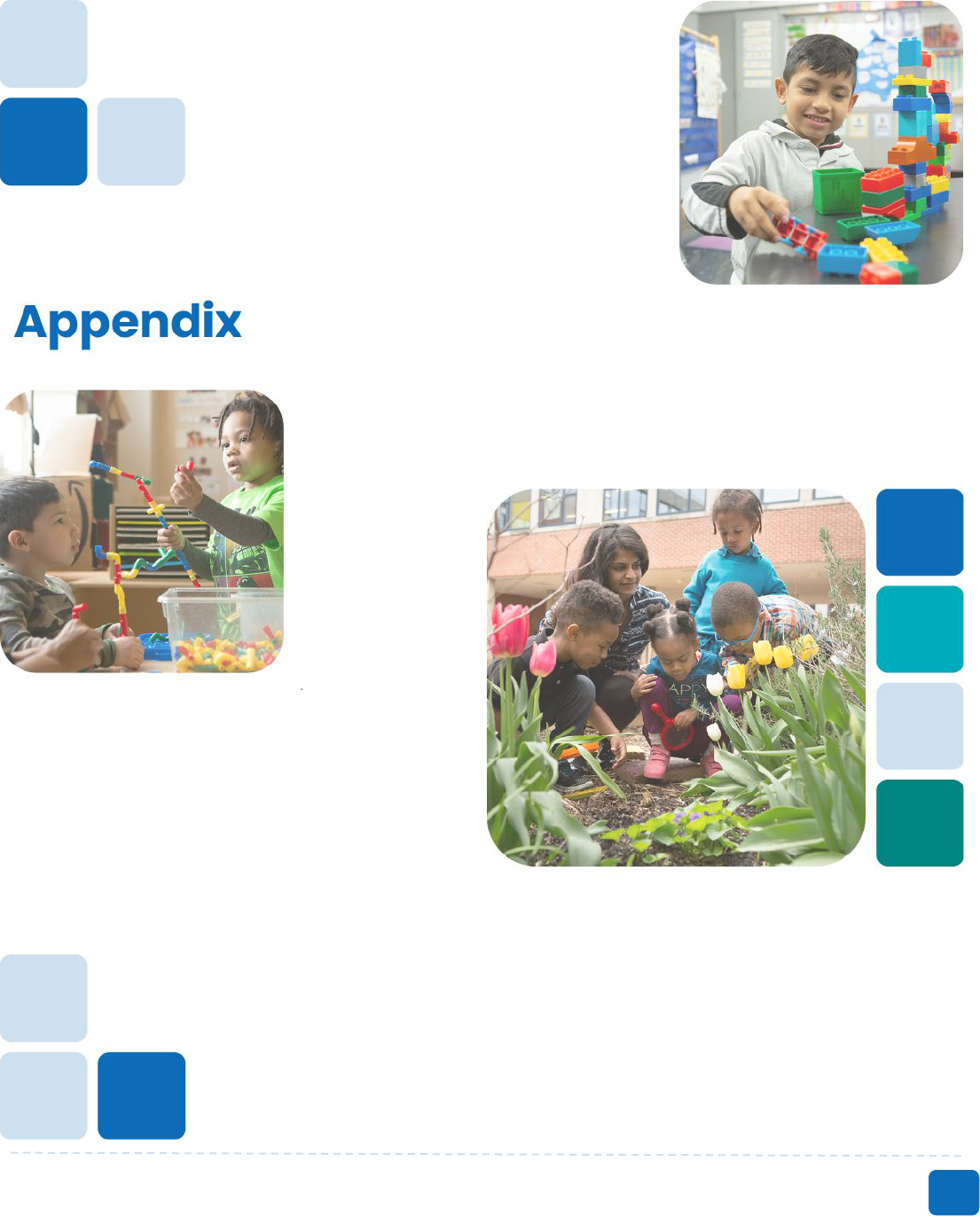
82
X
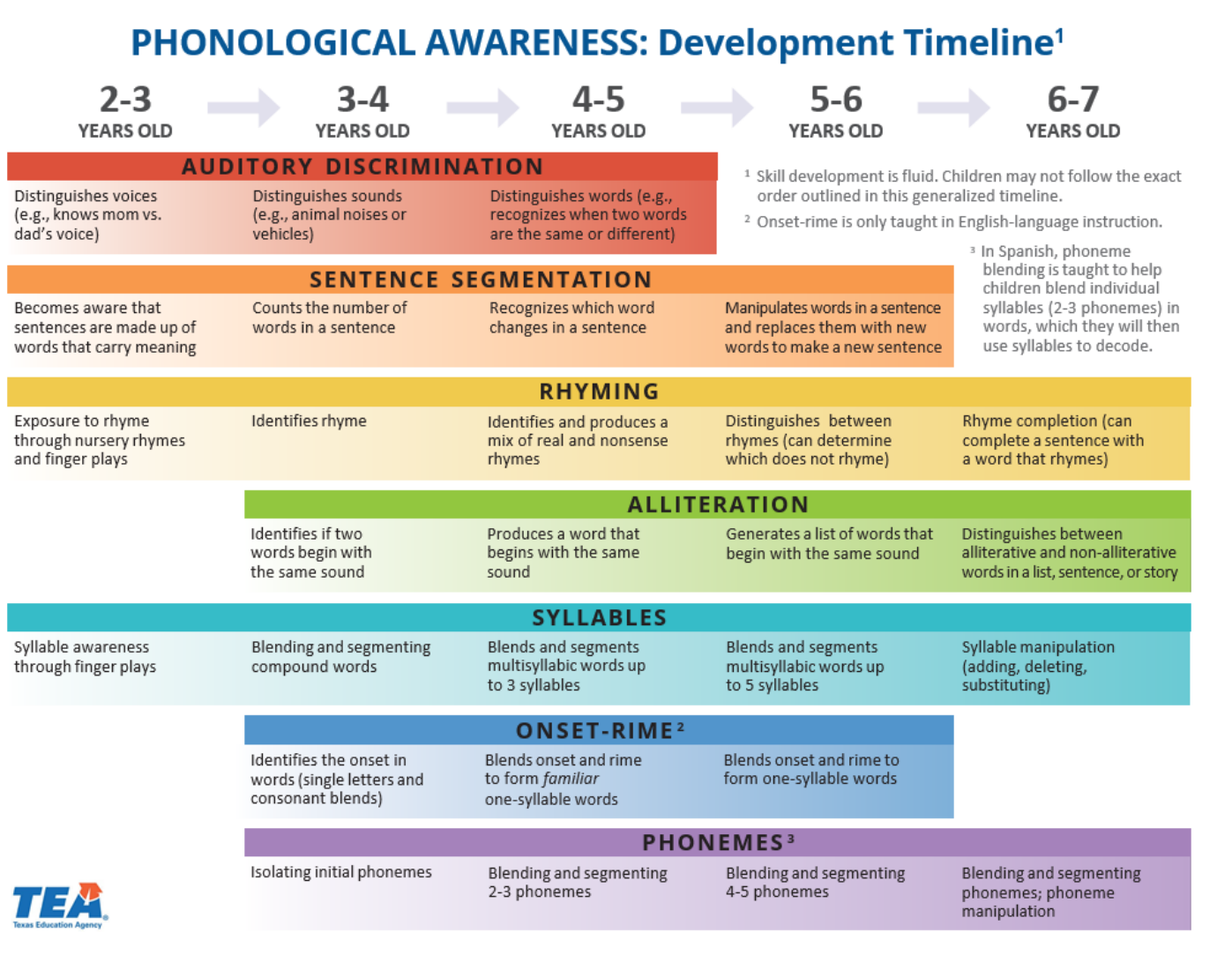
Phonological Awareness: Development Timeline
Left blank
2-3 years old
3-4 years old
4-5 years old
5-6 years old
6-7 years old
Auditory
Discrimination
Distinguish voices
(e.g., knows mom
vs. dad’s voice)
Distinguishes
sounds (e.g., animal
noises or vehicles)
Distinguishes words
(e.g., recognizes
when two words
are the same or
different)
Left blank
Left blank
Sentence
Segmentation
Becomes aware
that sentences are
made up of words
that carry meaning
Counts the number
of words in a
sentence
Recognizes which
word changes in a
sentence
Manipulates words
in a sentence and
replaces them with
new words to make
a new sentence
Left blank
Rhyming
Exposure to rhyme
through nursery
rhymes and finger
plays
Identifies rhyme
Identifies and
produces a mix of
real and nonsense
rhymes
Distinguishes
between rhymes
(can determine
which does not
rhyme)
Rhyme completion
(can complete a
sentence with a
word that rhymes)
Alliteration
Left blank
Identifies if two
words begin with
the same sound
Produces a word
that begins with
the same sound
Generates a list of
words that begin
with the same
sound
Distinguishes
between
alliterative and
non-alliterative
words in a list,
sentence, or story
Syllables
Syllable awareness
through finger
plays
Blending and
segmenting
compound words
Blends and
segments
multisyllabic words
up to 3 syllables
Blends and
segments
multisyllabic words
up to 5 syllables
Syllable
manipulation
(adding, deleting,
substituting)
Onset-Rime
Left blank
Identifies the onset
in words (single
letters and
consonant blends)
Blends onset and
rime to form
familiar one-
syllable words
Blends onset and
rime to form one-
syllable words
Left blank
Phonemes
Left blank
Isolating initial
phonemes
Blending and
Segmenting 2-3
phonemes
Blending and
segmenting 4-5
phonemes
Blending and
segmenting
phonemes;
phoneme
manipulation
Notes
• Skill development is fluid. Children may not follow the exact order outlined in this generalized timeline
• Onset-rime is only taught in English-language instruction
• In Spanish, phoneme blending is taught to help children blend individual syllables (2-3 phonemes) in words, which they will then use
syllables to decode
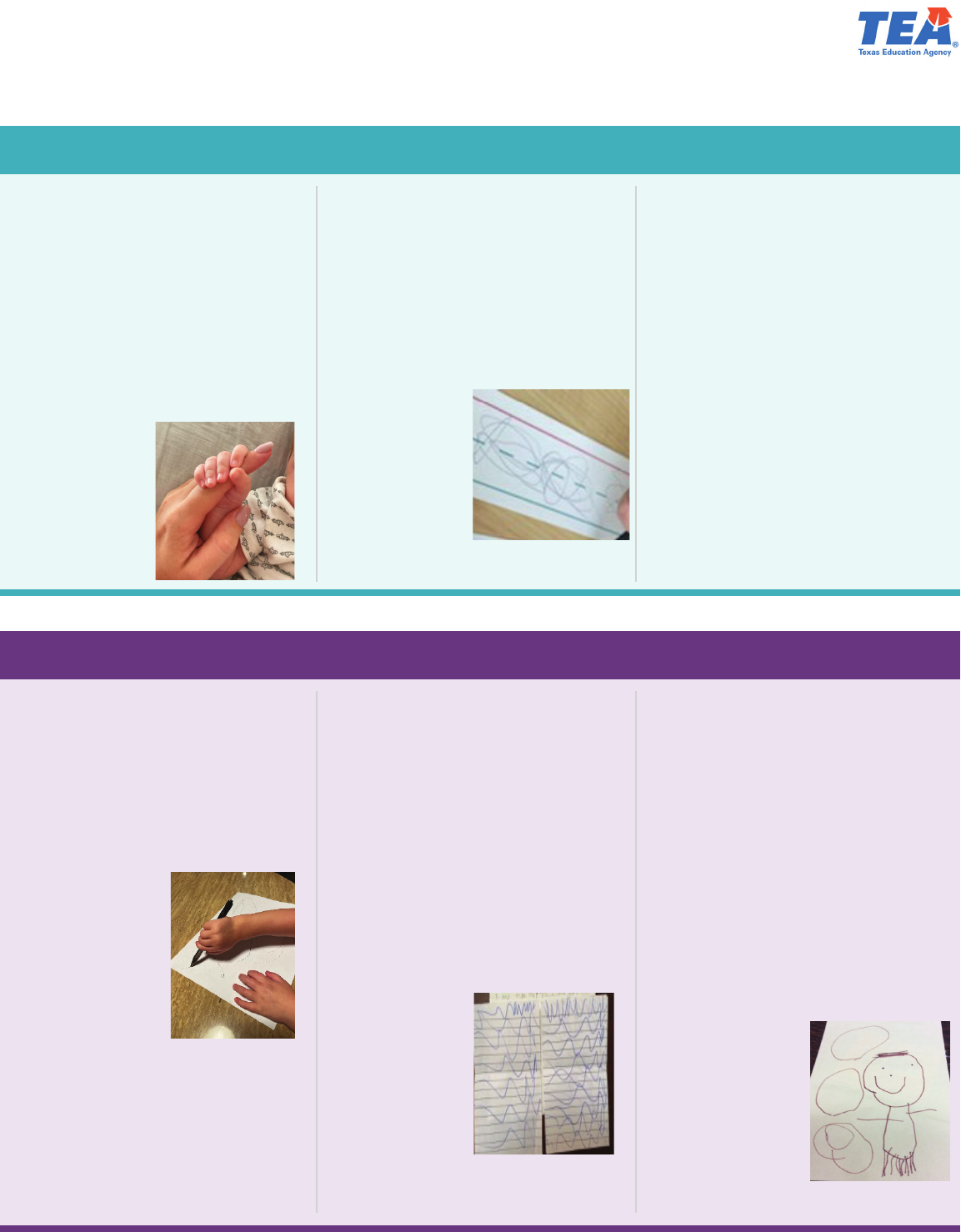
EARLY CHILDHOOD
WRITING DEVELOPMENT
Awareness Stage
GRIP
• Uses entire fist to grasp items
• Starts to explore fine motor
movements through grabbing
objects, such as hair, toys, or a
bottle, but lacks real control
and often requires adult
supports
EXAMPLE:
An infant
exploring
grasp by
gripping a
finger
FORMATION & SPELLING
• Begins to use random
scribbling—starts at any
place on the page and
includes random marks that
do not resemble print or
communicate a meaning
EXAMPLE:
Basic scribbles
COMPOSITION
• Begins to understand, through
interactions with text and
talk, the connection between
spoken and written language
(i.e., recognizes that written
language communicates ideas,
stories, and facts)
• Starts to recognize
environmental print
• Uses a variety of writing tools
to share messages
Pre-literate Stage
GRIP
• Attempts to mimic adults by
grasping various tools (crayons,
markers, Q-tips, clothespins,
paintbrushes, etc.) with four
fingers pointed toward palm
EXAMPLE:
A four-finger
grip
FORMATION & SPELLING
• Scribbles to imitate adult
writing
• Improves fine motor skills
by developing hand and
finger strength, resulting
in controlled scribbling—
repeated marks on a page
(e.g., open circle, diagonals,
straight or curved lines, wavy
lines written across the page).
EXAMPLE:
A To Do List
(and the
scripted
meaning)
COMPOSITION
• Uses single drawings to
represent written stories
• Believes that drawings and
scribbles communicate a
purposeful message
• Reads their drawings as if
there were words on them
• Tells teacher or peers what
a picture represents which
may change with repeated
explanations
EXAMPLE:
Yo puedo patear
un balón de
fútbol con mis
pies.
“I can kick a
soccer ball with
my feet.”
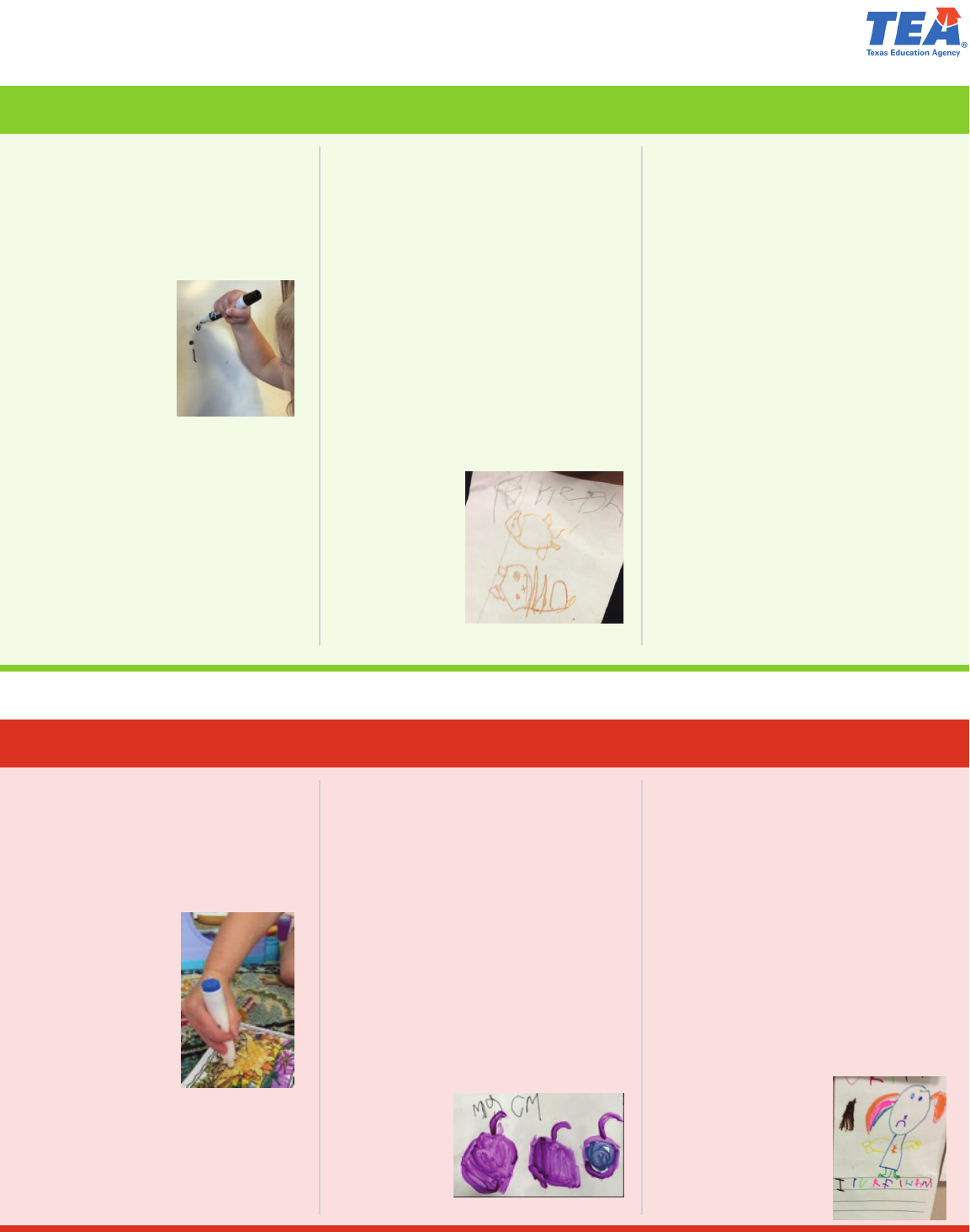
EARLY CHILDHOOD WRITING DEVELOPMENT
(page 2 of 4)
Early Emergent Stage
GRIP
• Attempts five-finger grip
including a grasp with index
finger and thumb
EXAMPLE:
A five-finger grip
FORMATION & SPELLING
• Scribbles begin to indicate the
child’s understanding of basic
writing conventions - left to
right, top to bottom
• Makes letter-like forms and
shapes, or individual letters, to
represent words
• Attempts to write name
• Copies letters and words from
environmental print
EXAMPLE:
Scribbles
with letter-
like forms
COMPOSITION
• Uses drawings across several
pages to represent a clear
message
• Includes story elements into
drawings (e.g., character names,
setting) to represent a story
• Adds meaningful labels to
illustrations demonstrating the
understanding that written
words add meaning and context
• Shares meaning of pictures
and labels with teachers and
peers with consistency
• Starts to build awareness that
messages (stories or individual
pictures) need to make sense
and will revise drawings and/or
labels to make it happen
Emergent Stage
GRIP
• Uses stac three-finger grip
and whole arm movement to
form letters (lacks control)
EXAMPLE:
A stac three-
finger grip, that
uses the whole
arm to make
marks on the
paper (and limits
control)
FORMATION & SPELLING
• Strings random letters together
in an attempt to create words
• Includes both upper and
lowercase letters randomly
• Continues to develop
conventions of writing - writes
across the page, adds spaces
to represent each word within
a sentence
EXAMPLE:
Mi comida
“My food”
COMPOSITION
• Develops stories with a
beginning and an ending,
represented by drawings and
corresponding phrases
• Continues to develop
awareness that written stories
follow a logical sequence
• Revises drawings and writings
to ensure their message is
clear to their audience
EXAMPLE:
A story about a
student’s feelings
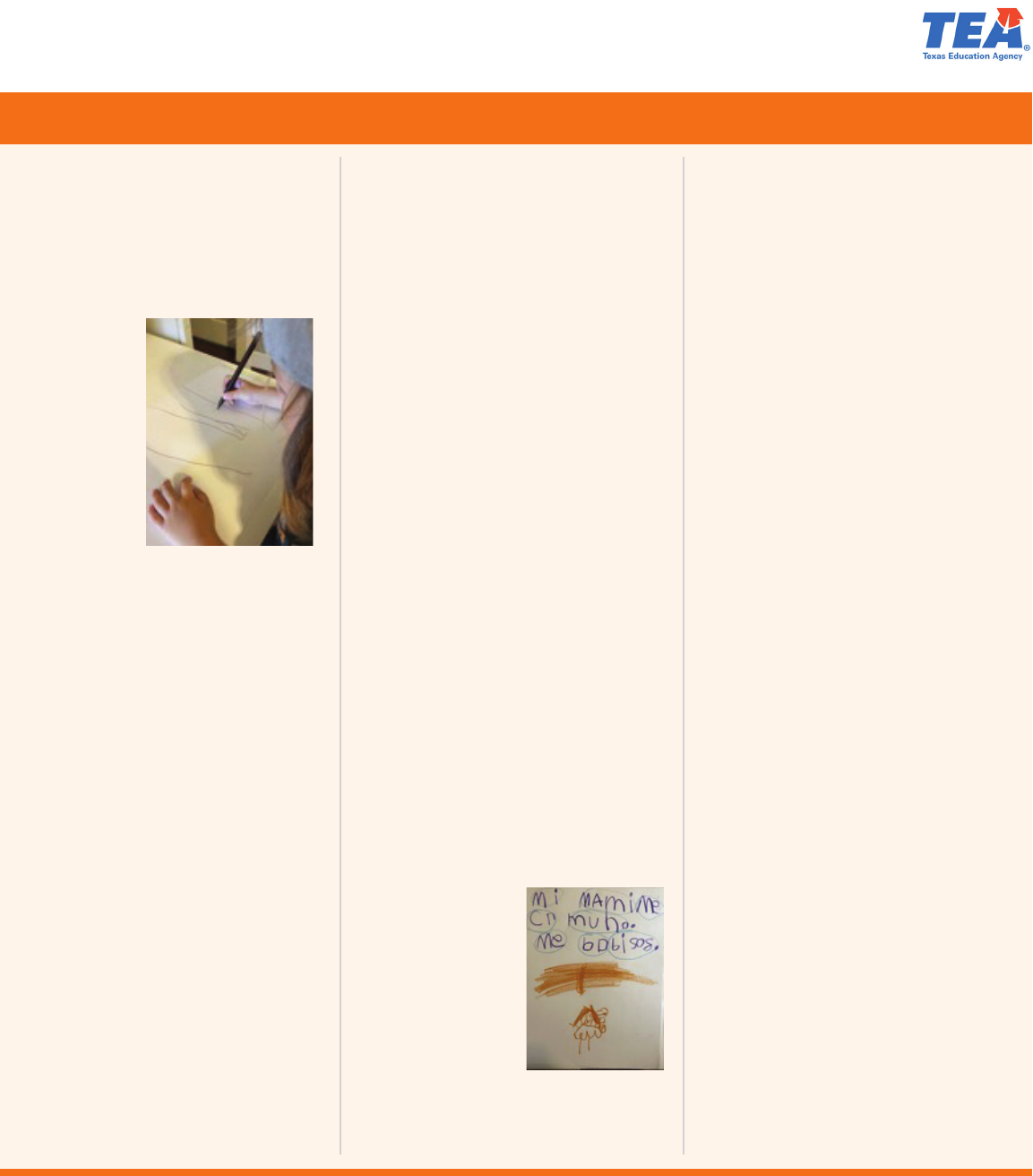
EARLY CHILDHOOD WRITING DEVELOPMENT
(page 3 of 4)
Transitional Stage
GRIP
• Uses dynamic three-finger grip
resulting in more control as
movement originates from the
wrist
EXAMPLE:
A dynamic
three-
finger grip
with more
control at
wrist
FORMATION & SPELLING
• Spells words by using
letter-sound knowledge
(approximation spelling) which
may progress as follows
» Beginning and final sounds
used to represent a word
» Medial consonant sounds
are added
» Medial sounds (vowel),
even if incorrect, may be
represented
» All sounds are represented
even if inaccurately spelled
» Writes known words (e.g.,
high-frequency words,
sight words)
• Spells one word several
different ways in one piece of
writing, which illustrates that
spelling is still developing (e.g.,
“like” might be spelled as “lik”
and “liek” in the same story).
• Begins to use spacing to
distinguish between words
• Adds random punctuation to
writing
EXAMPLE:
A writing sample
that includes a
mix of
approximated
spelling and
words from the
word wall to
convey meaning
*The circled words represent that
the child understands individual
words make up a sentence.*
COMPOSITION
• Begins to convey messages
more through written text than
illustrations
• Writes sentences that
correspond with each of the
drawings in their stories
• Composes clear messages with
meaning and context for a
specific audience
• Includes a beginning, middle,
and end when writing stories
• Begins to model compositions
after familiar authors
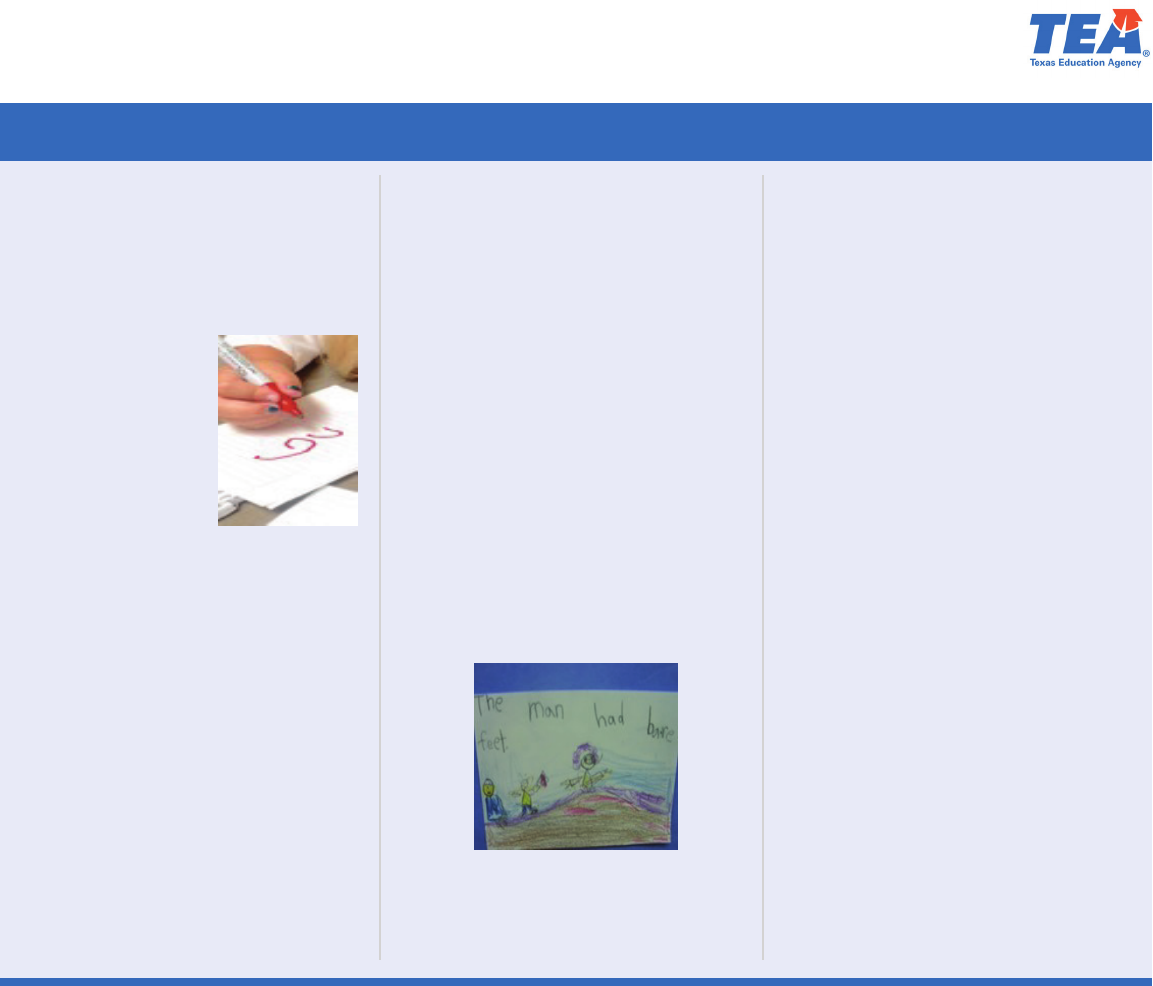
EARLY CHILDHOOD WRITING DEVELOPMENT
(page 4 of 4)
Conventional Stage
GRIP
• Continues to develop control
and personal style using a
dynamic three-finger grip
EXAMPLE:
A developed
three-finger grip
FORMATION & SPELLING
• Begins phrase writing
• Writes complete sentences
• Uses correct capitalization and
punctuation more often
• Increasingly writes with
conventional spelling
and fewer instances of
approximation spelling
EXAMPLE:
A writing sample that includes
accurate use of capitalization and
punctuation, with conventional
spelling
COMPOSITION
• Writes sentences of varying
lengths and structures to add
coherence around a central
topic or theme
• Consistently conveys messages
through written text versus
illustrations
• Uses writing to express
personal ideas, thoughts,
understandings, and learning
• Recognizes and imitates
various genres of writing
• Uses mentor texts to develop
composition skills and
creativity in writing
• Writes for a variety of
purposes, accurately using
various features of writing
(e.g., begins letters with
“Dear,” or “Esmado:”; begins
writing fairy tales with “Había
una vez”; makes lists with
numbered lines or bullets)
